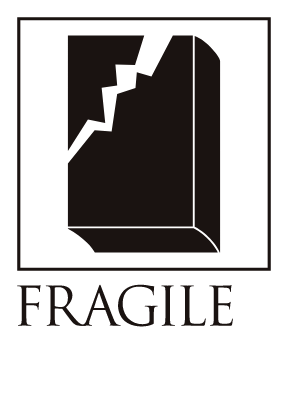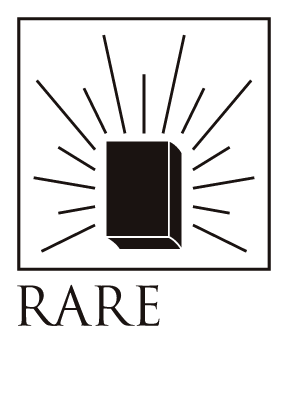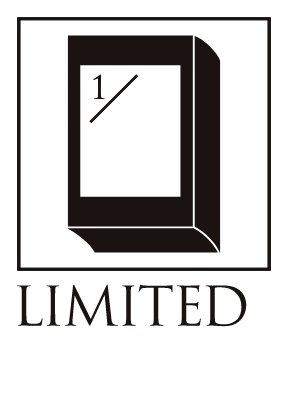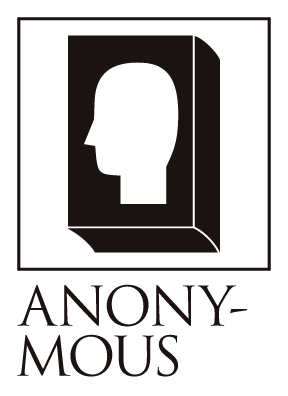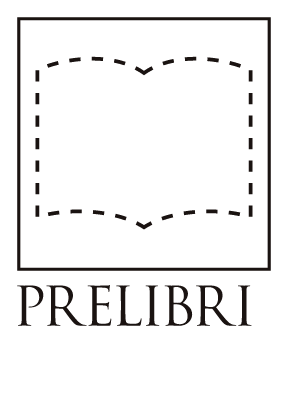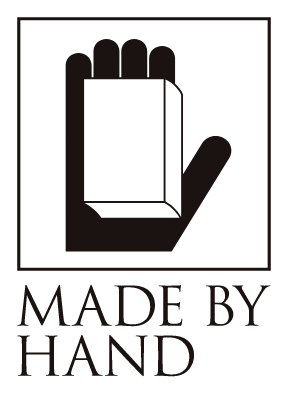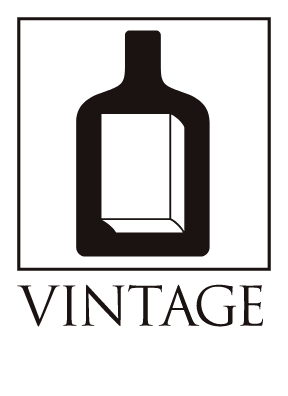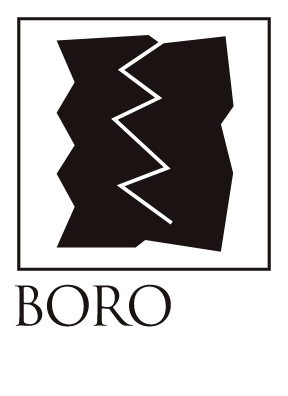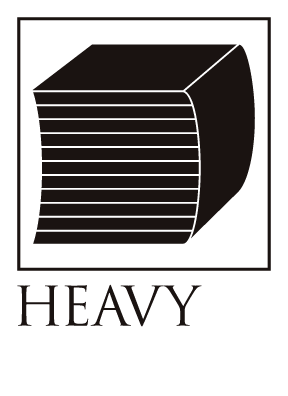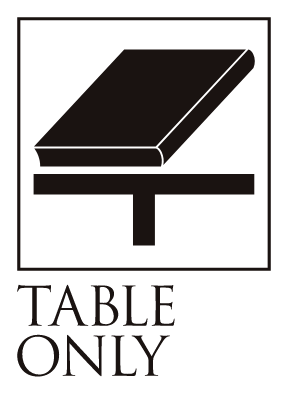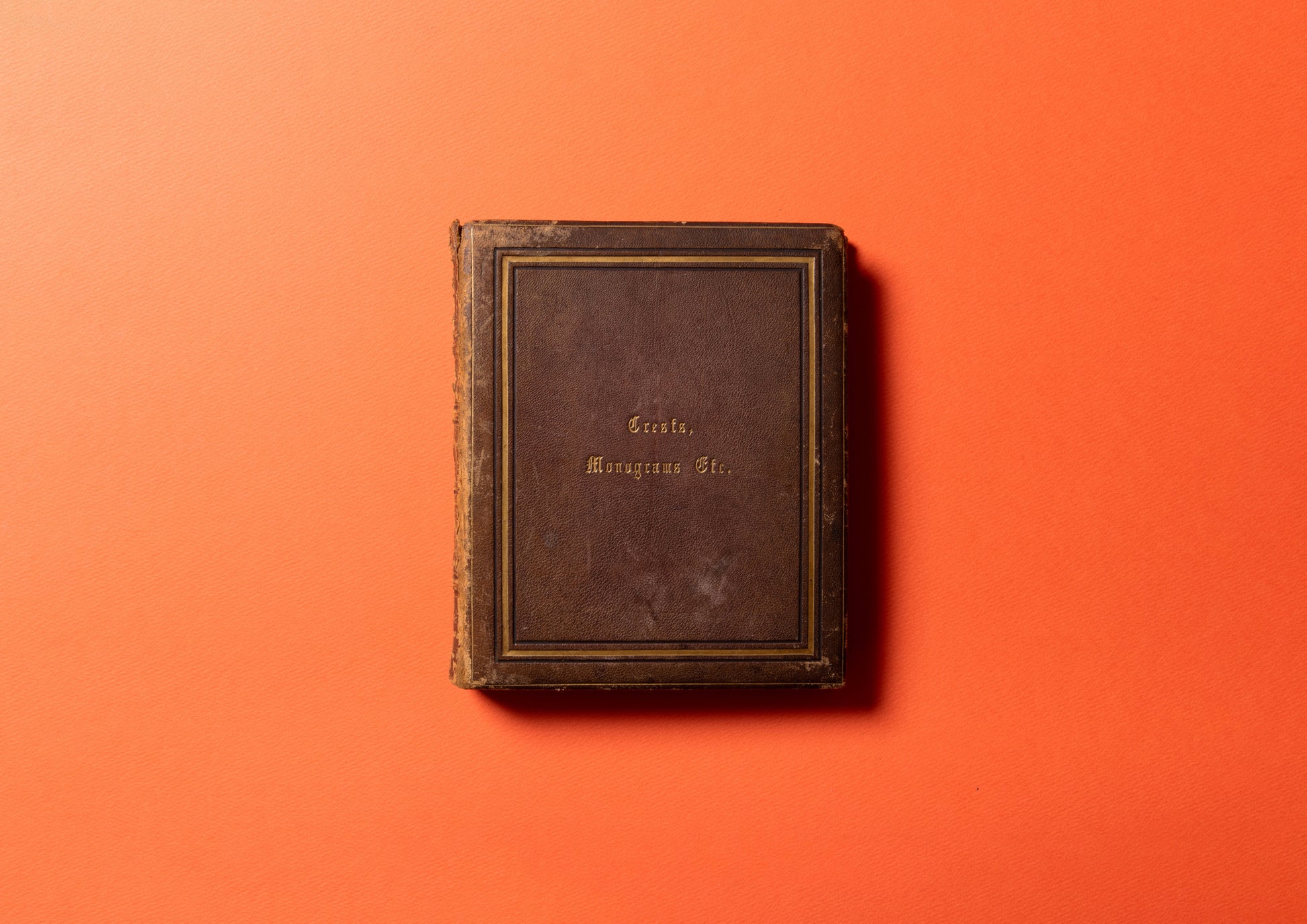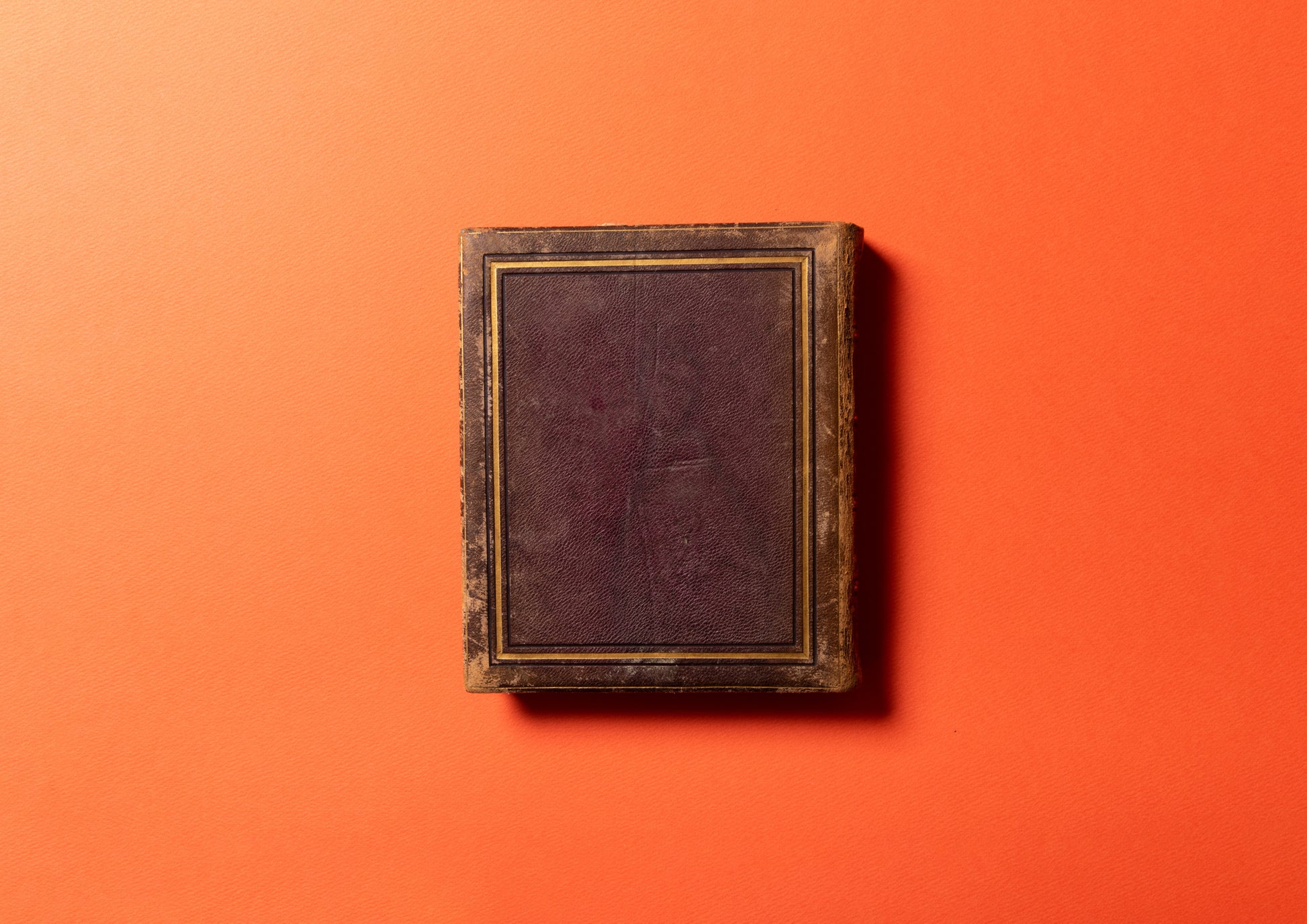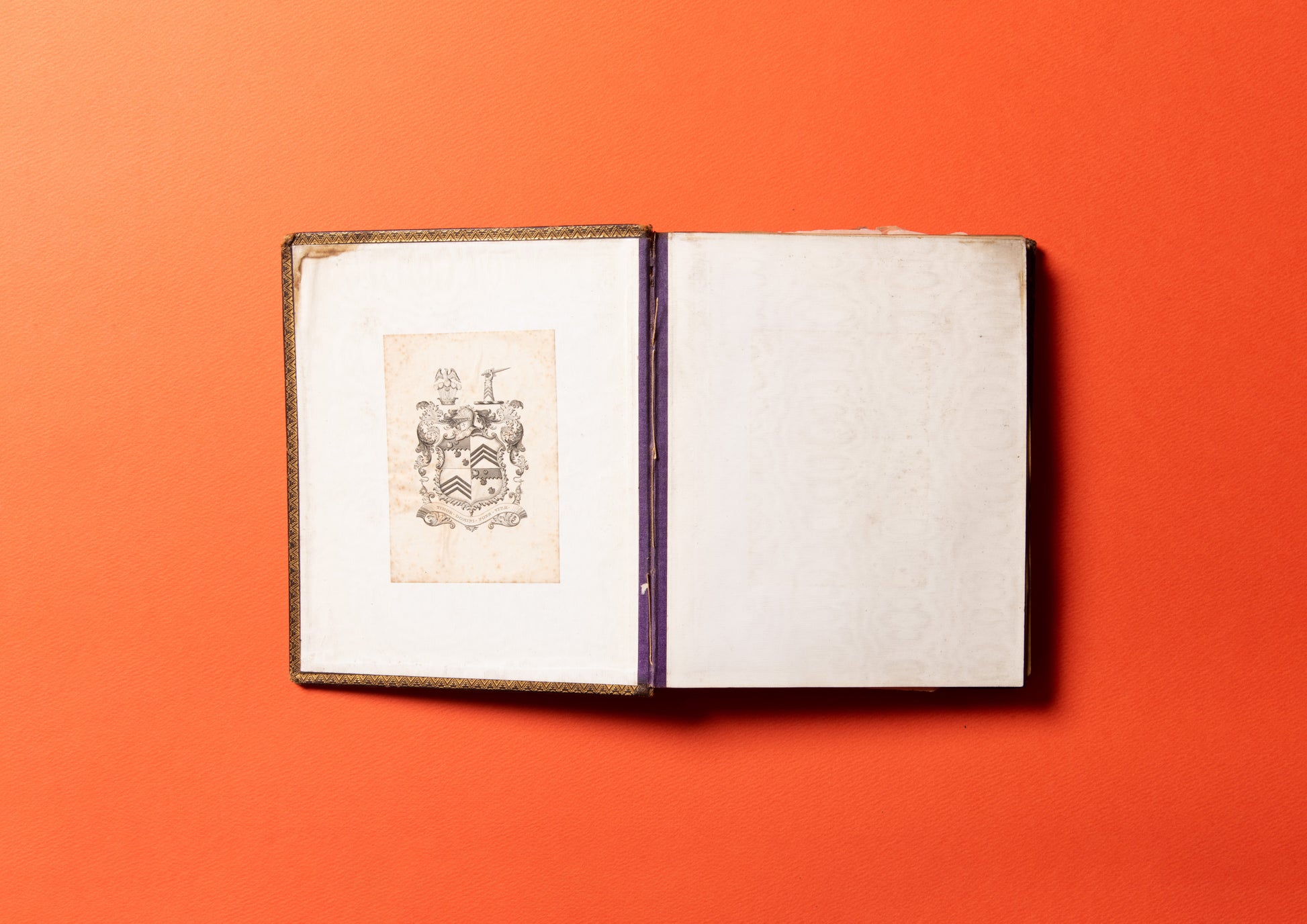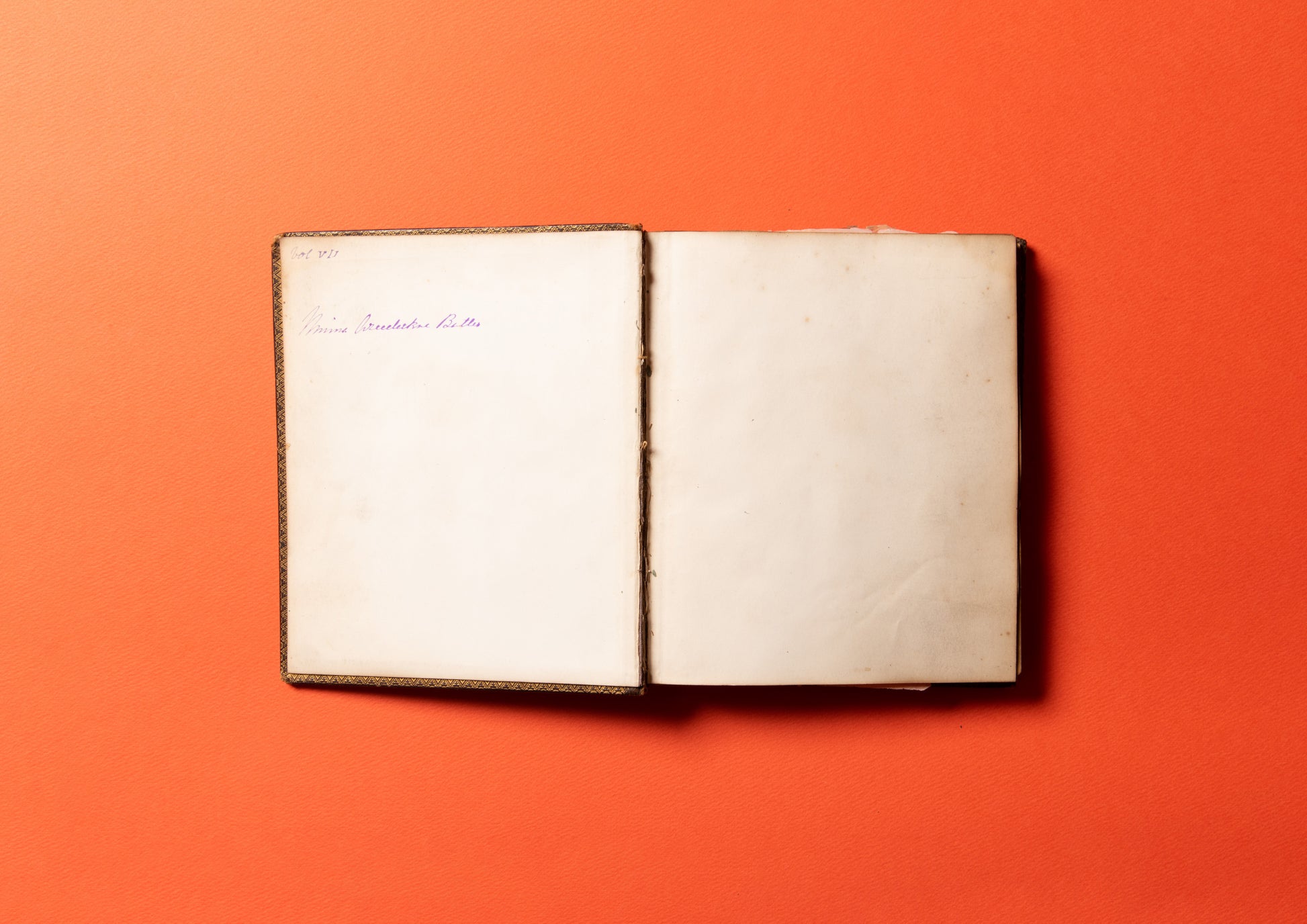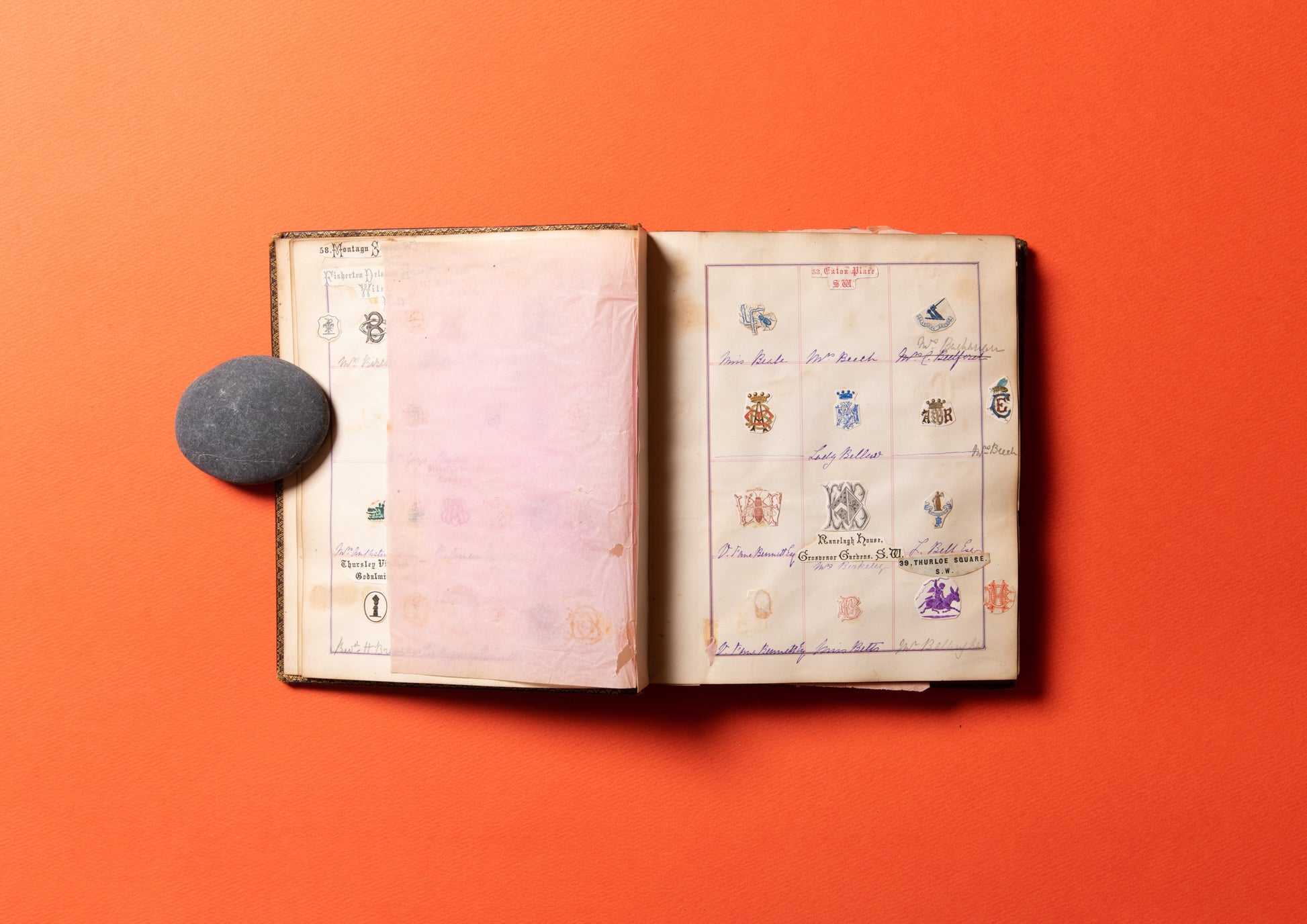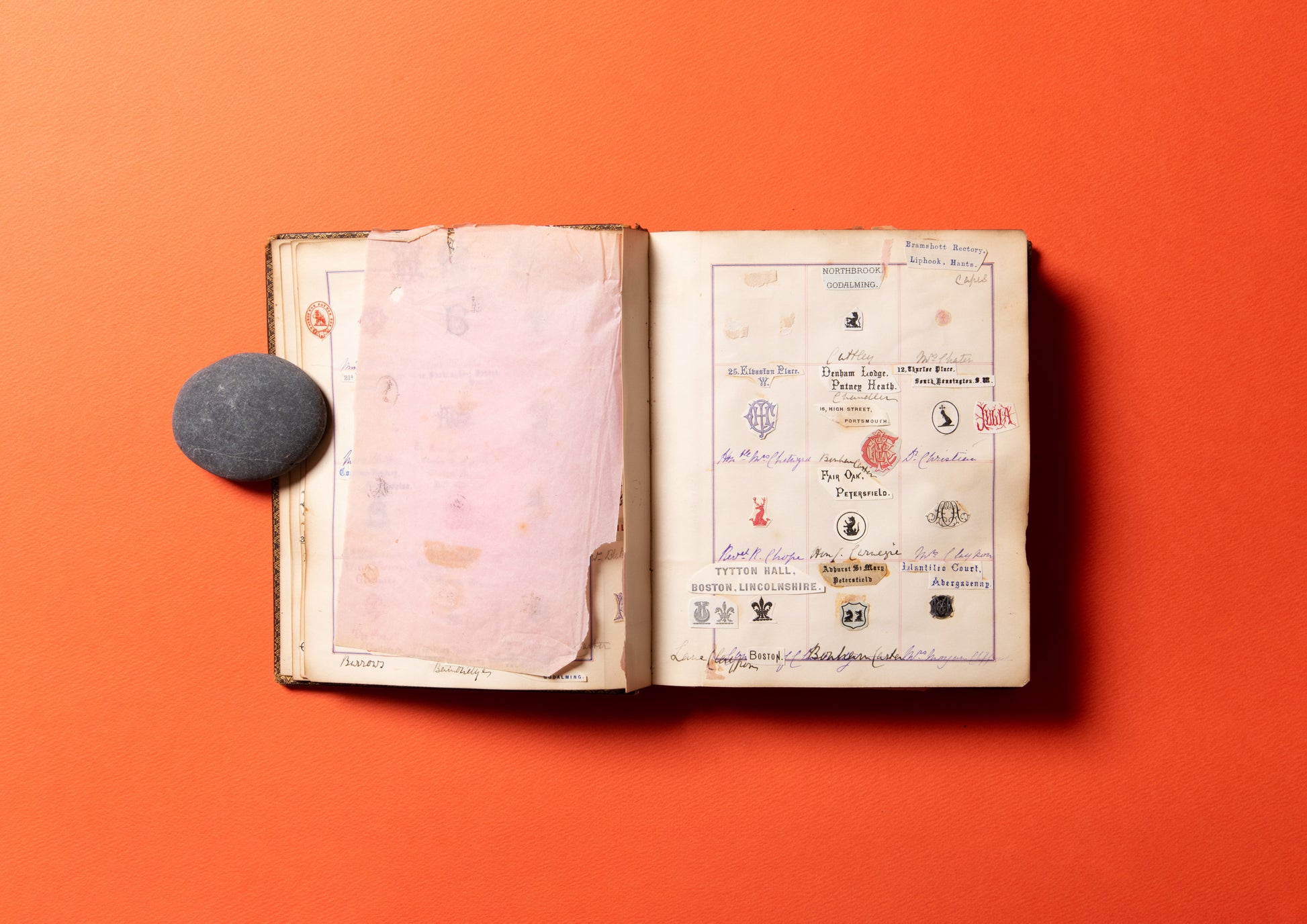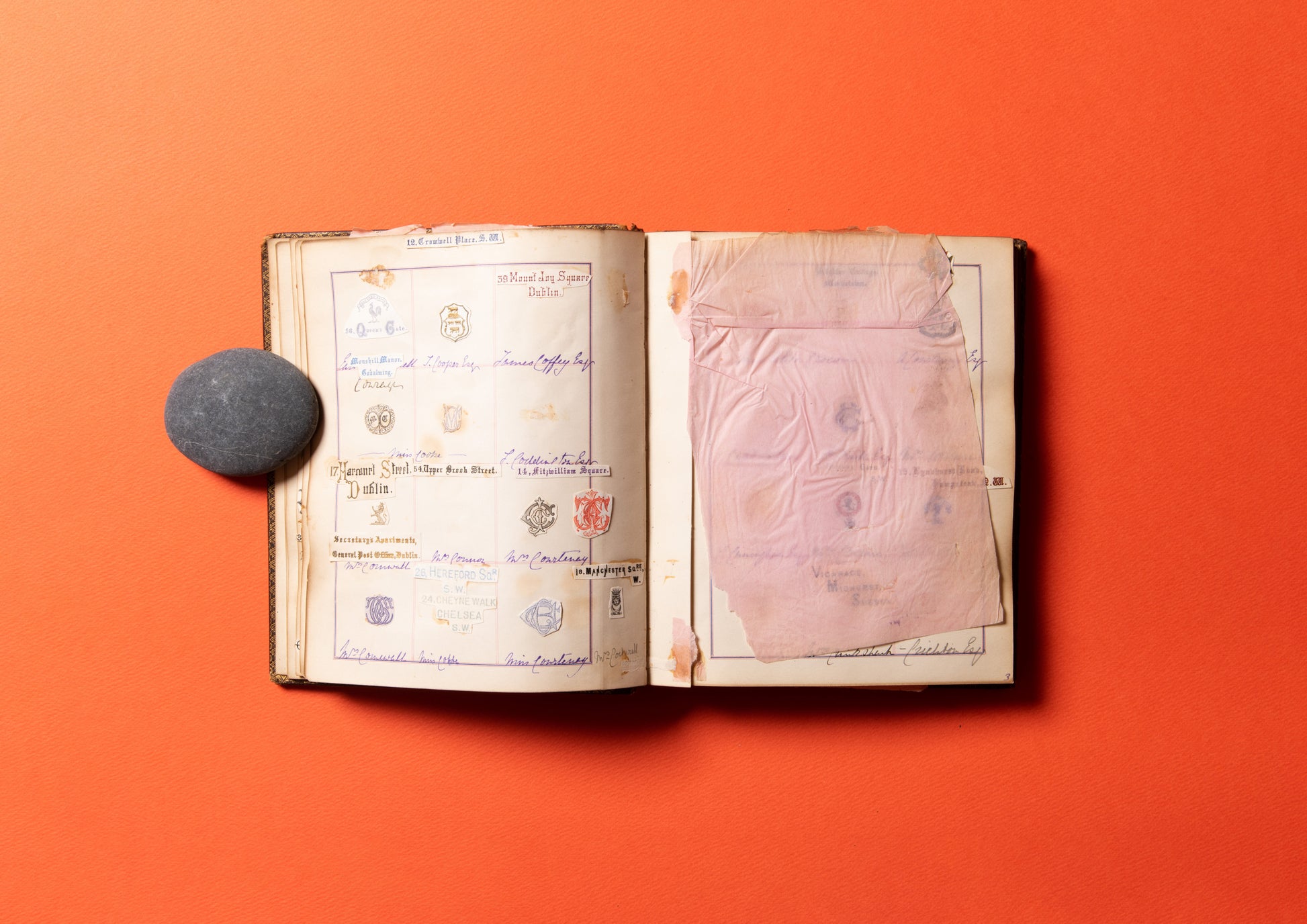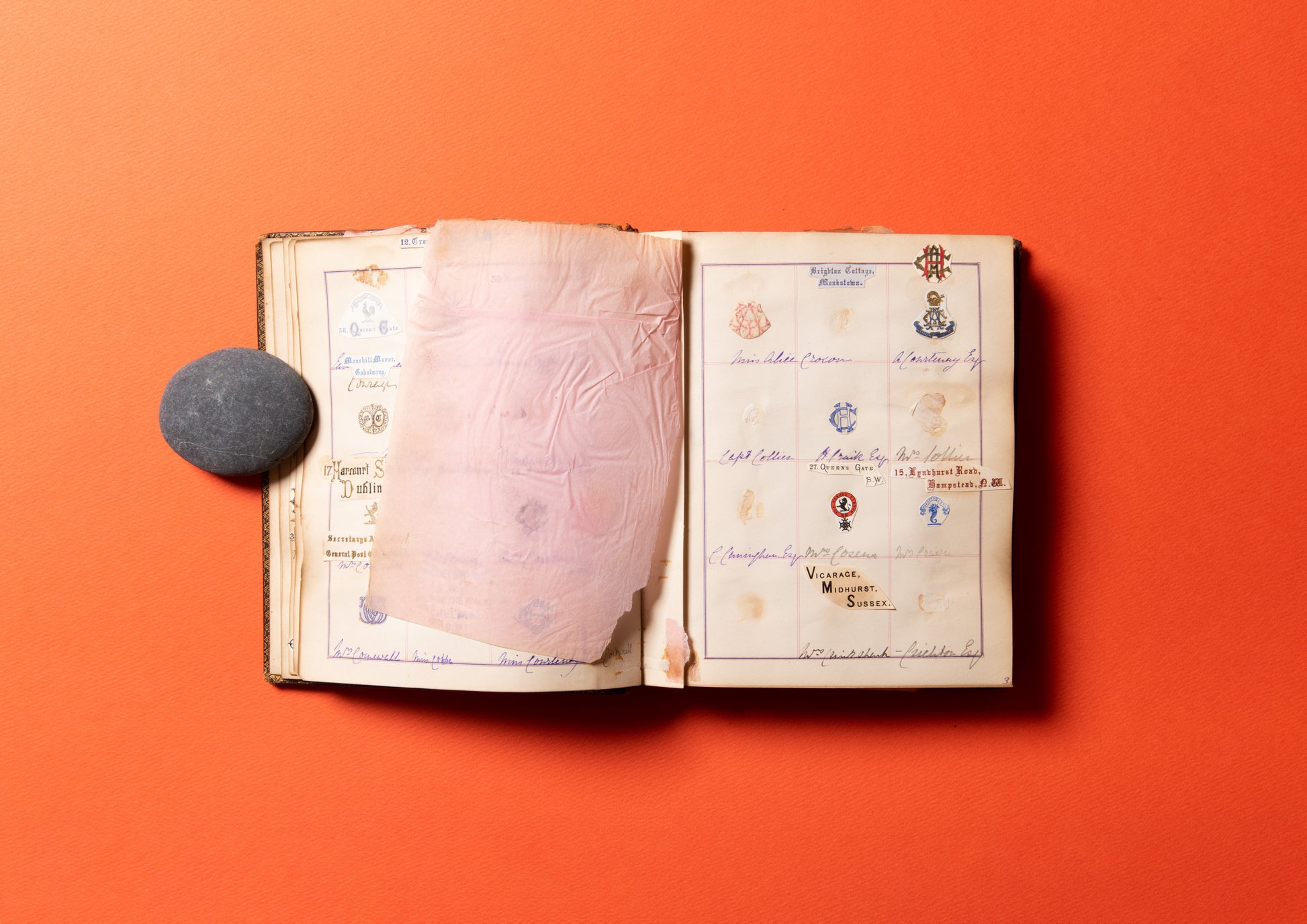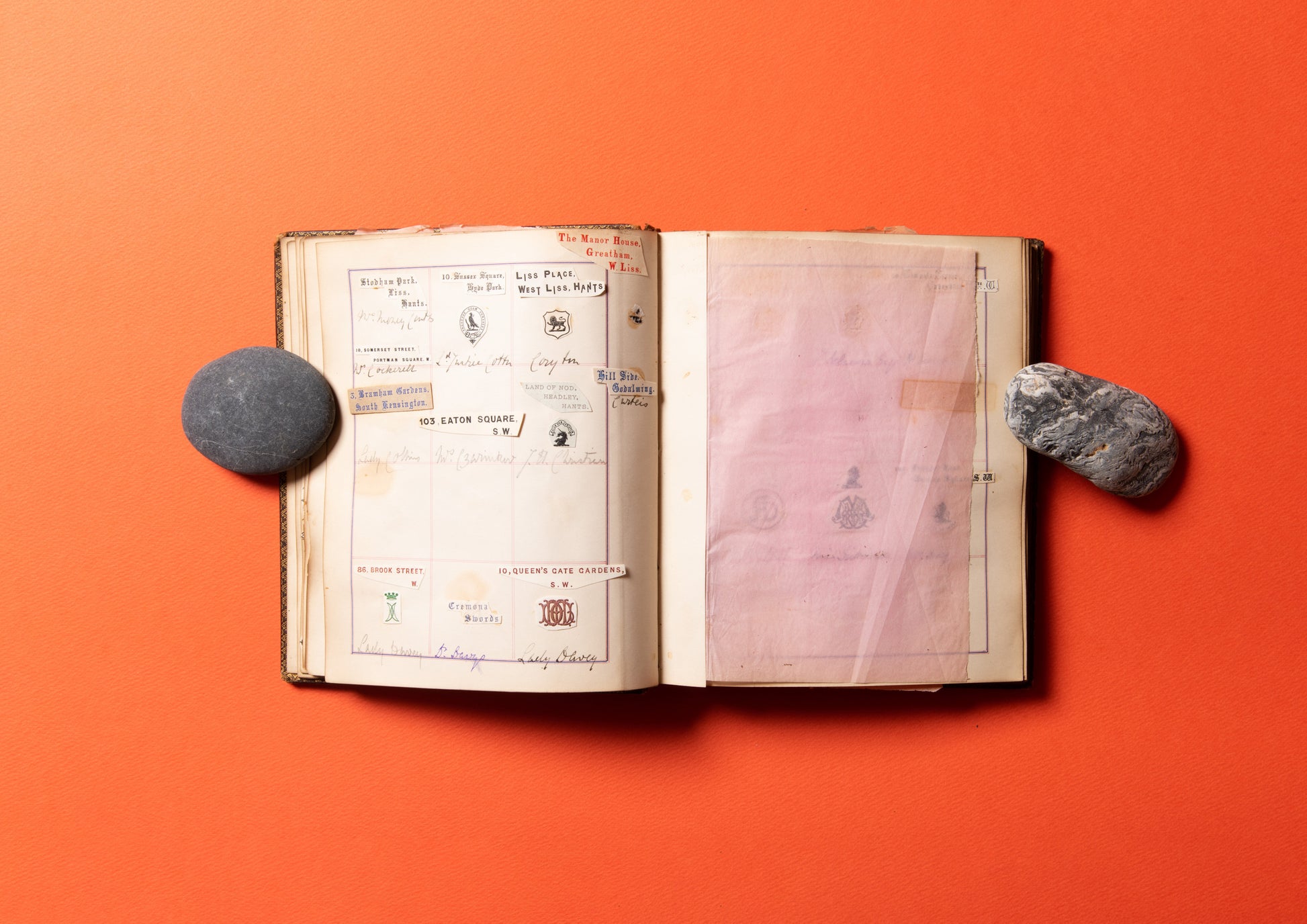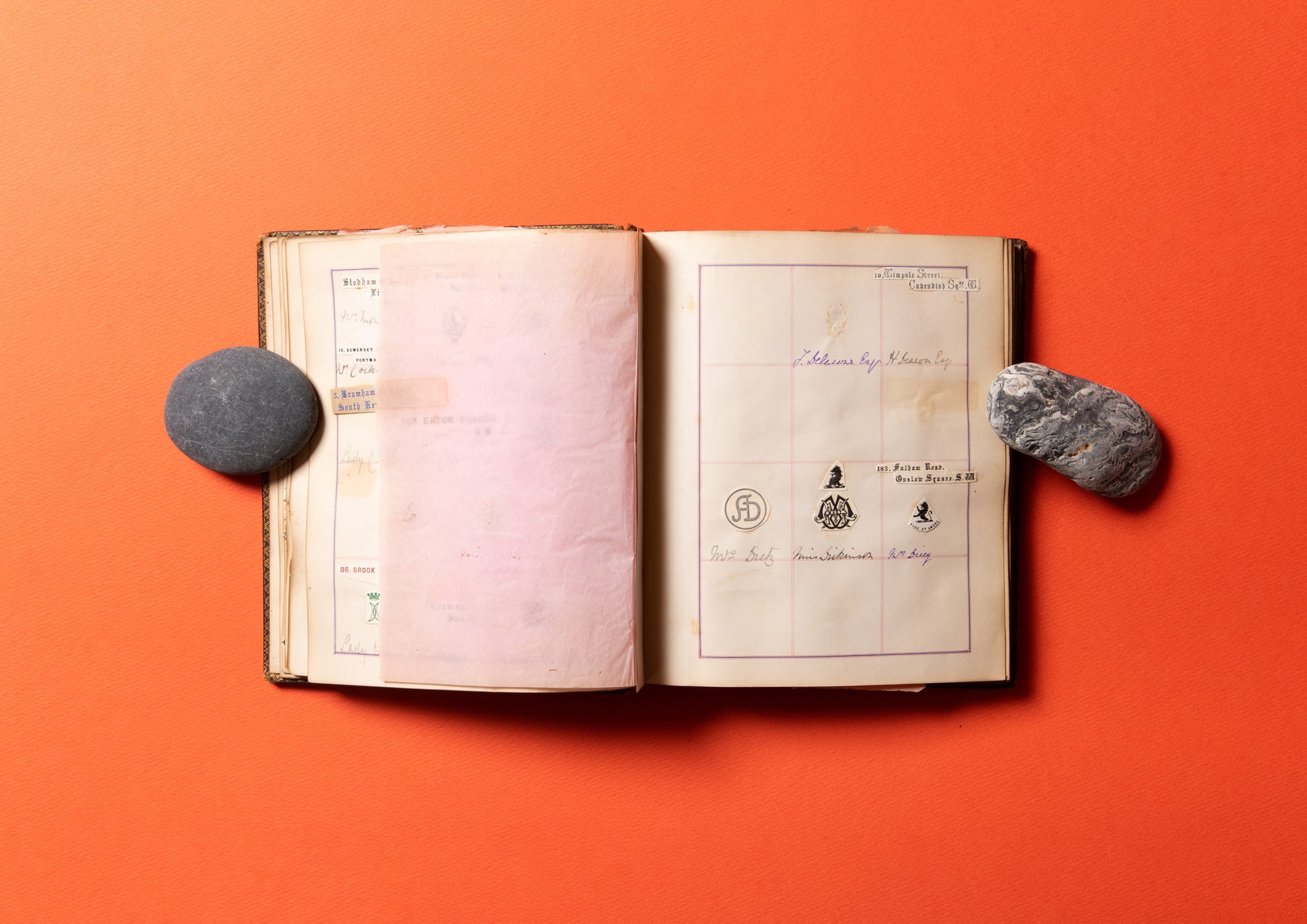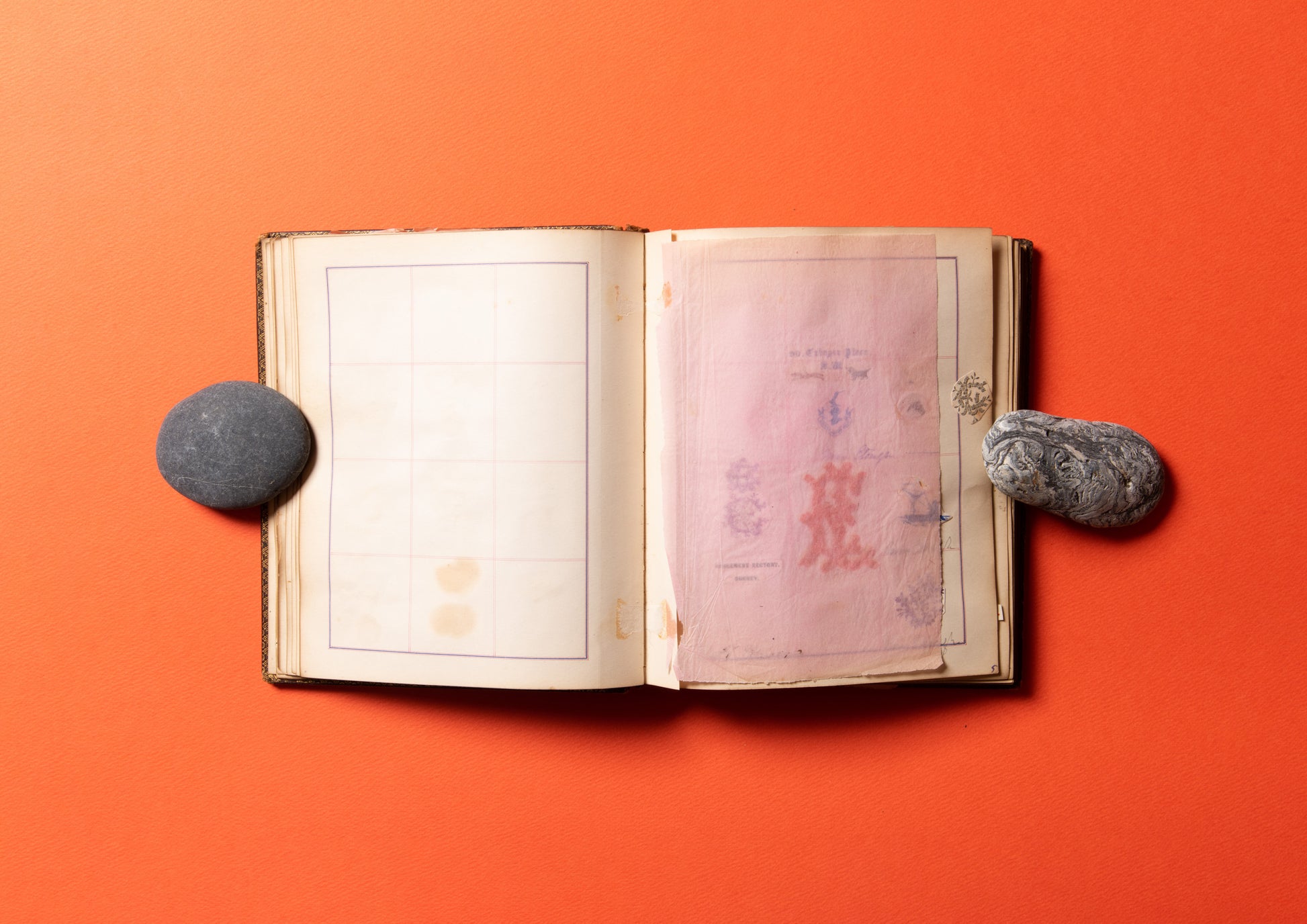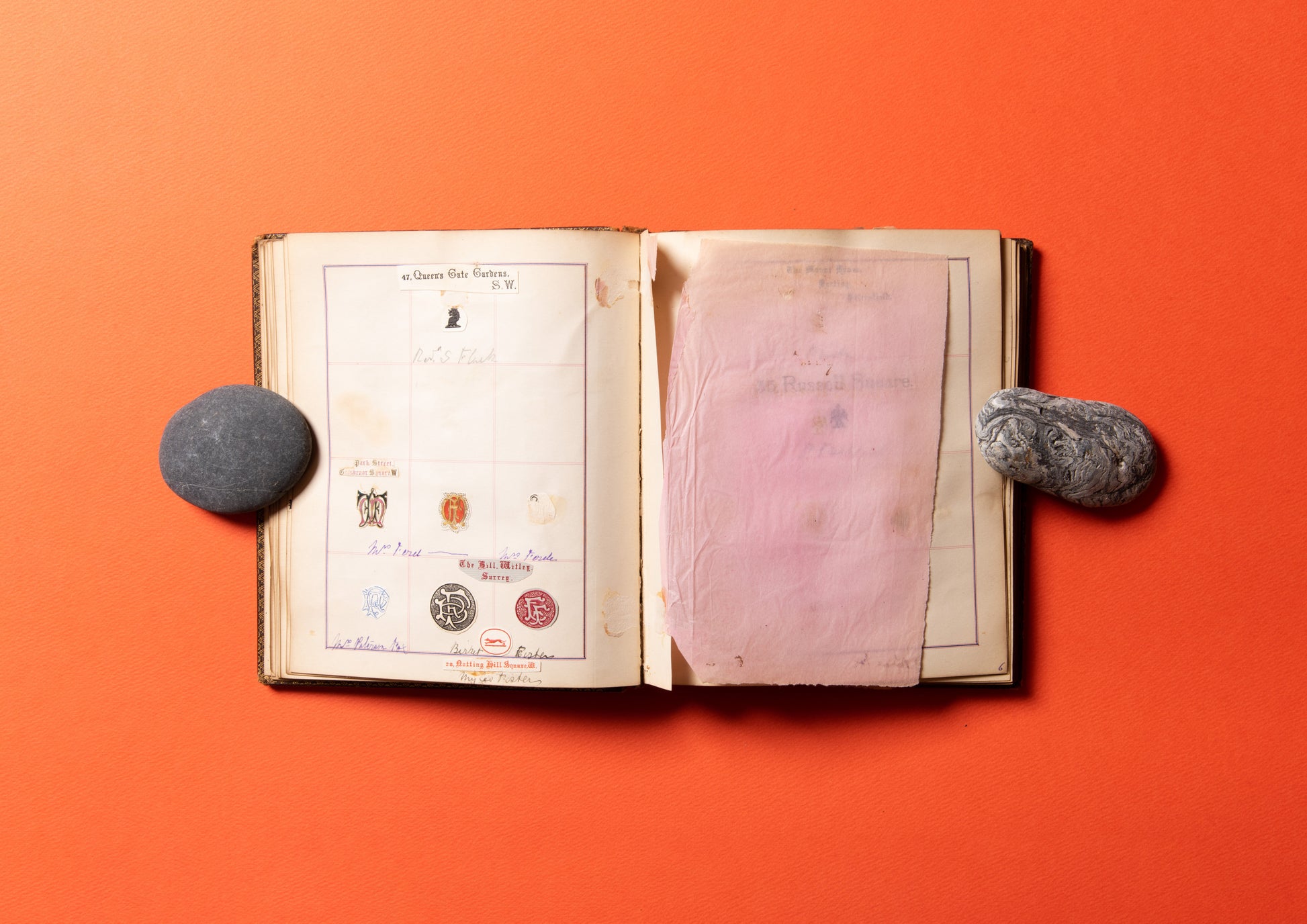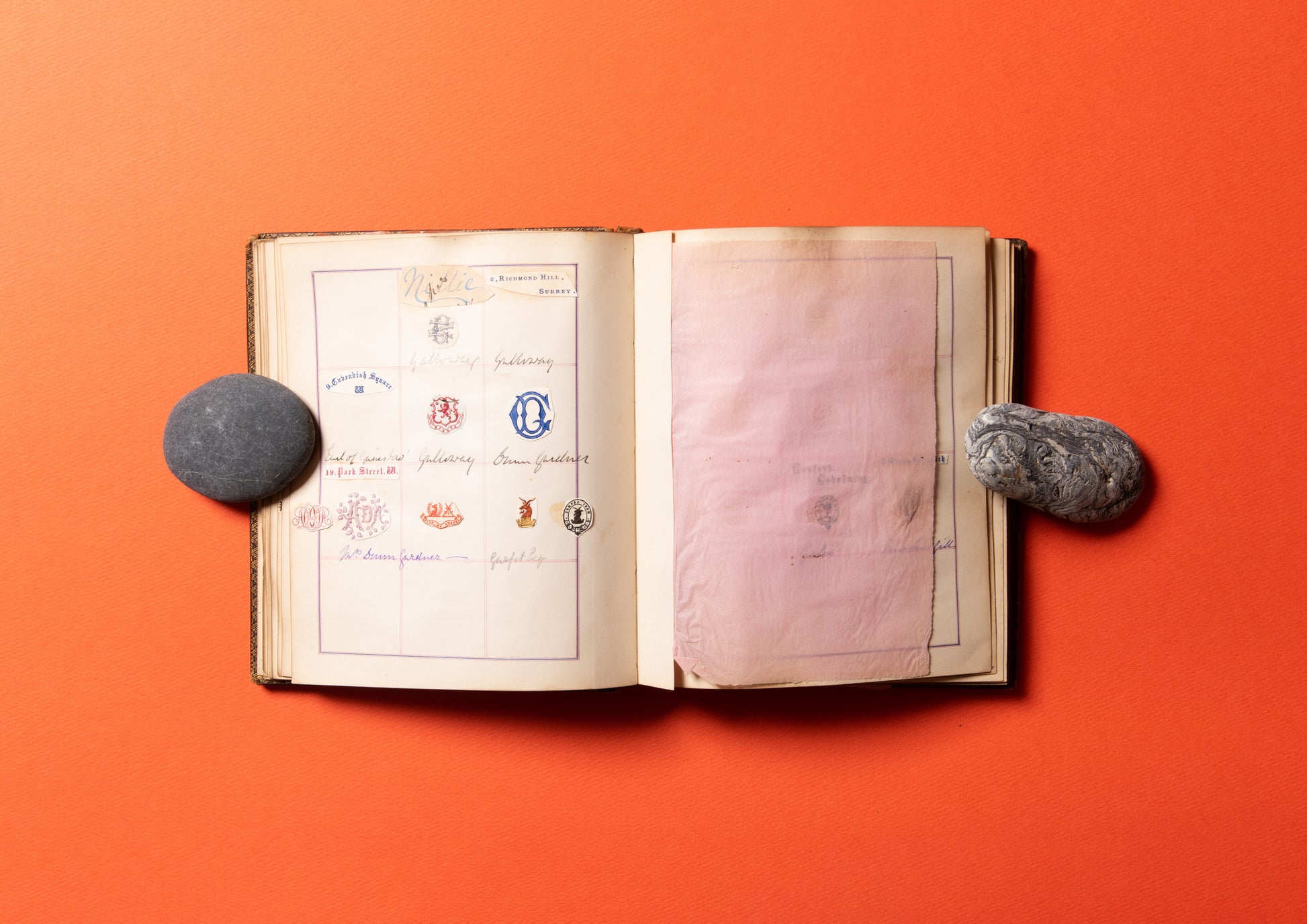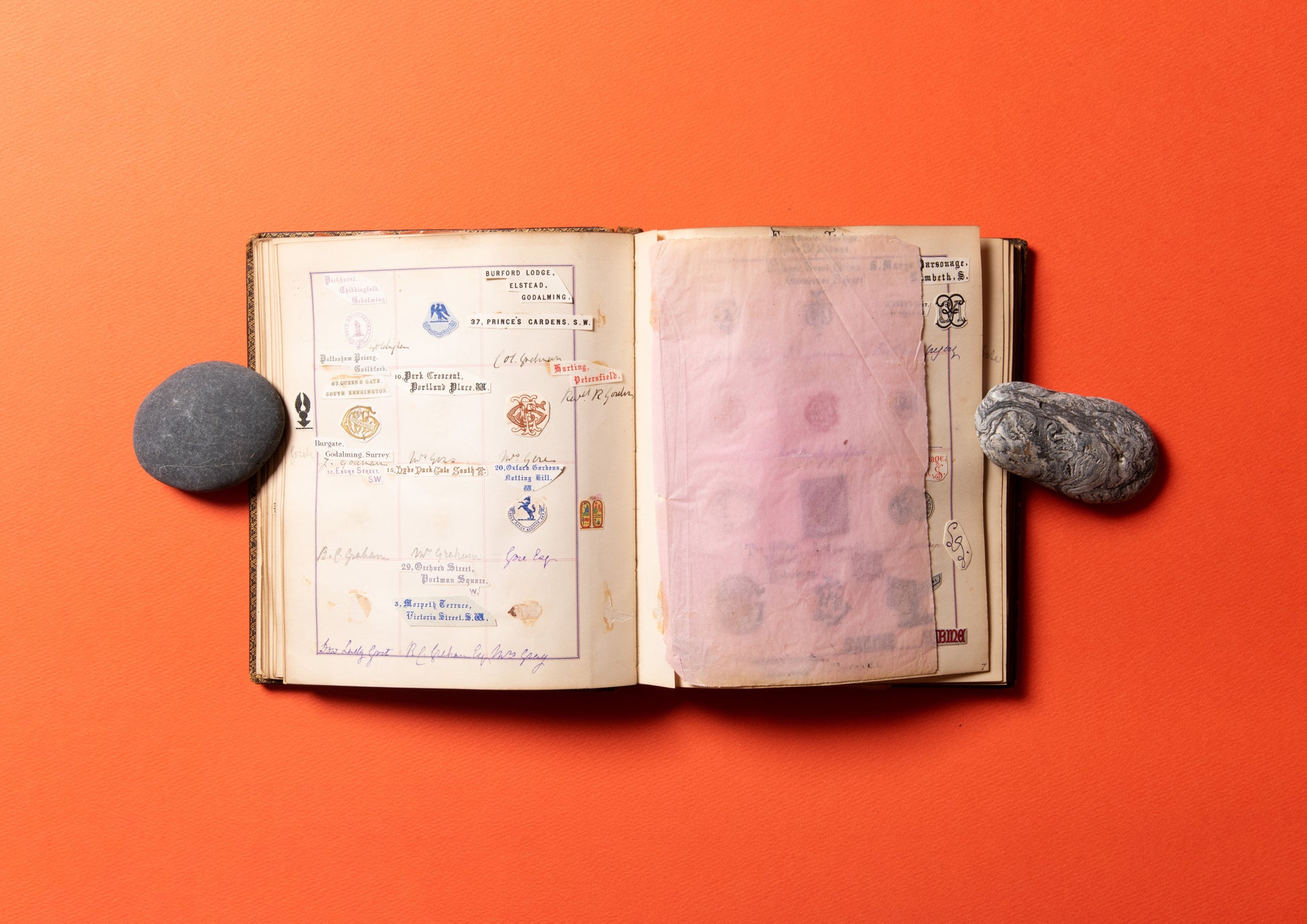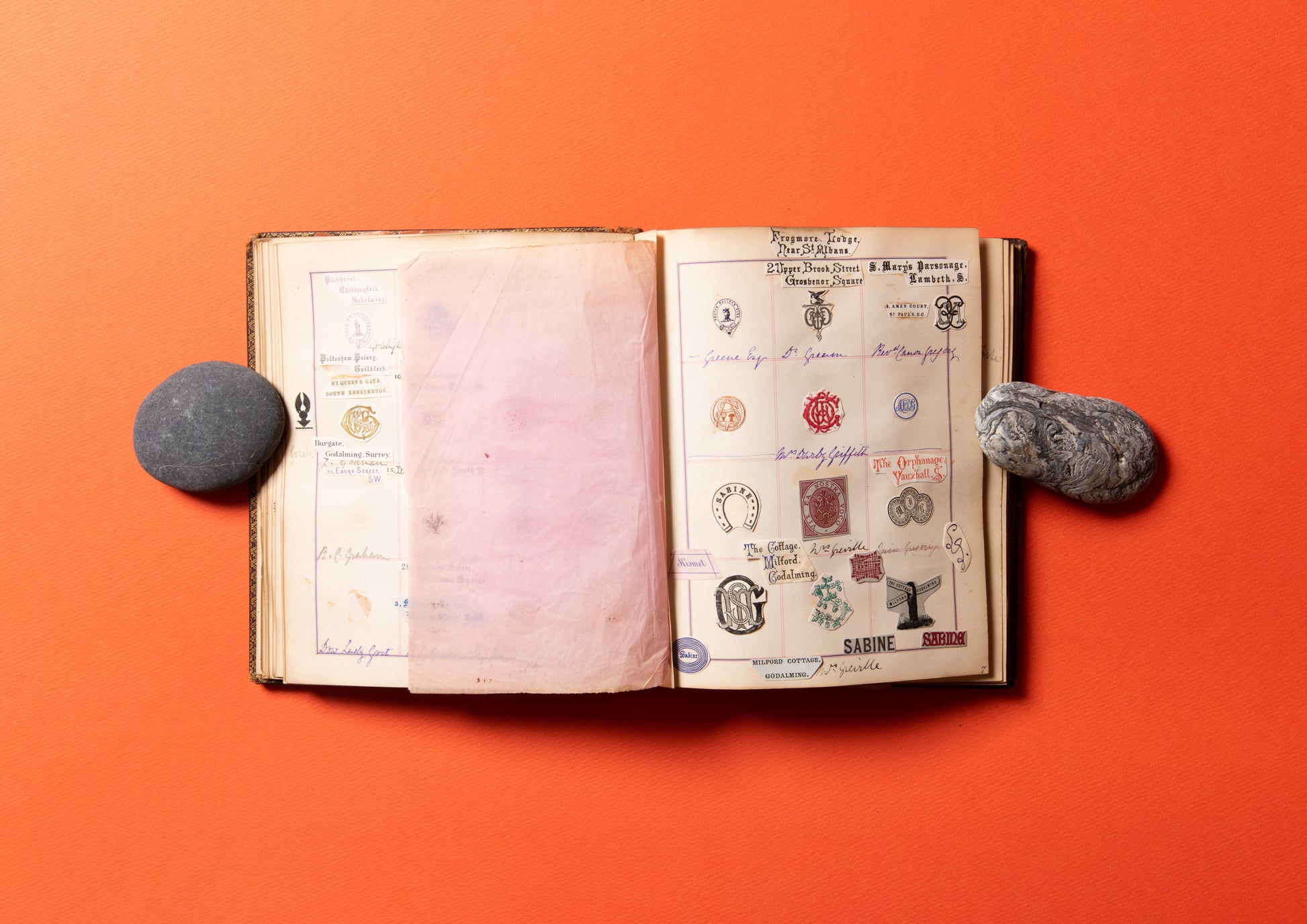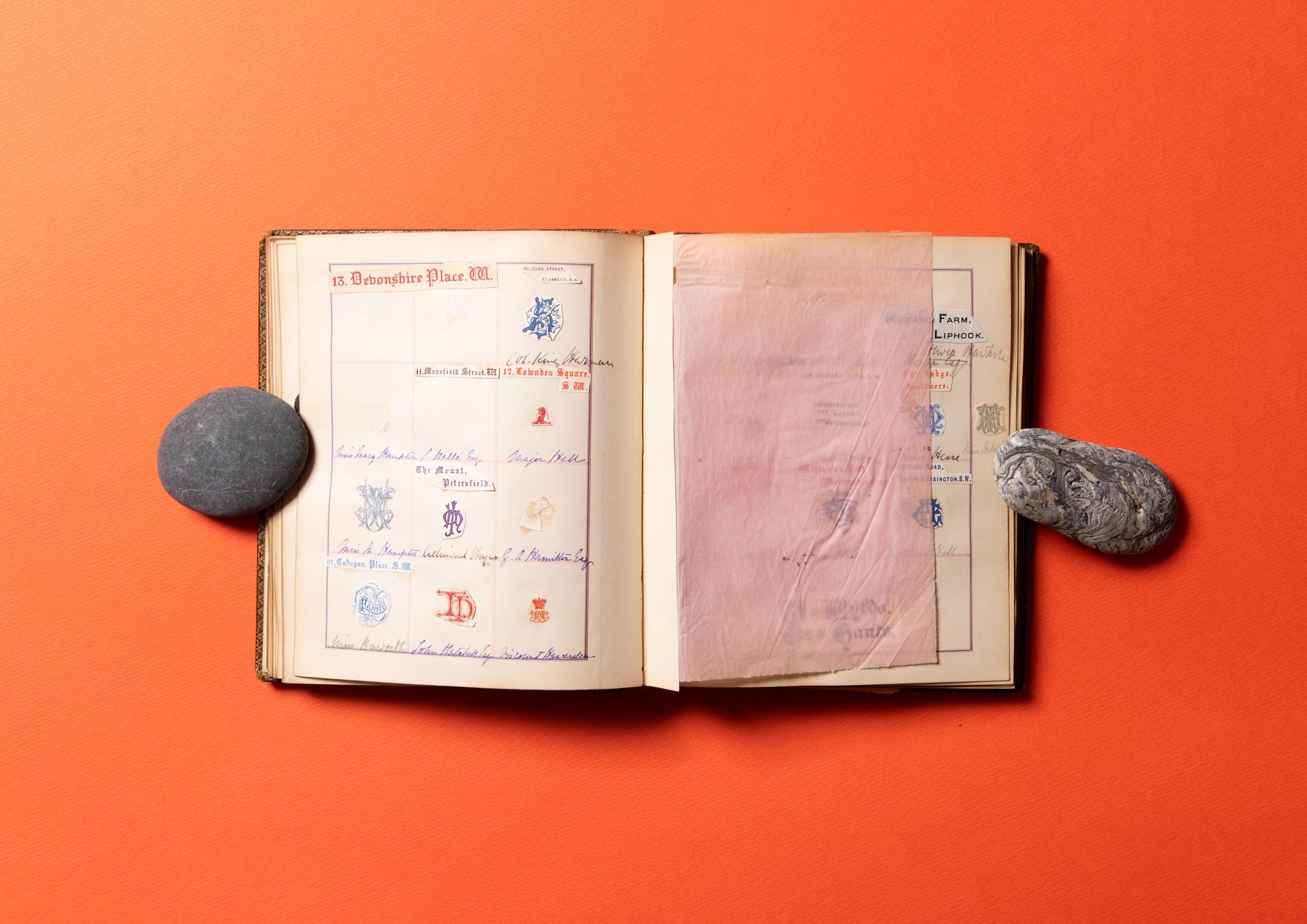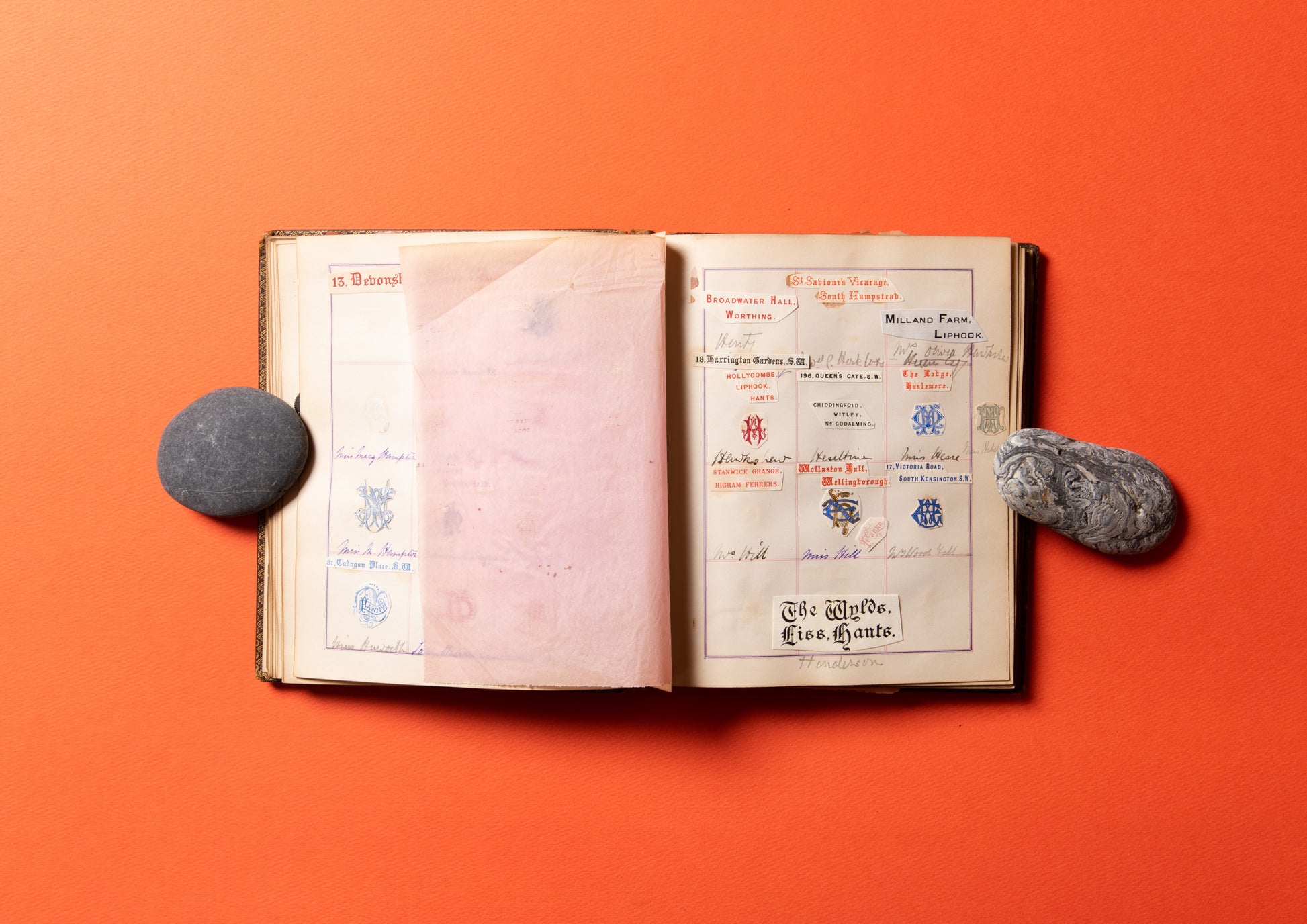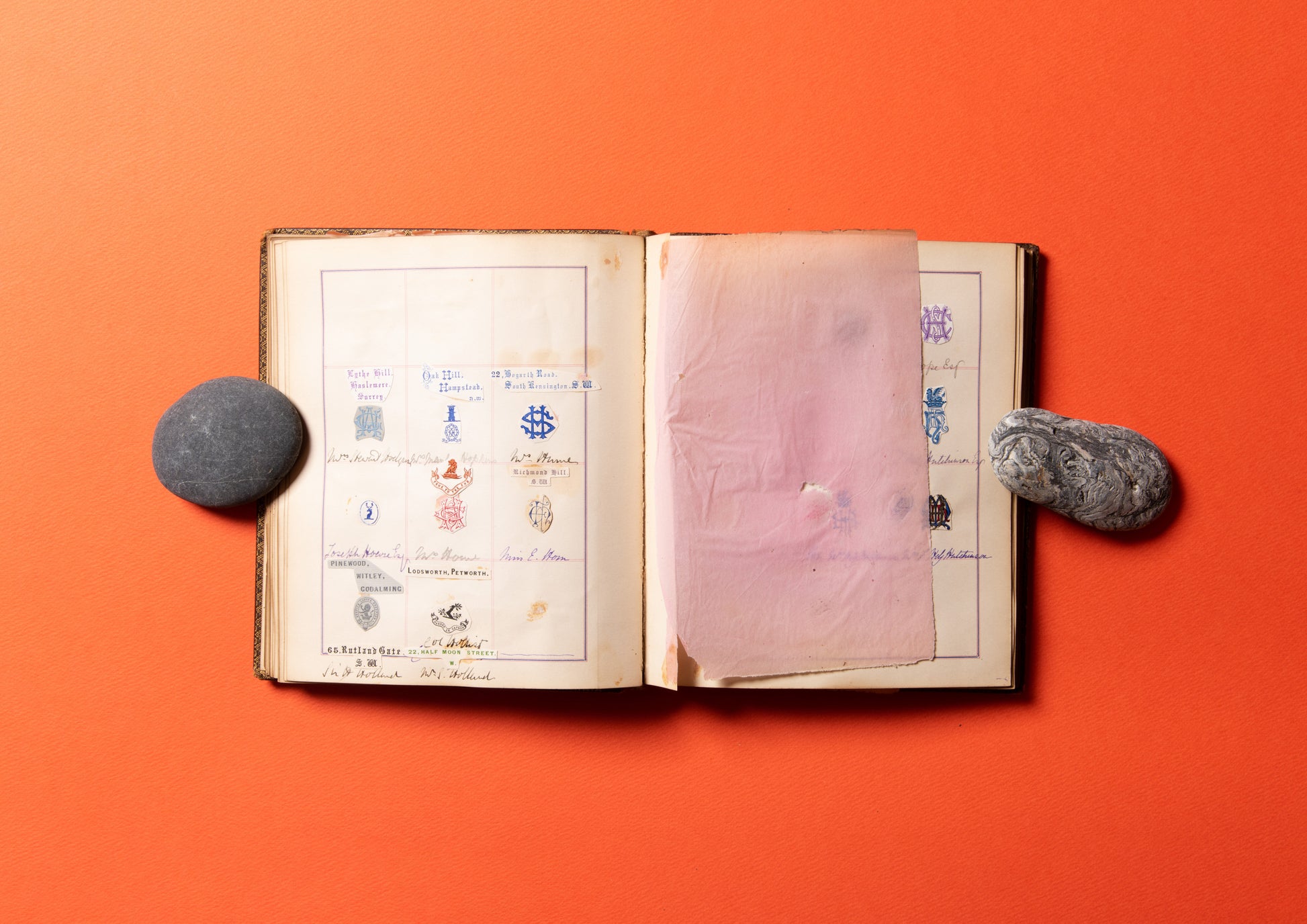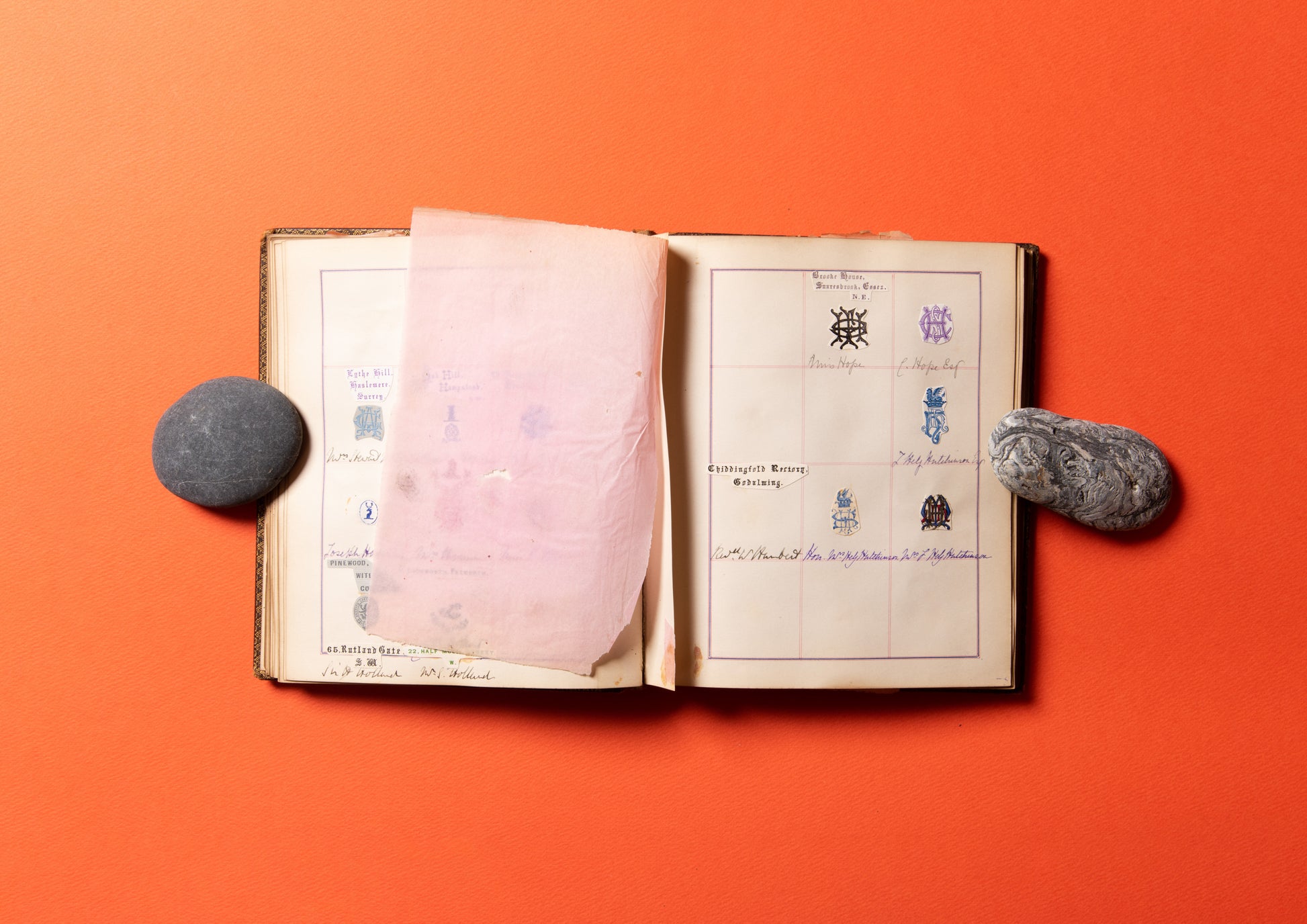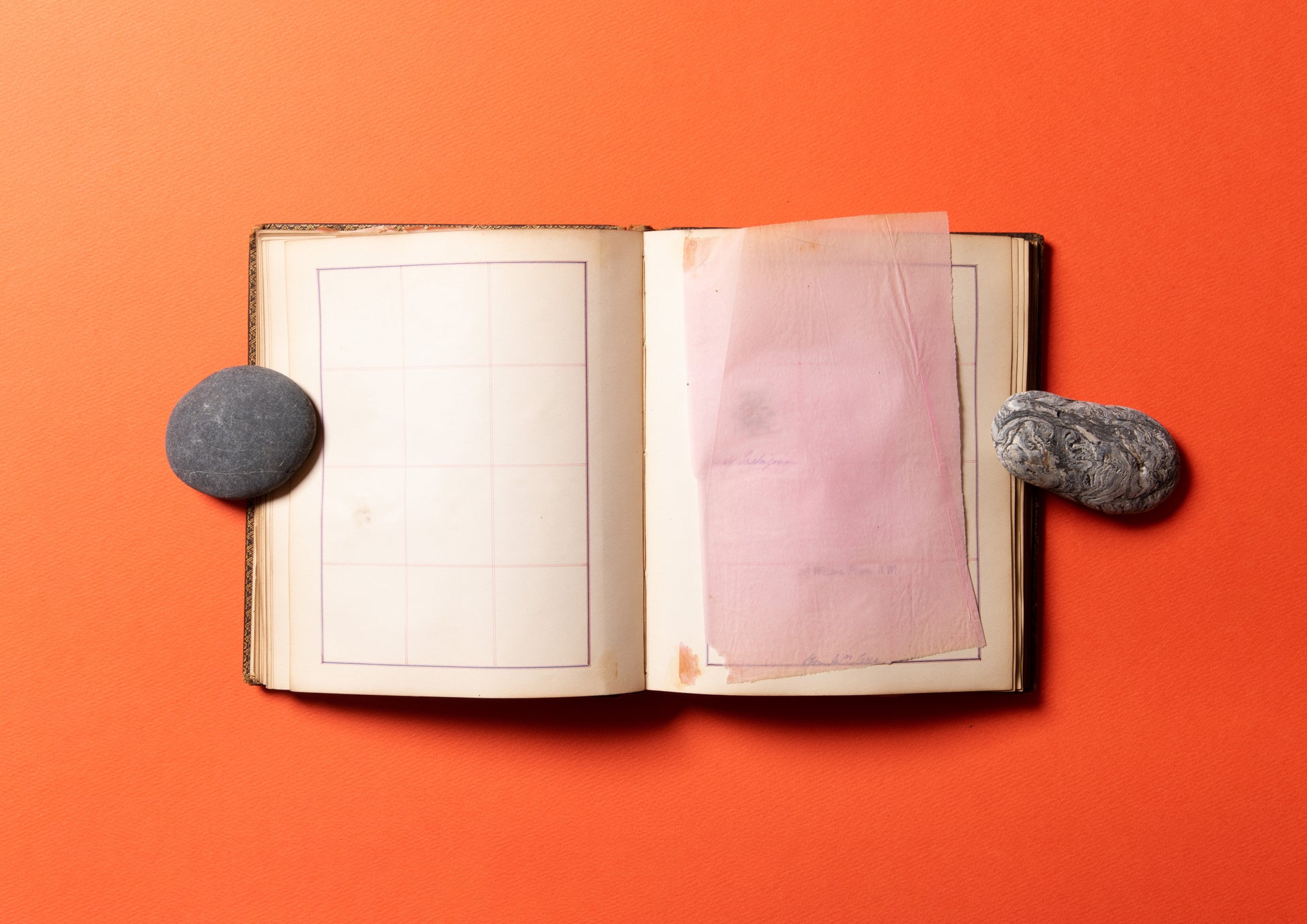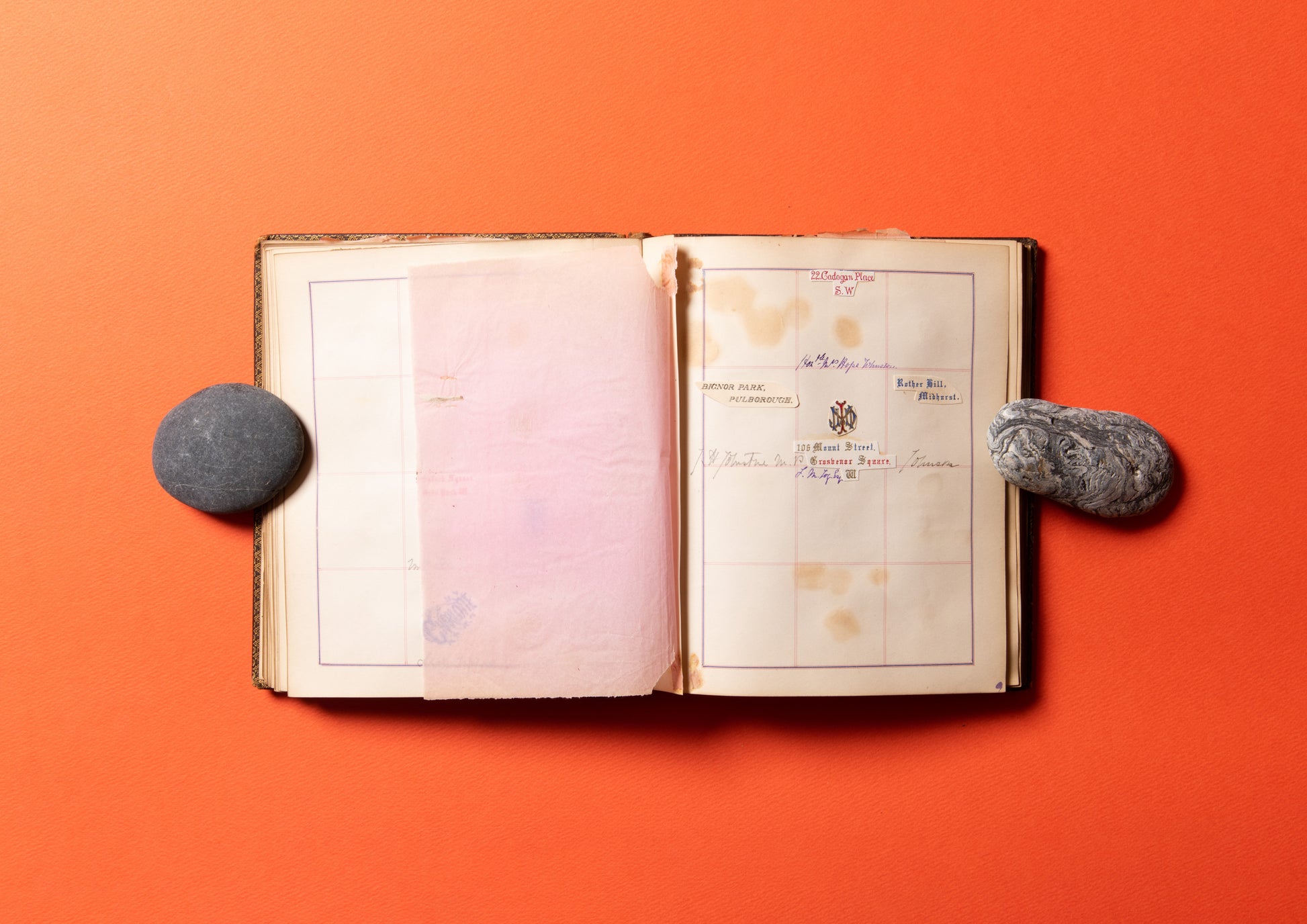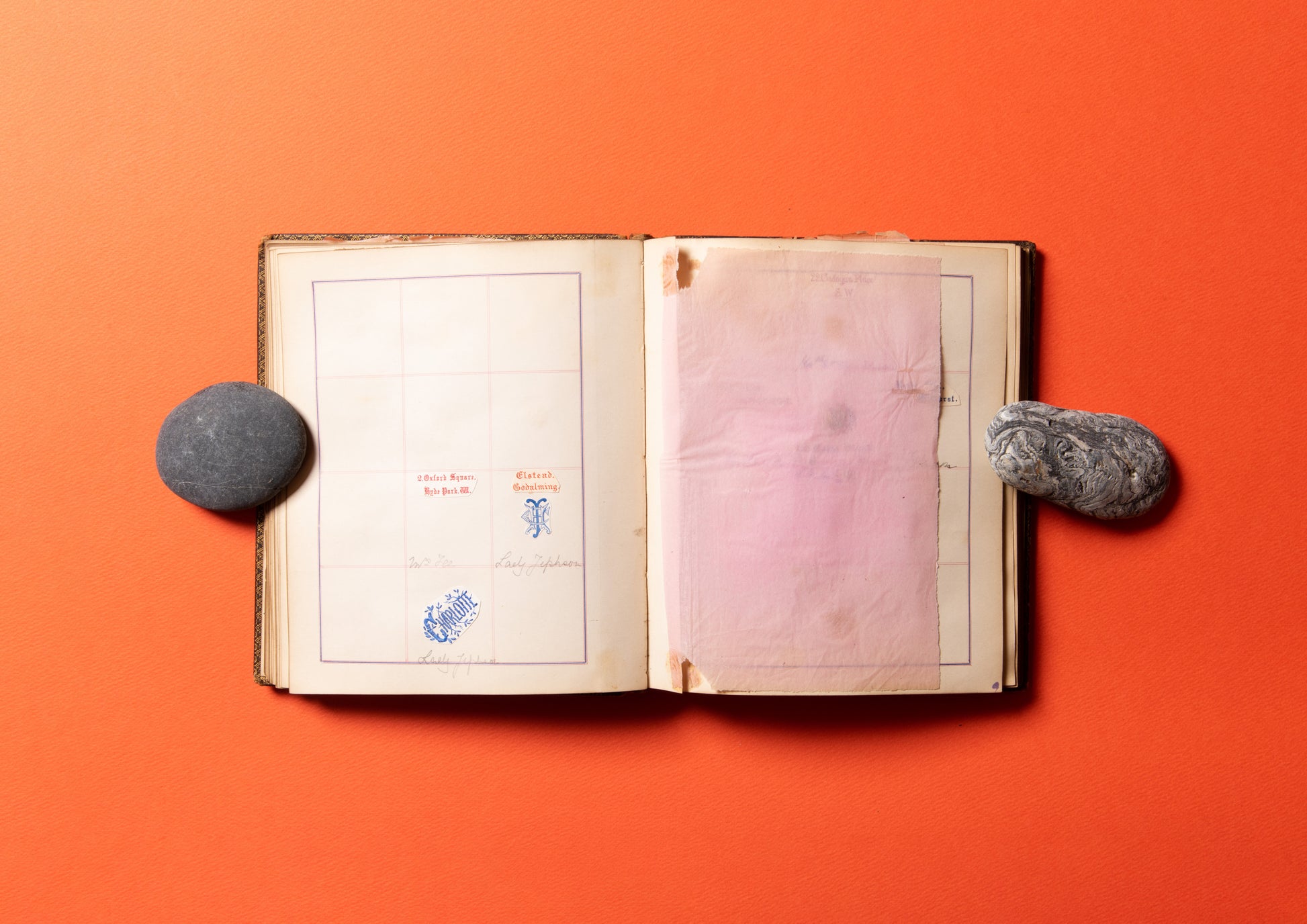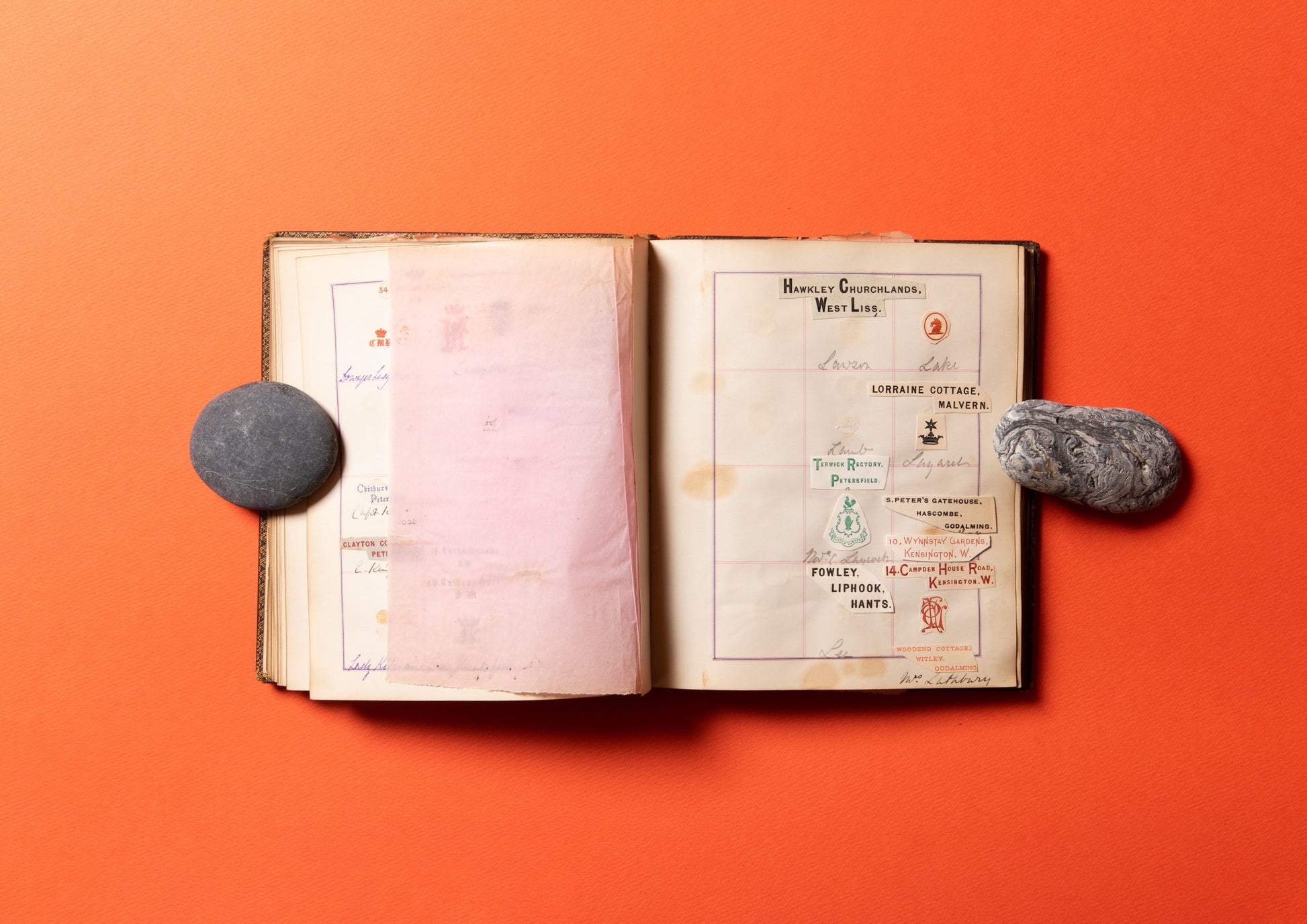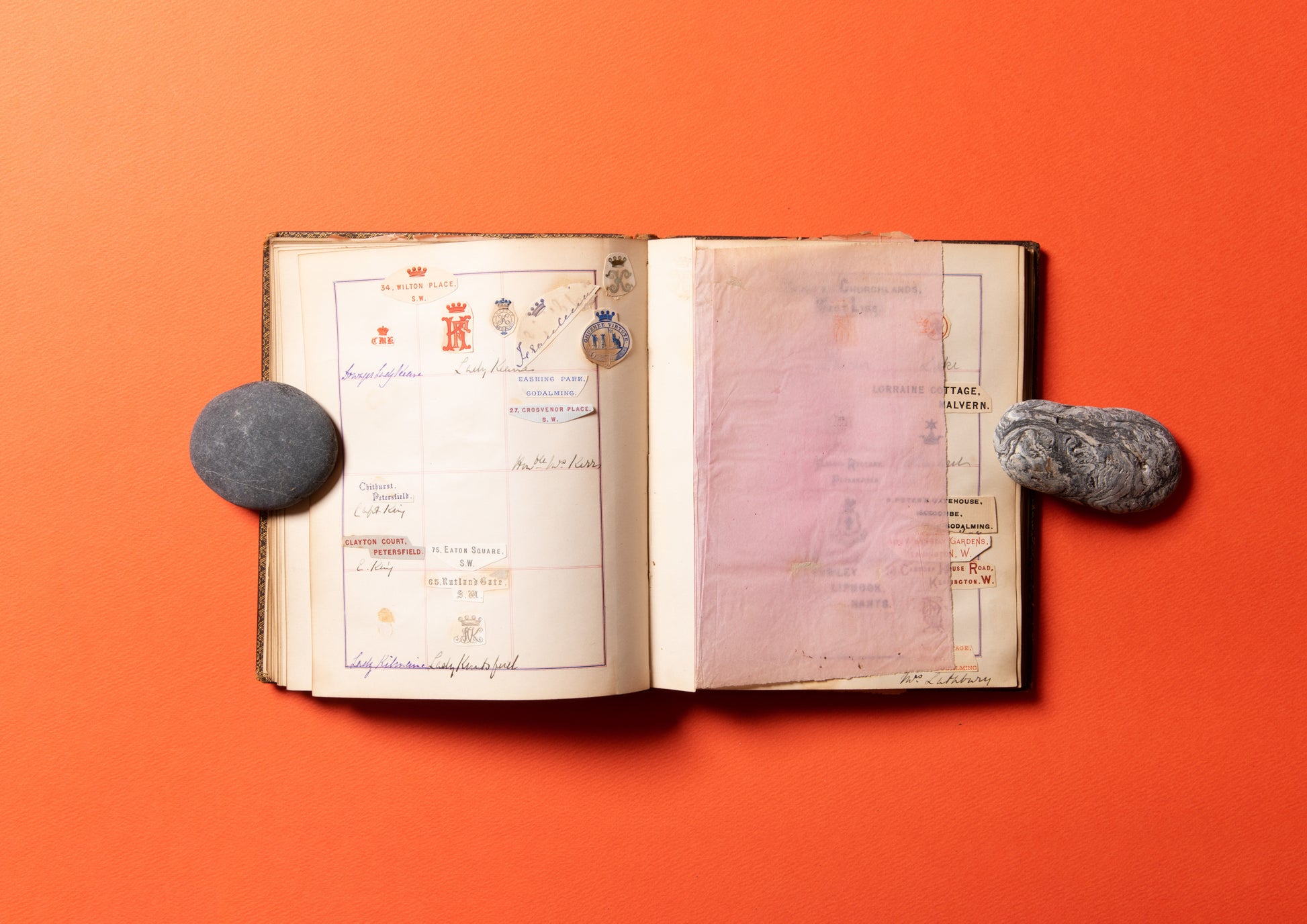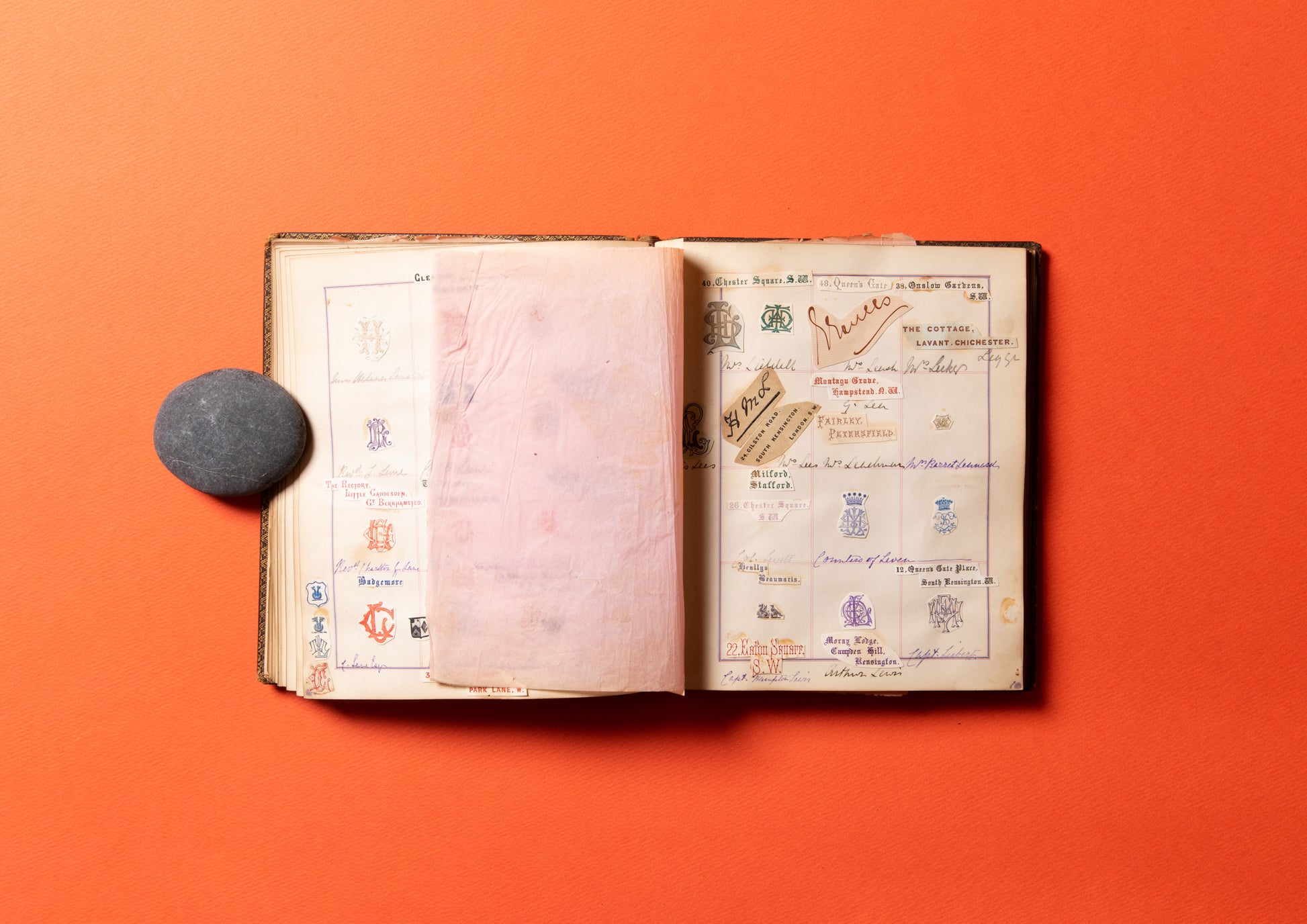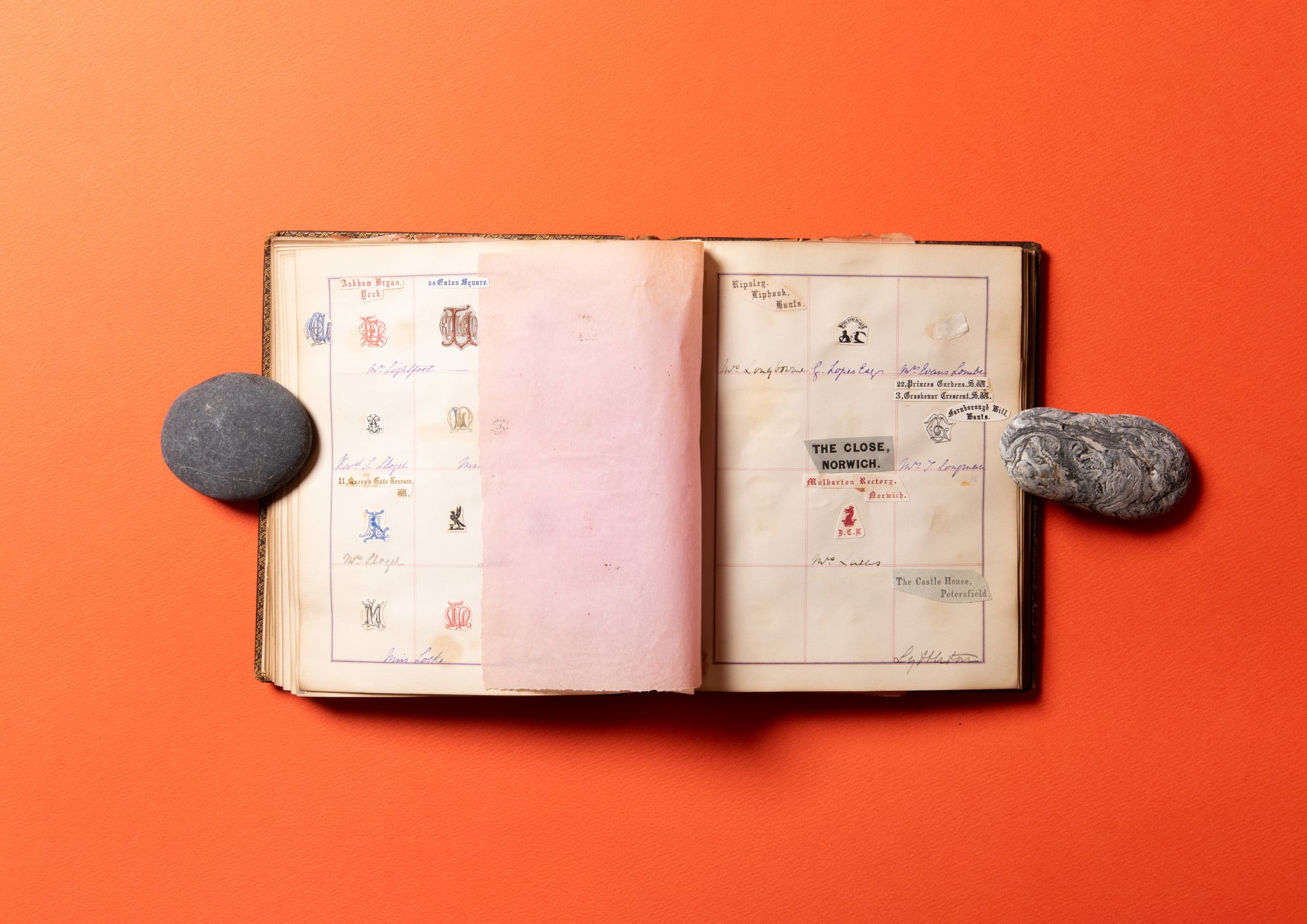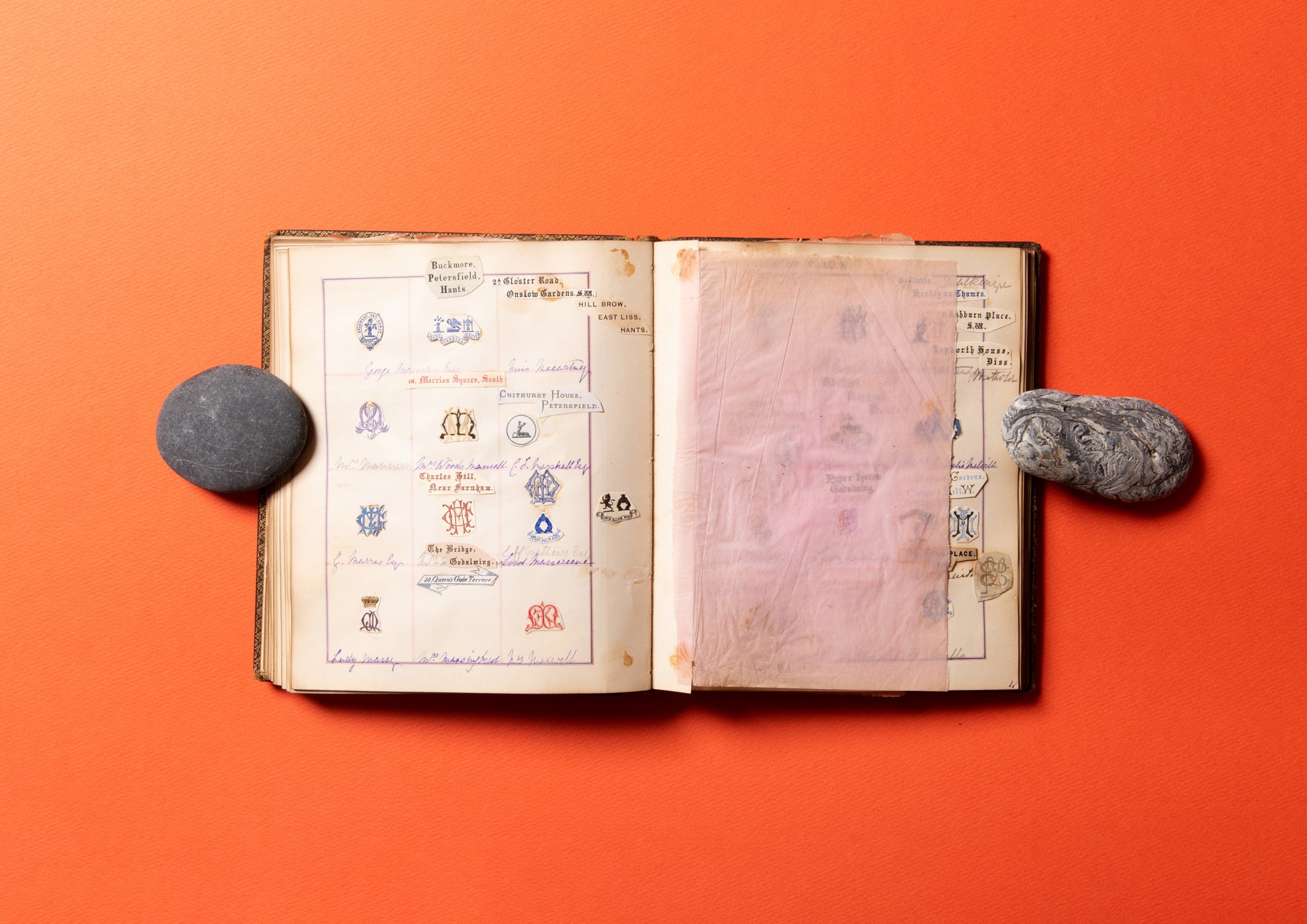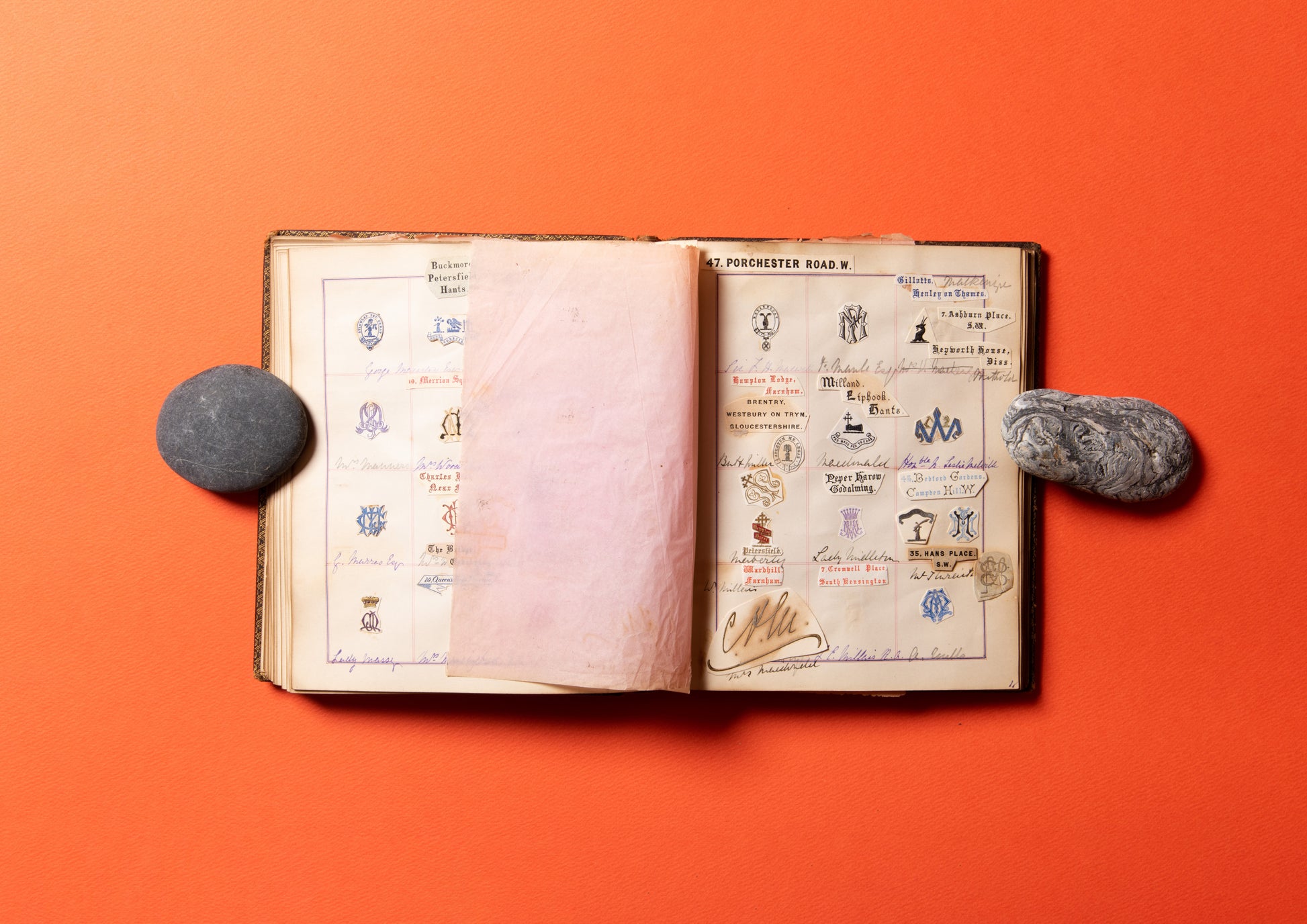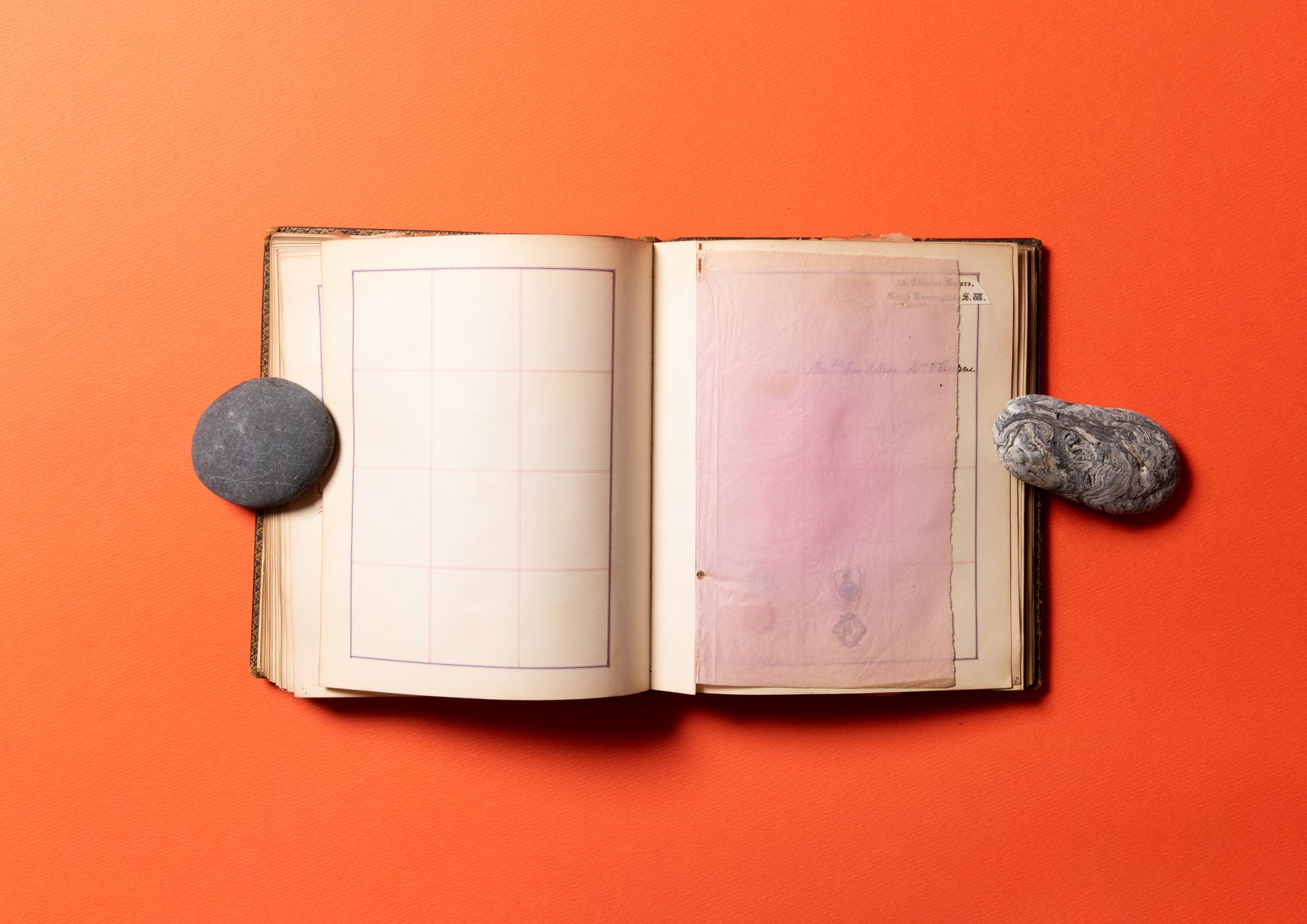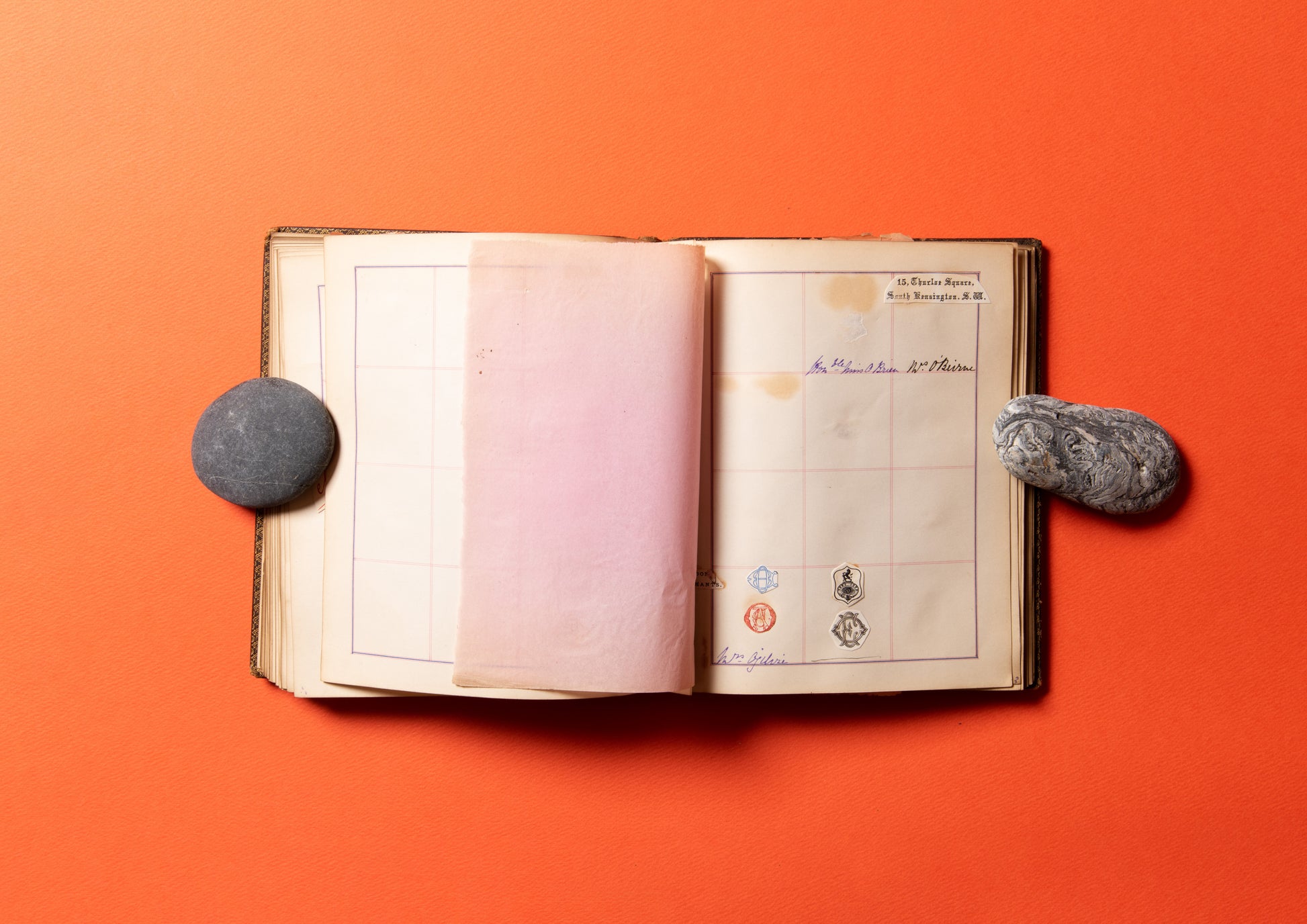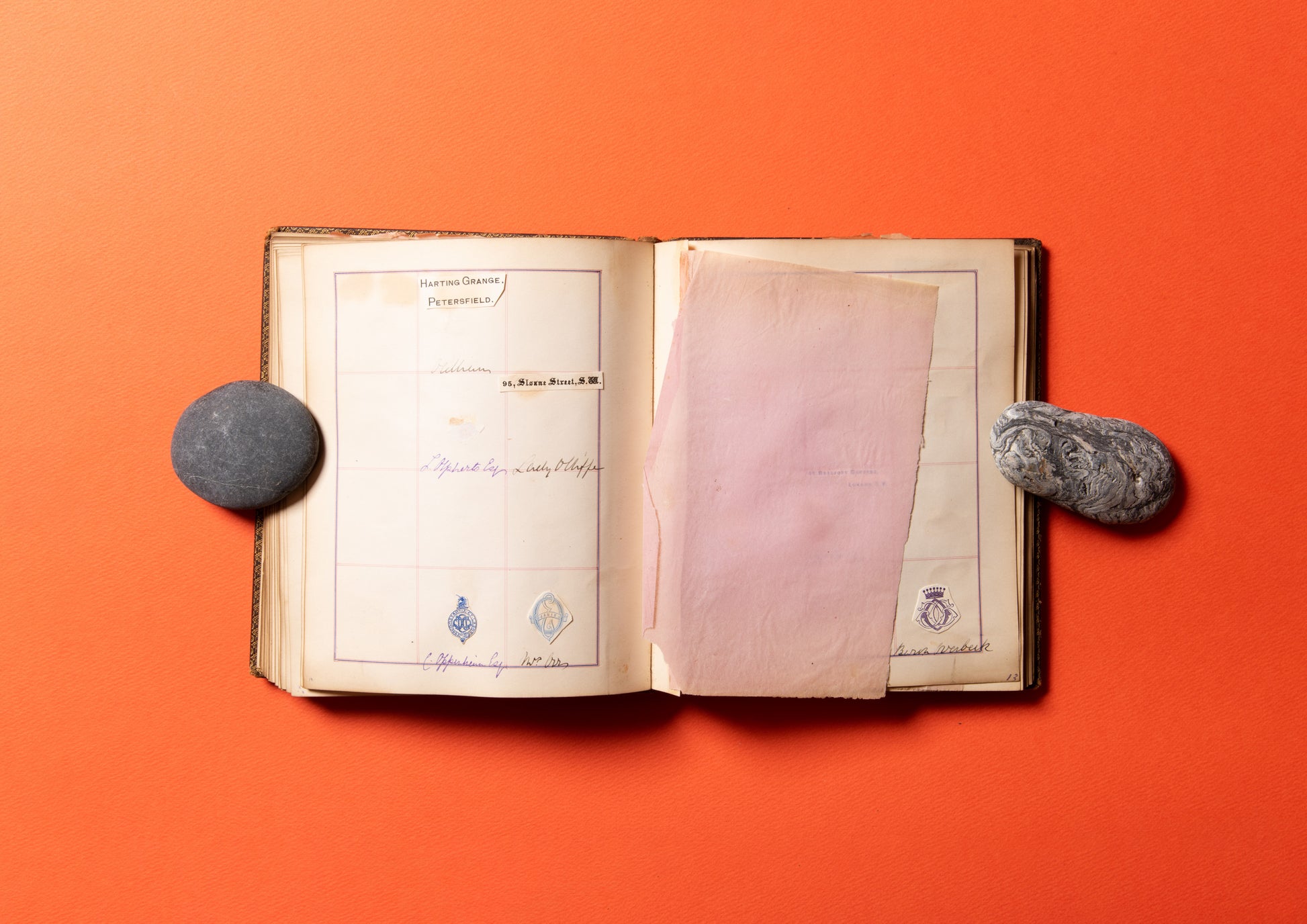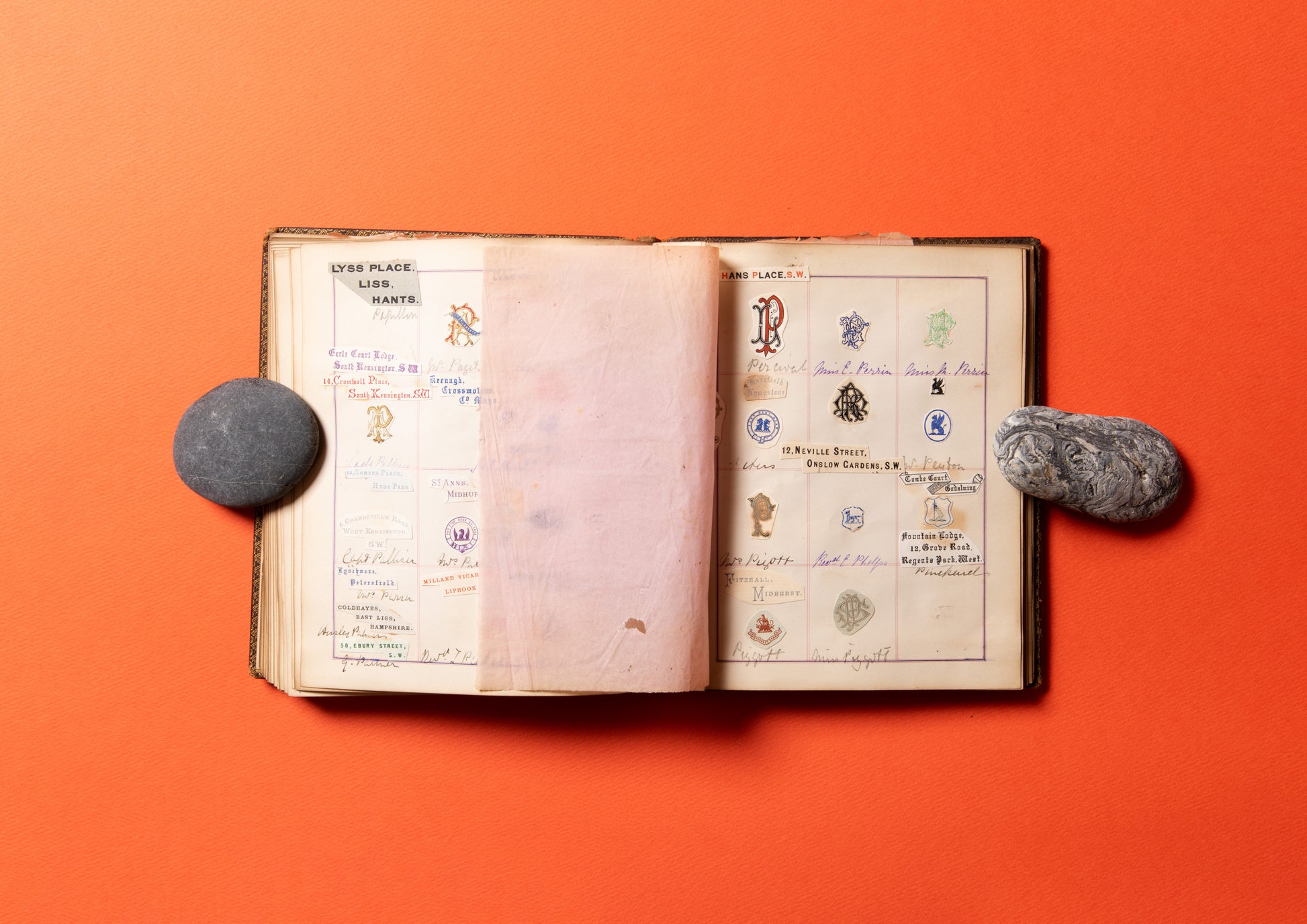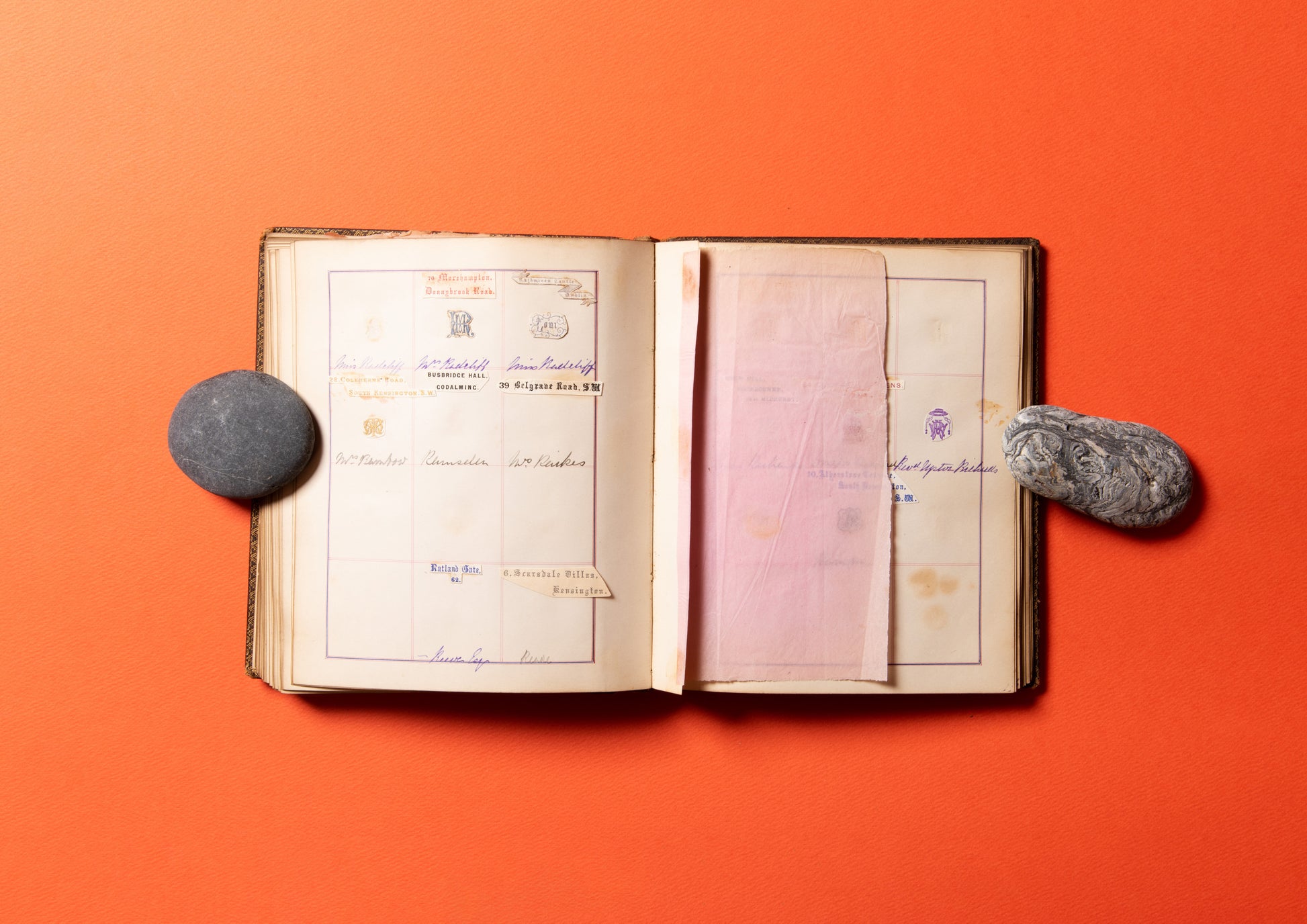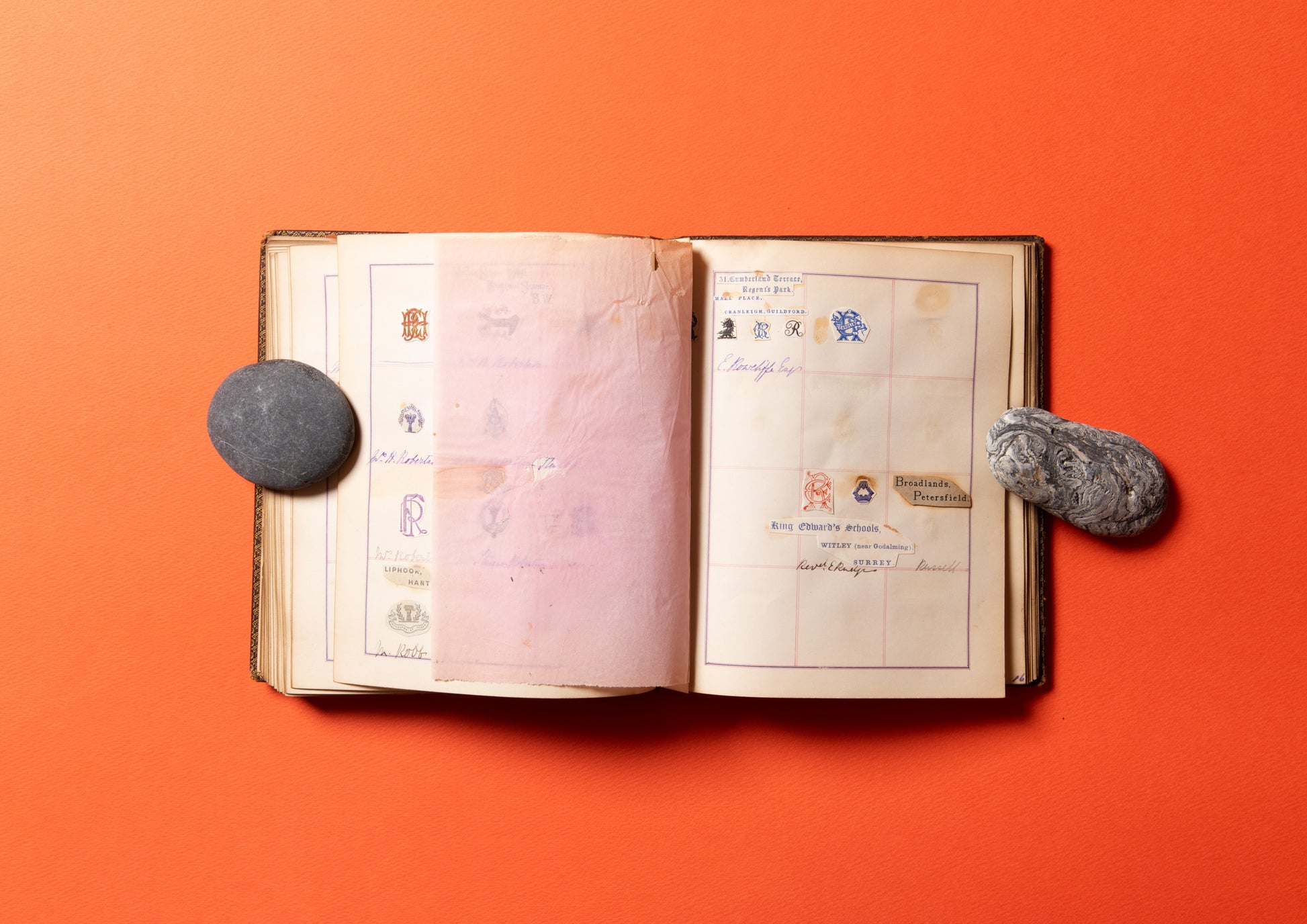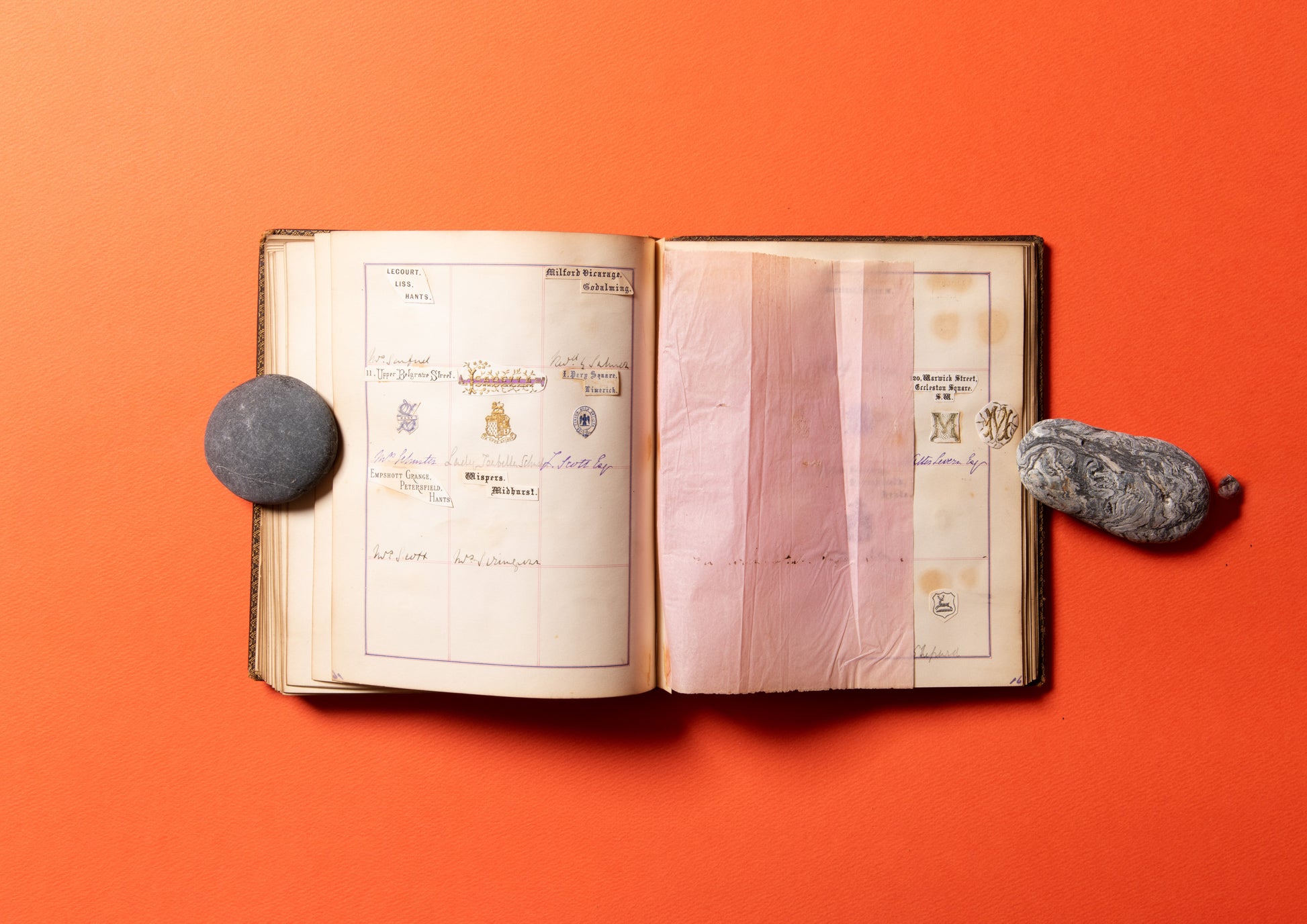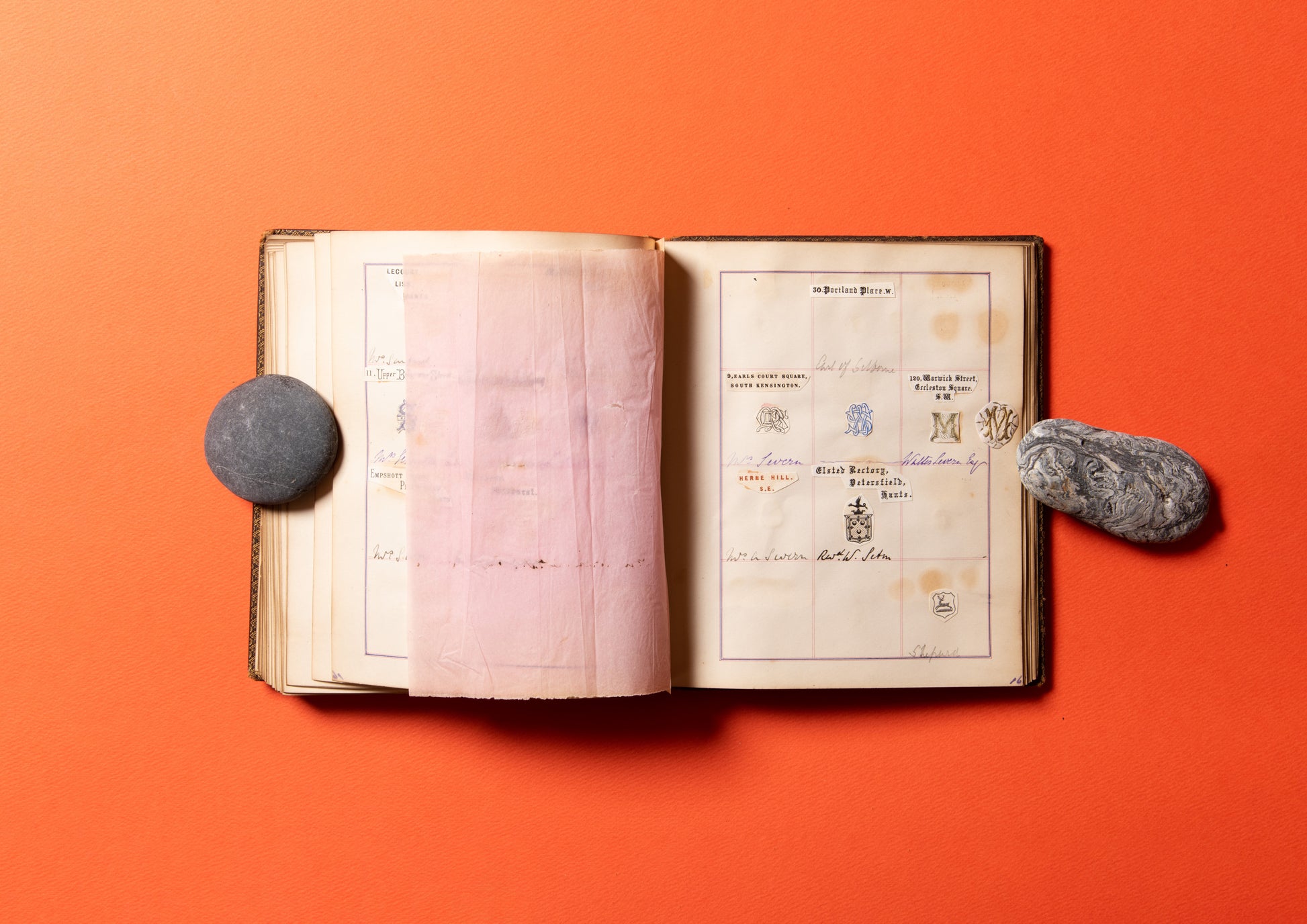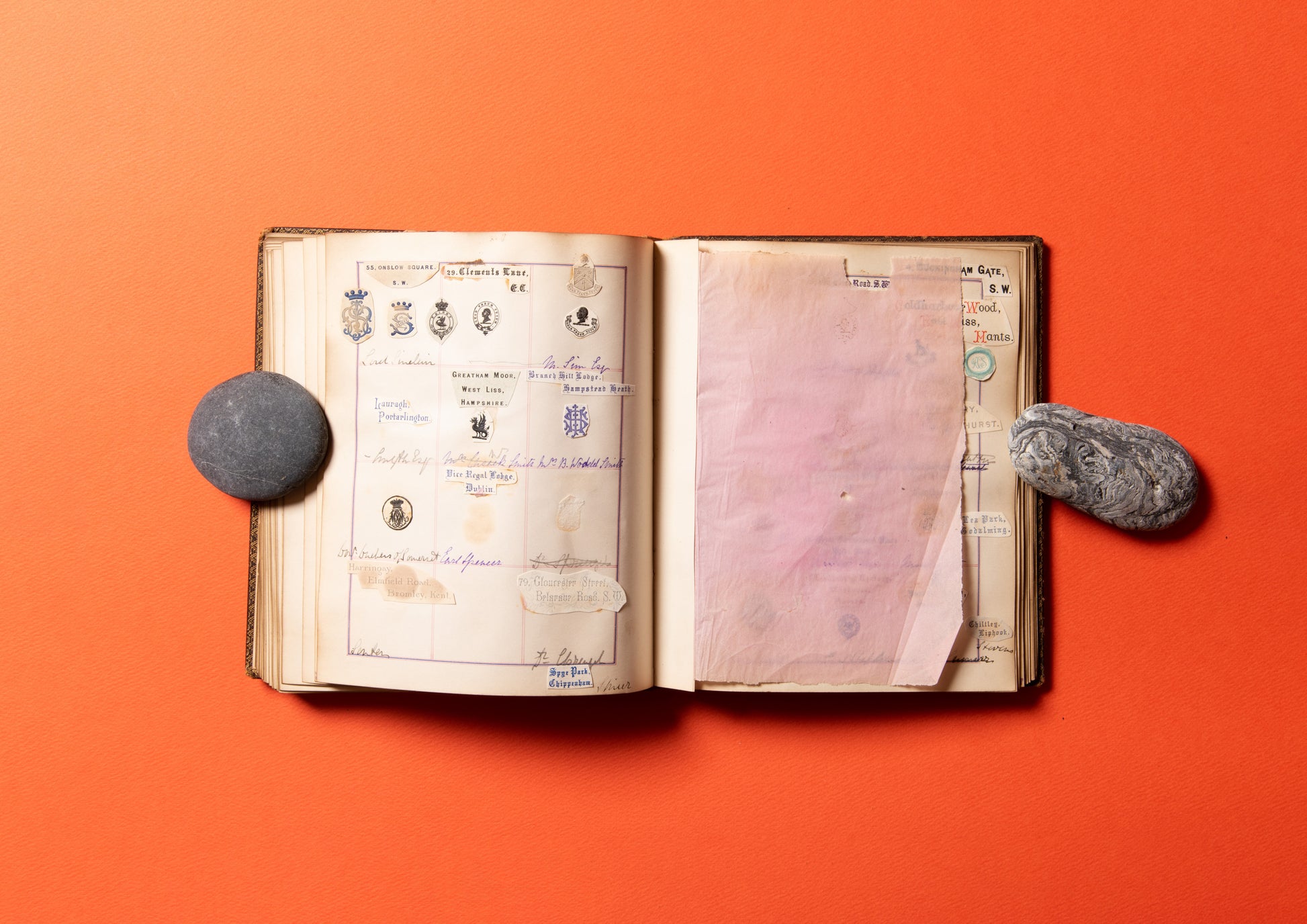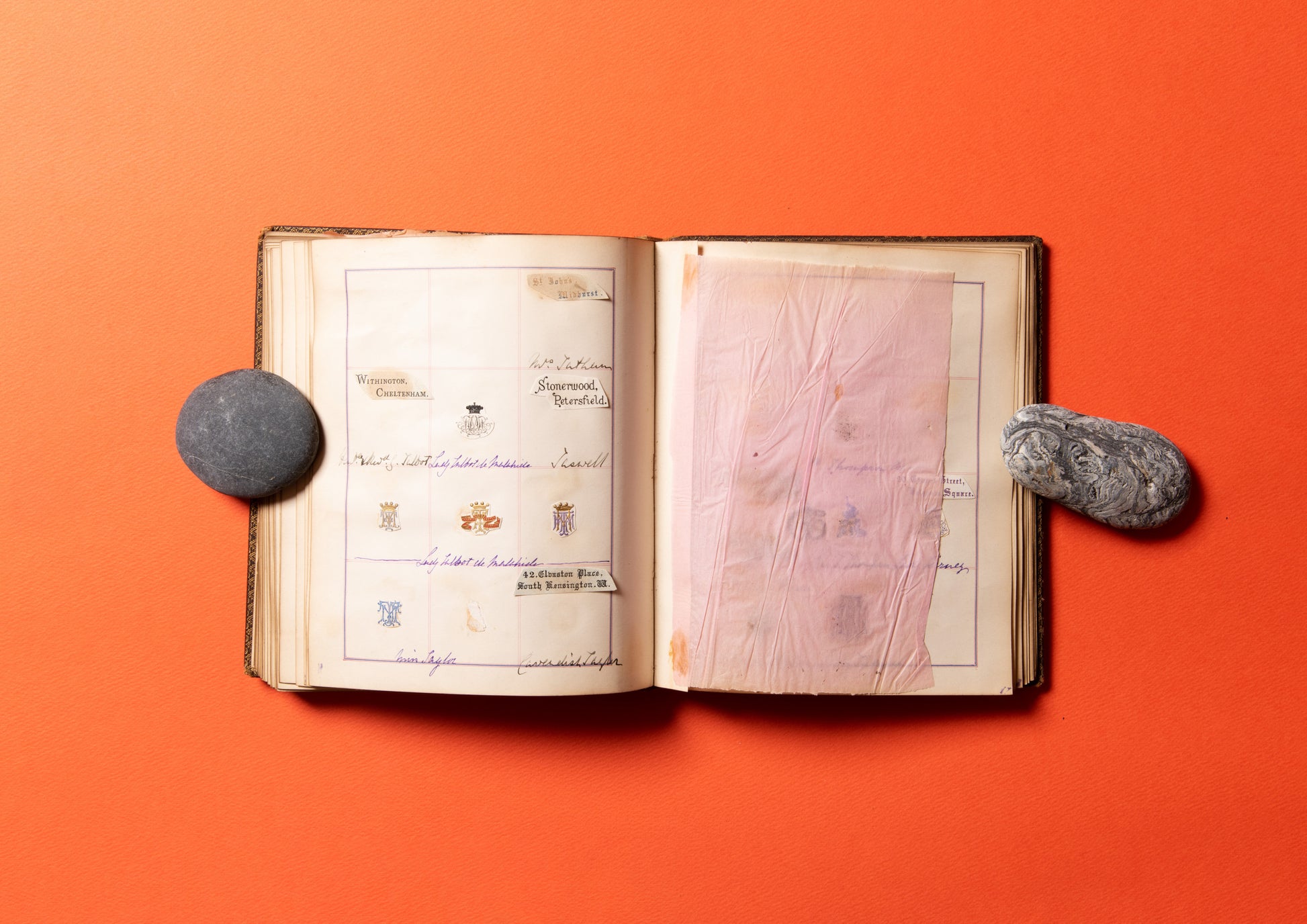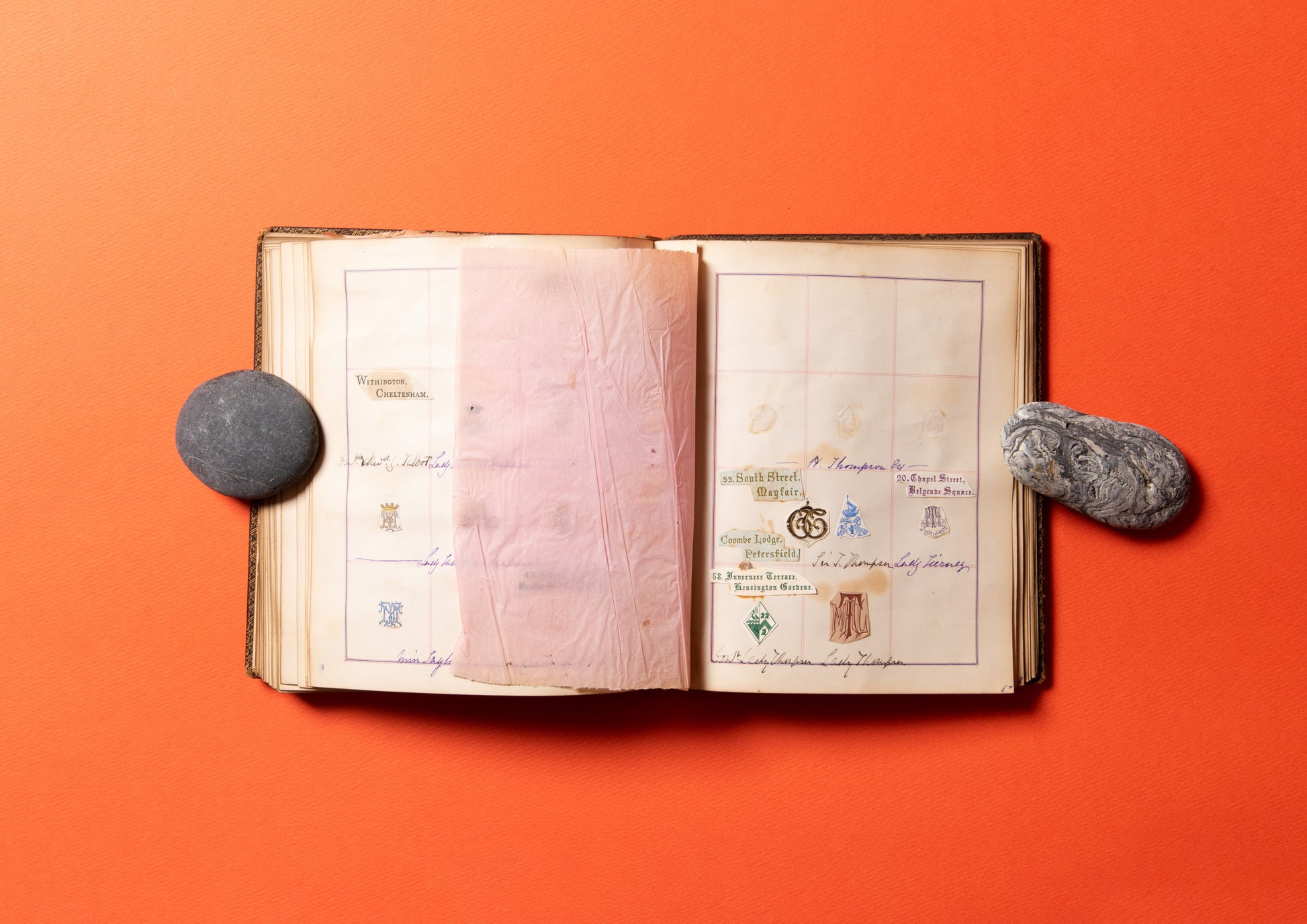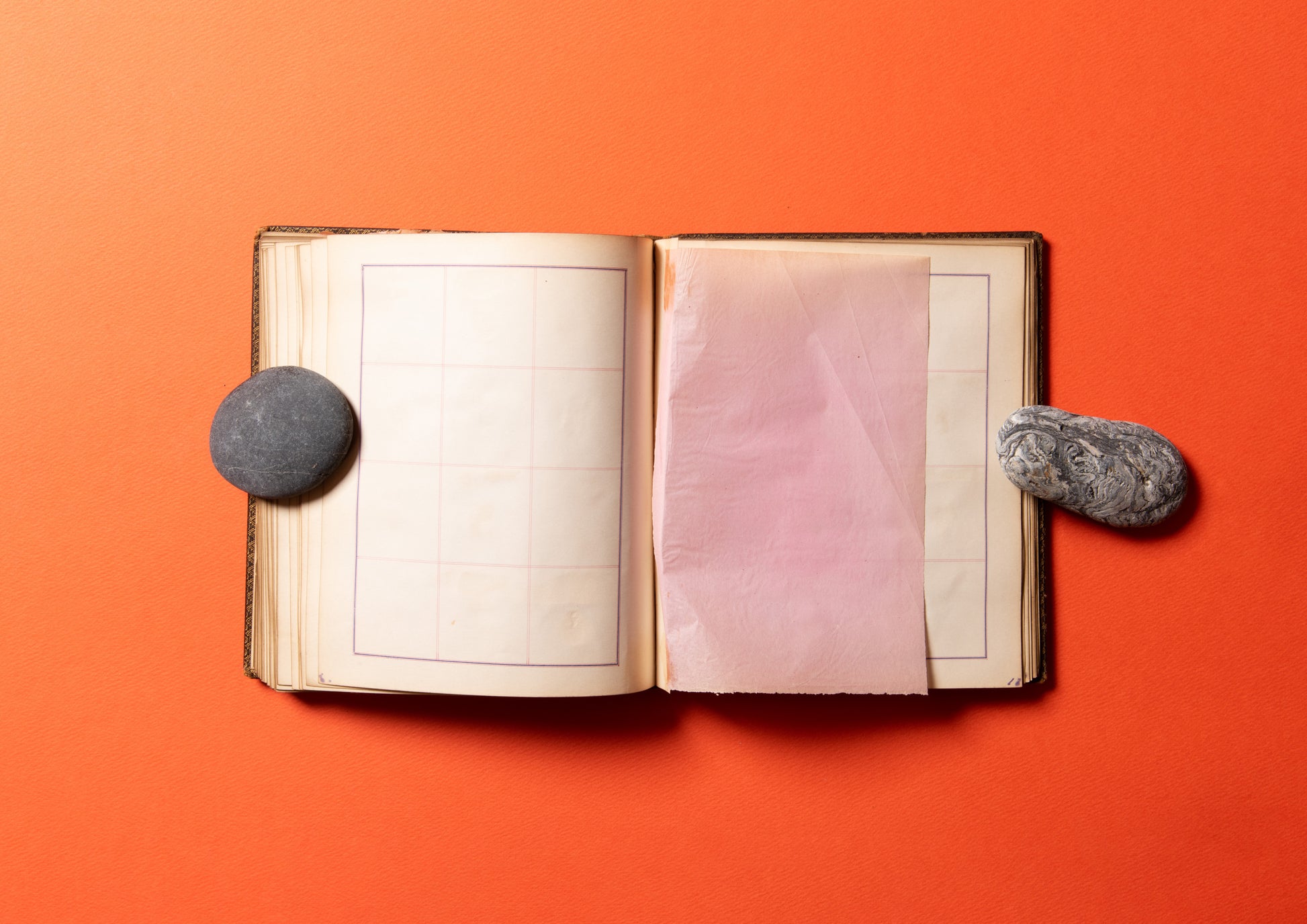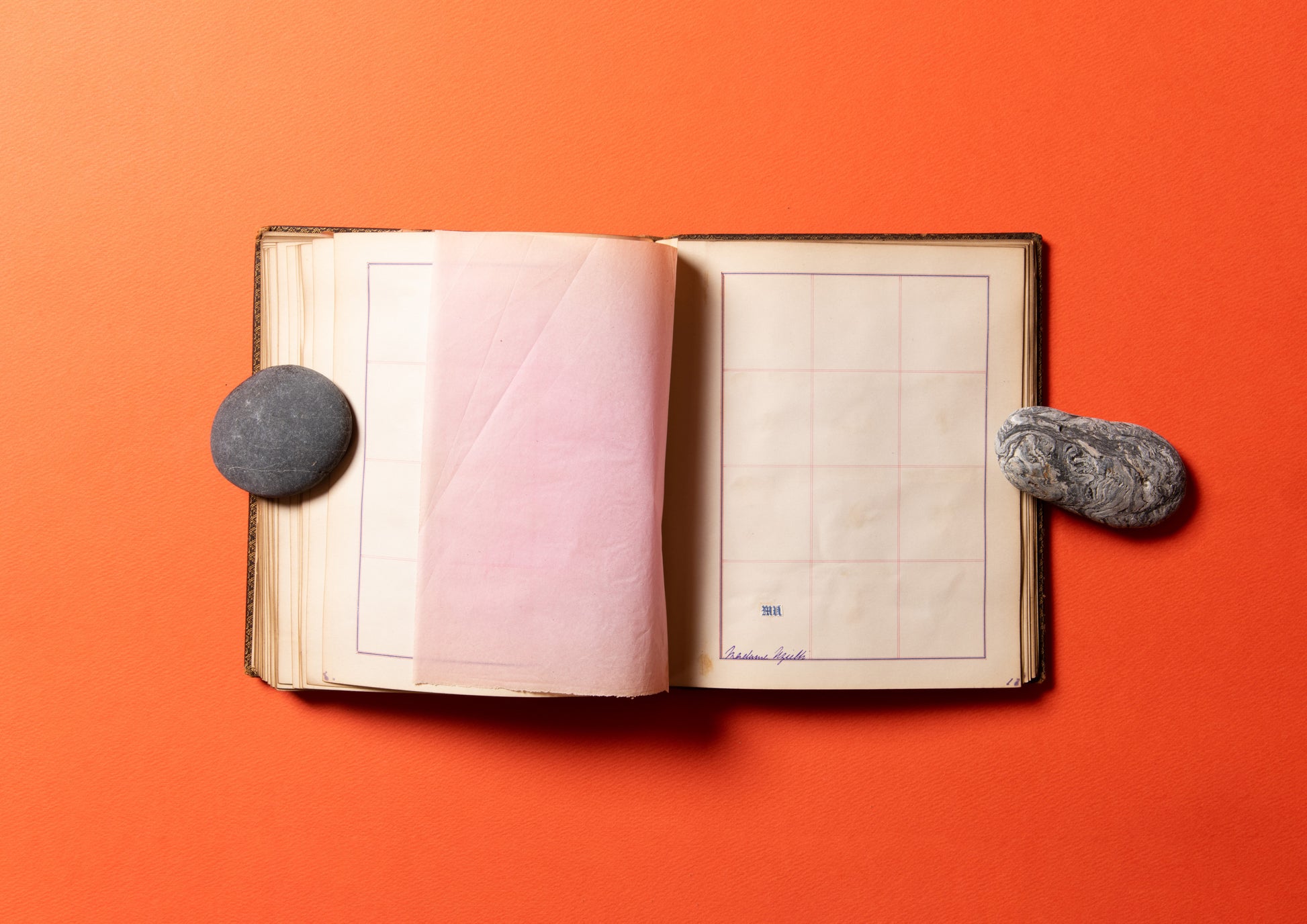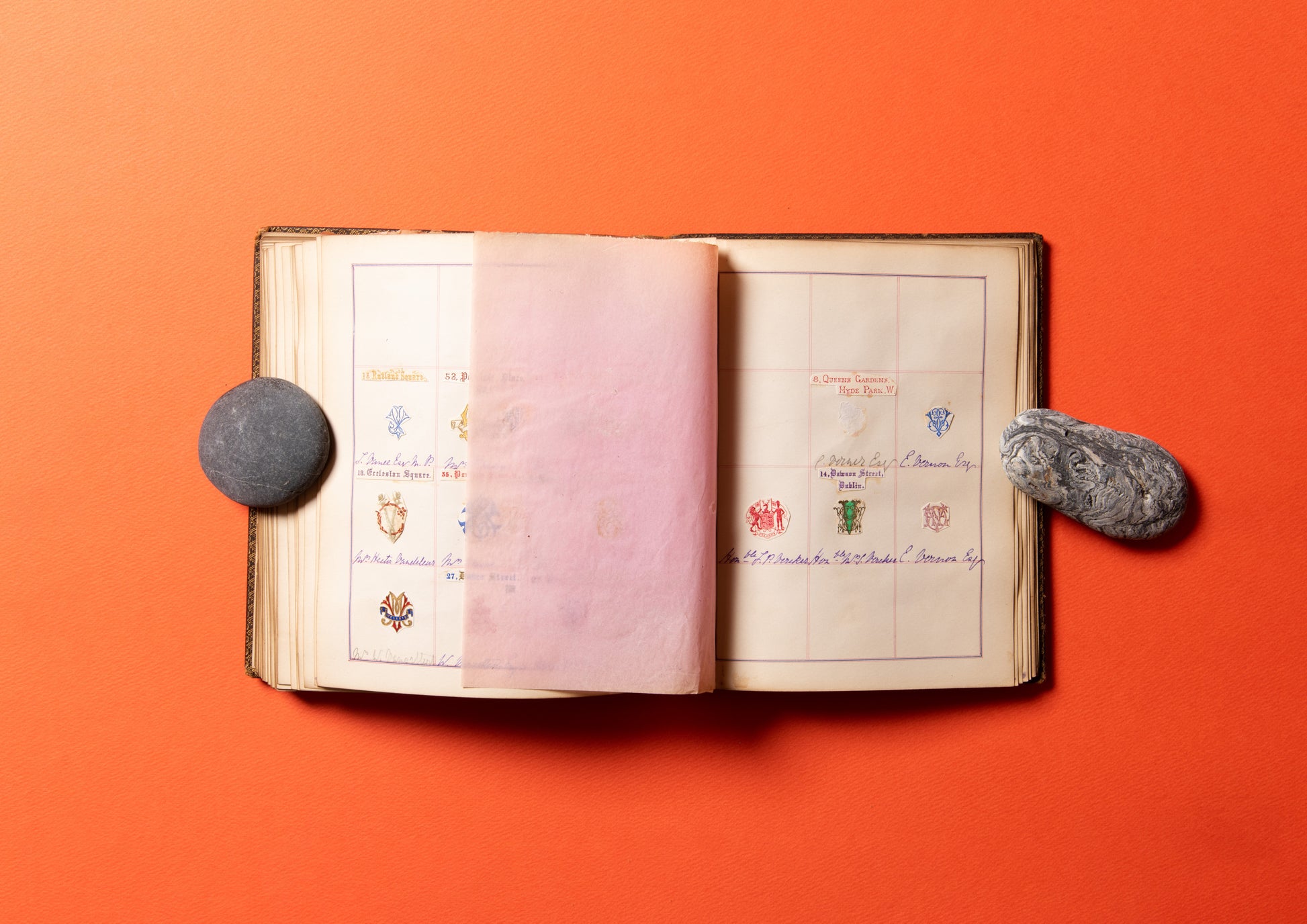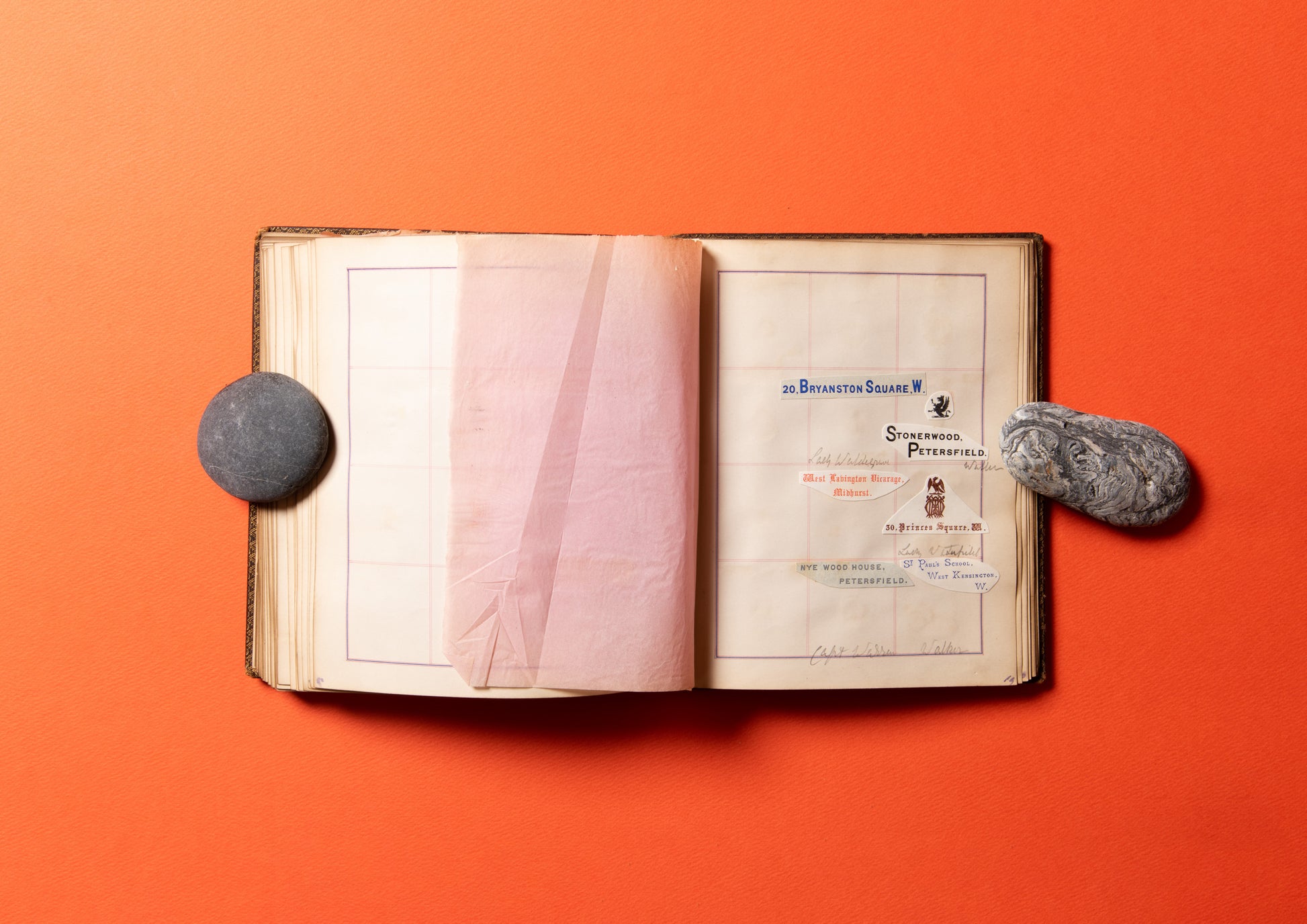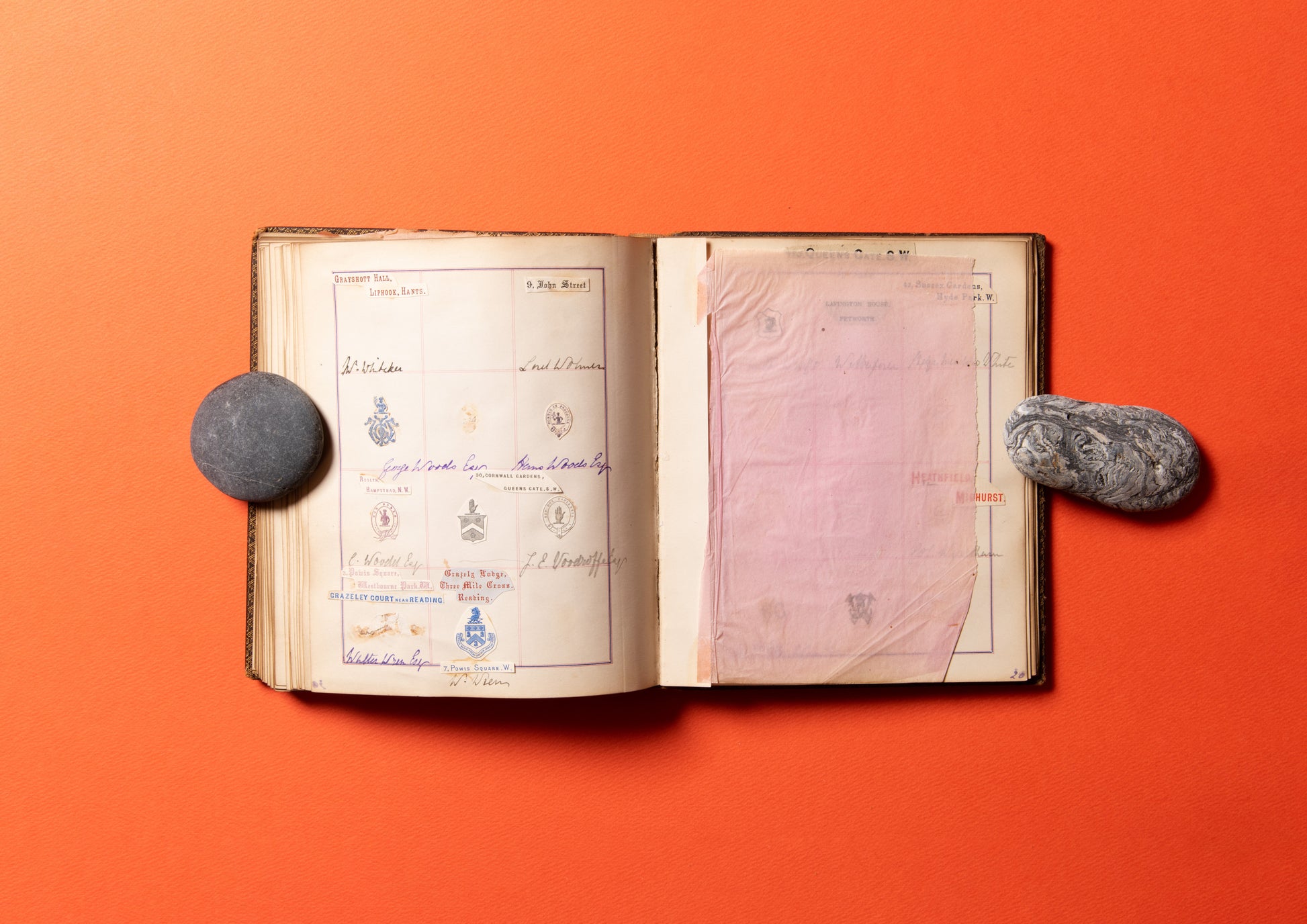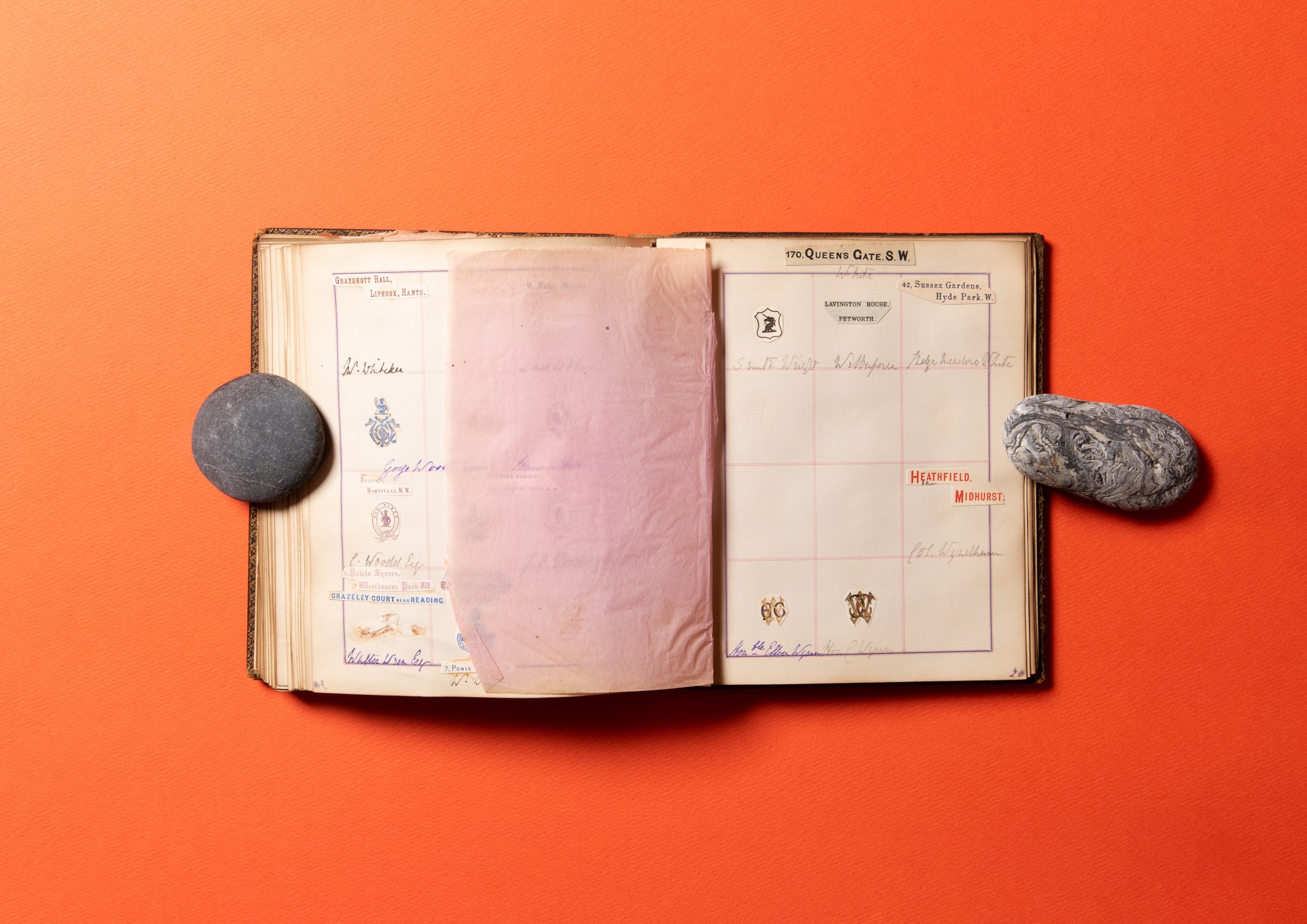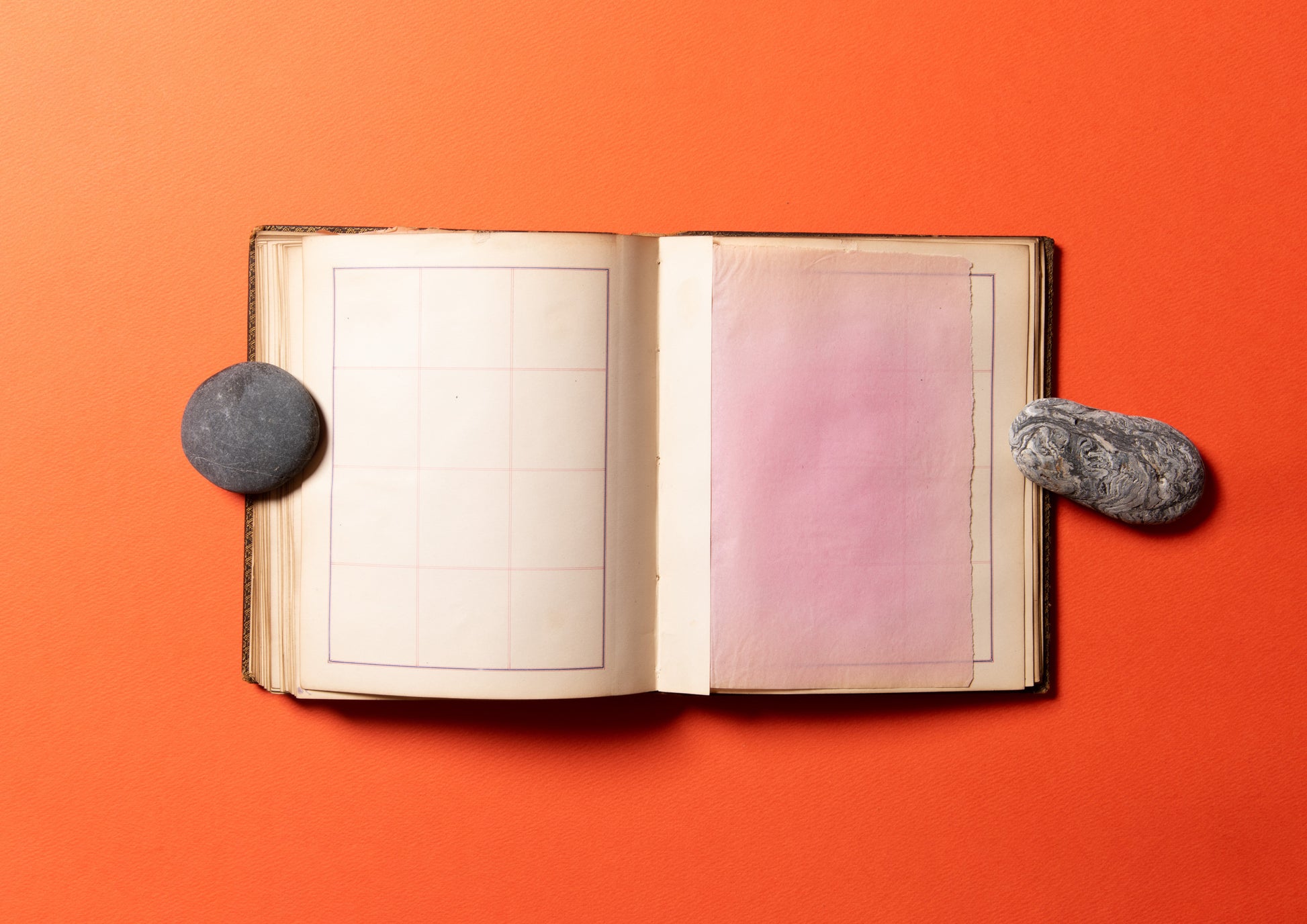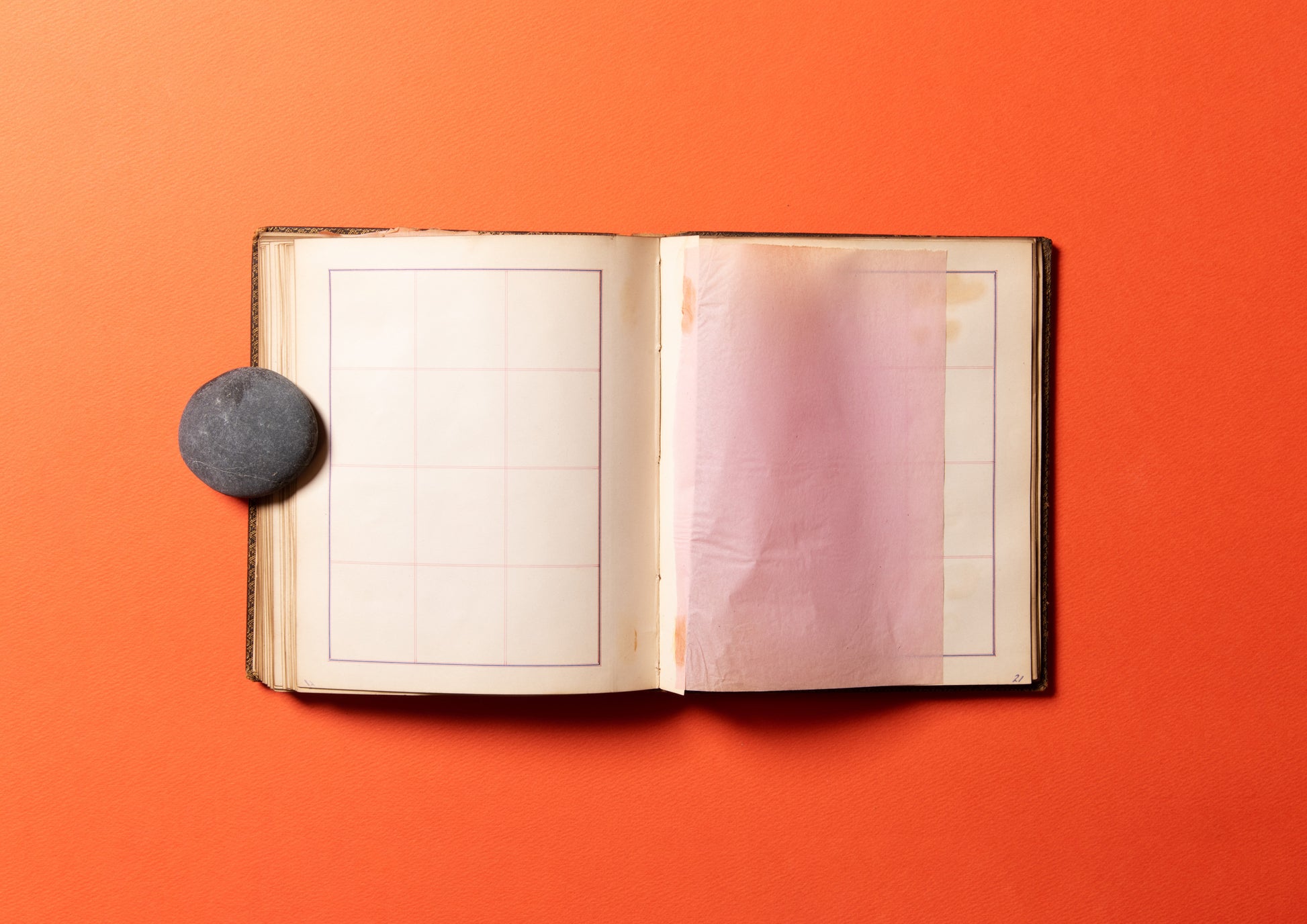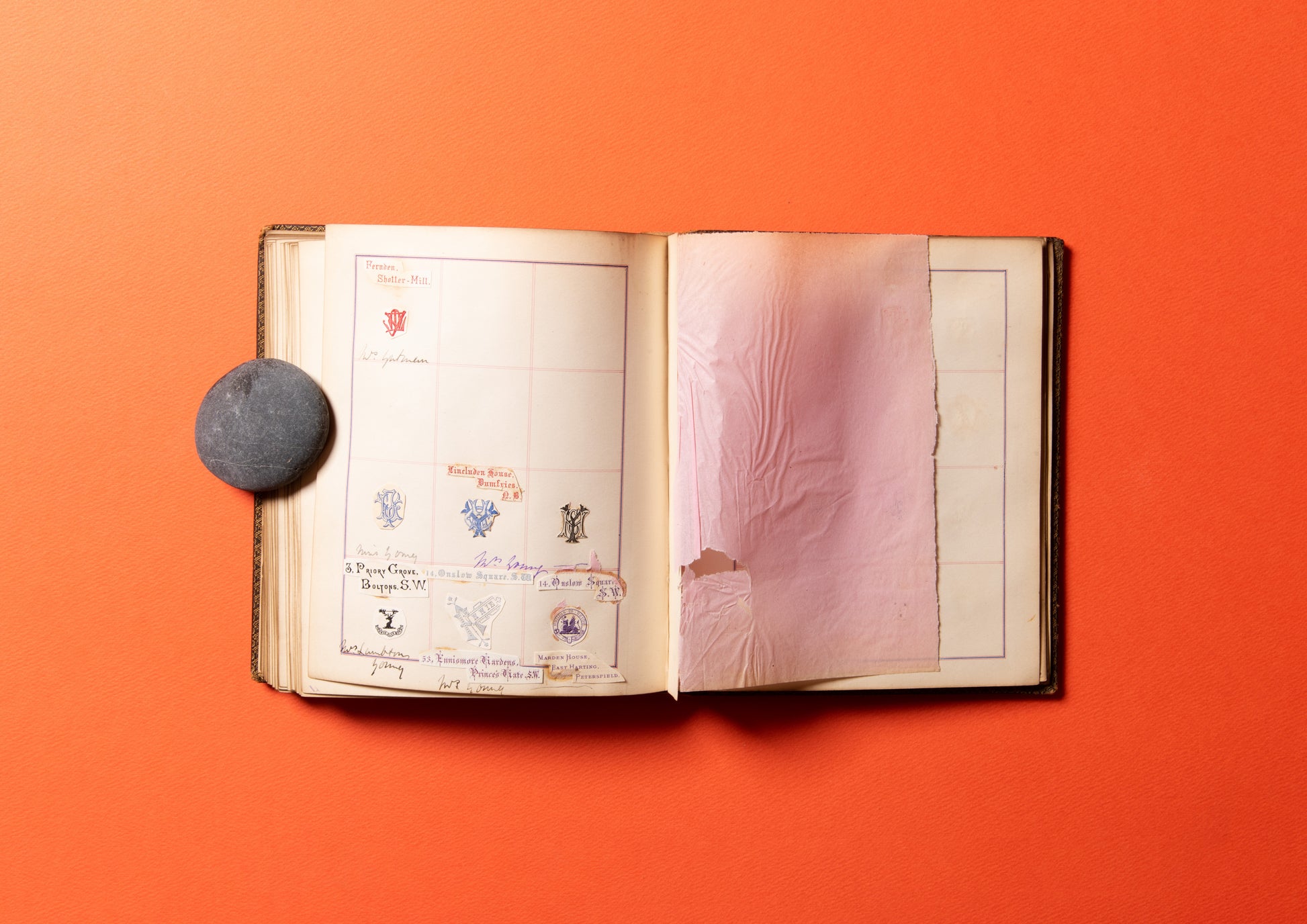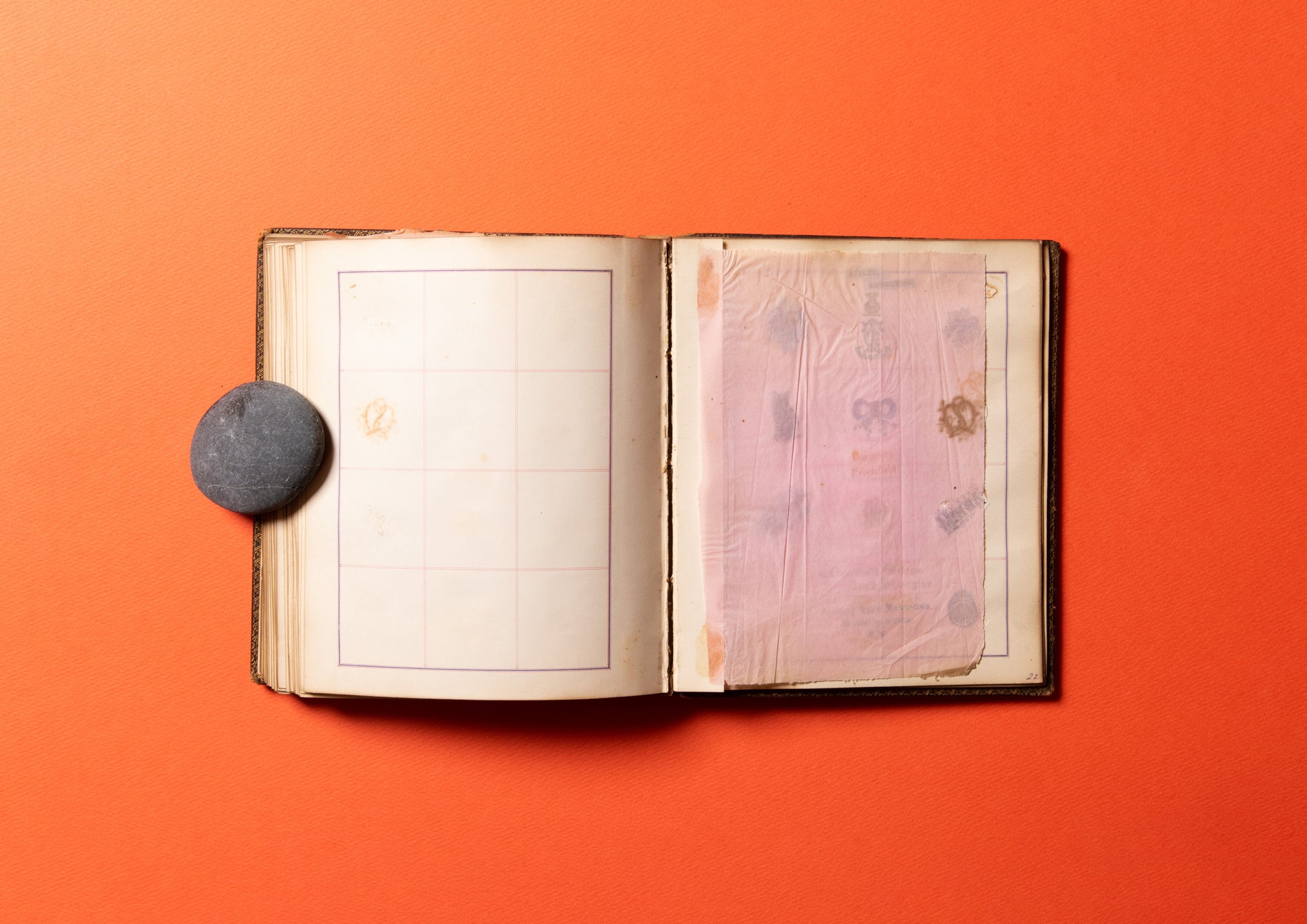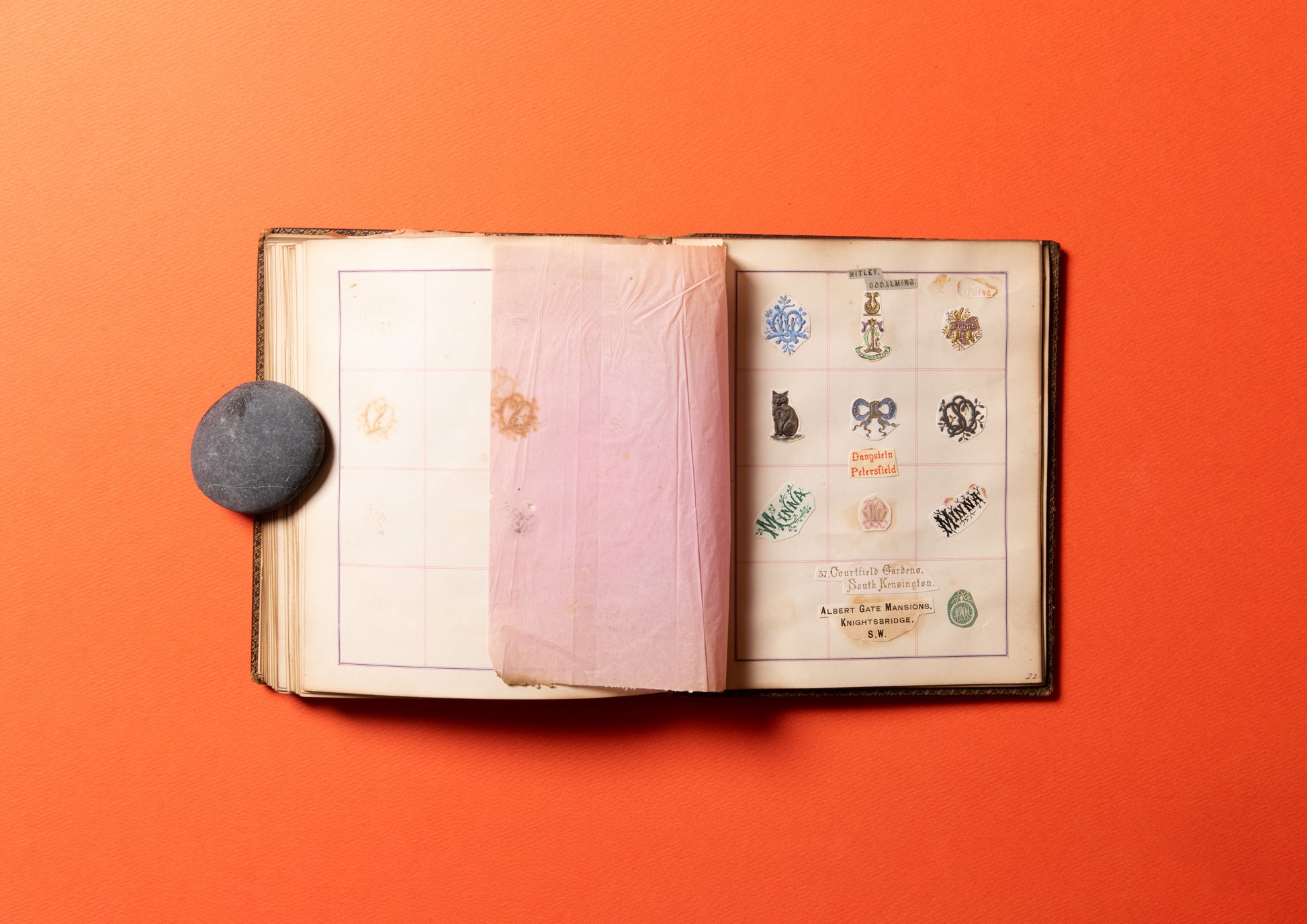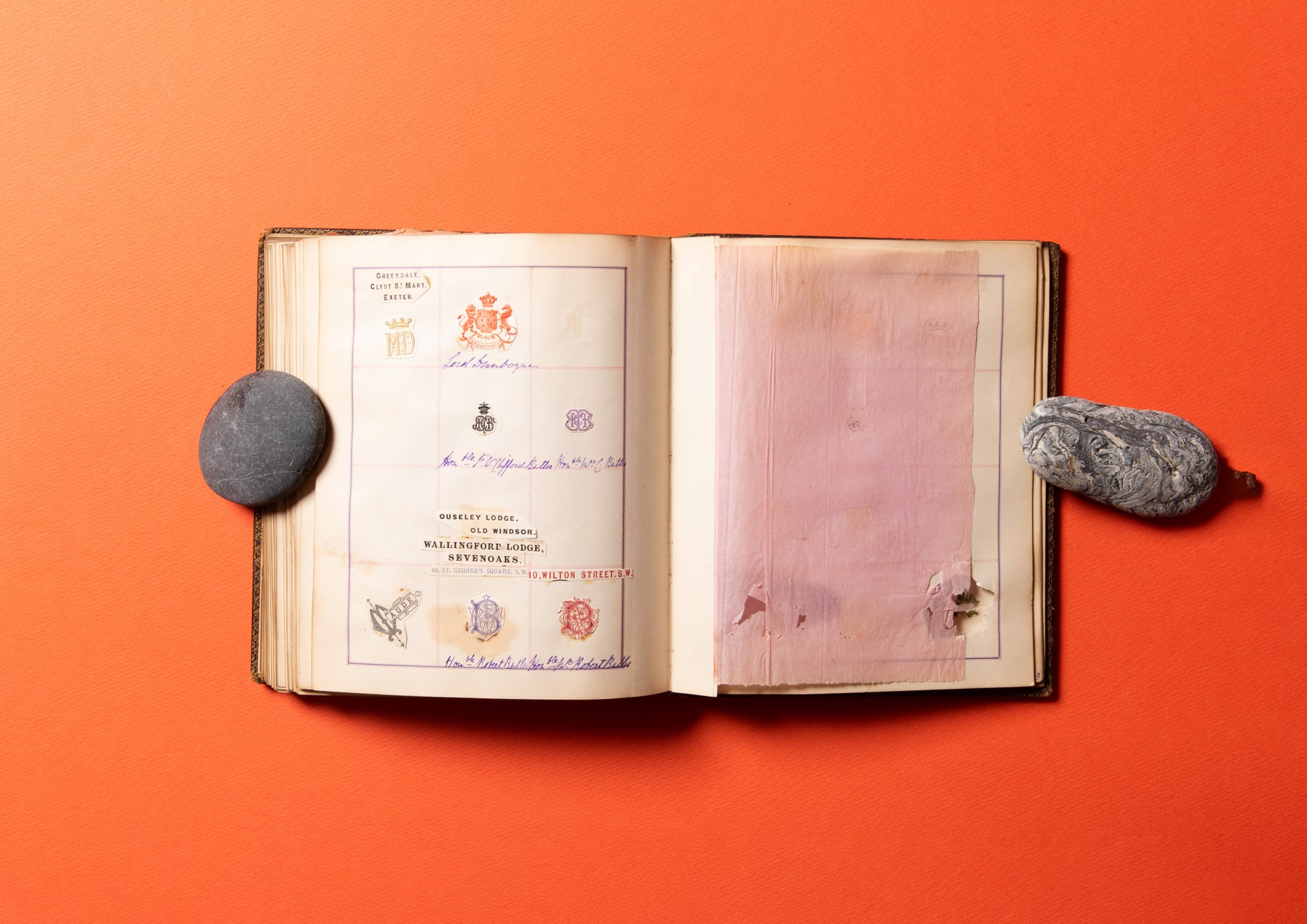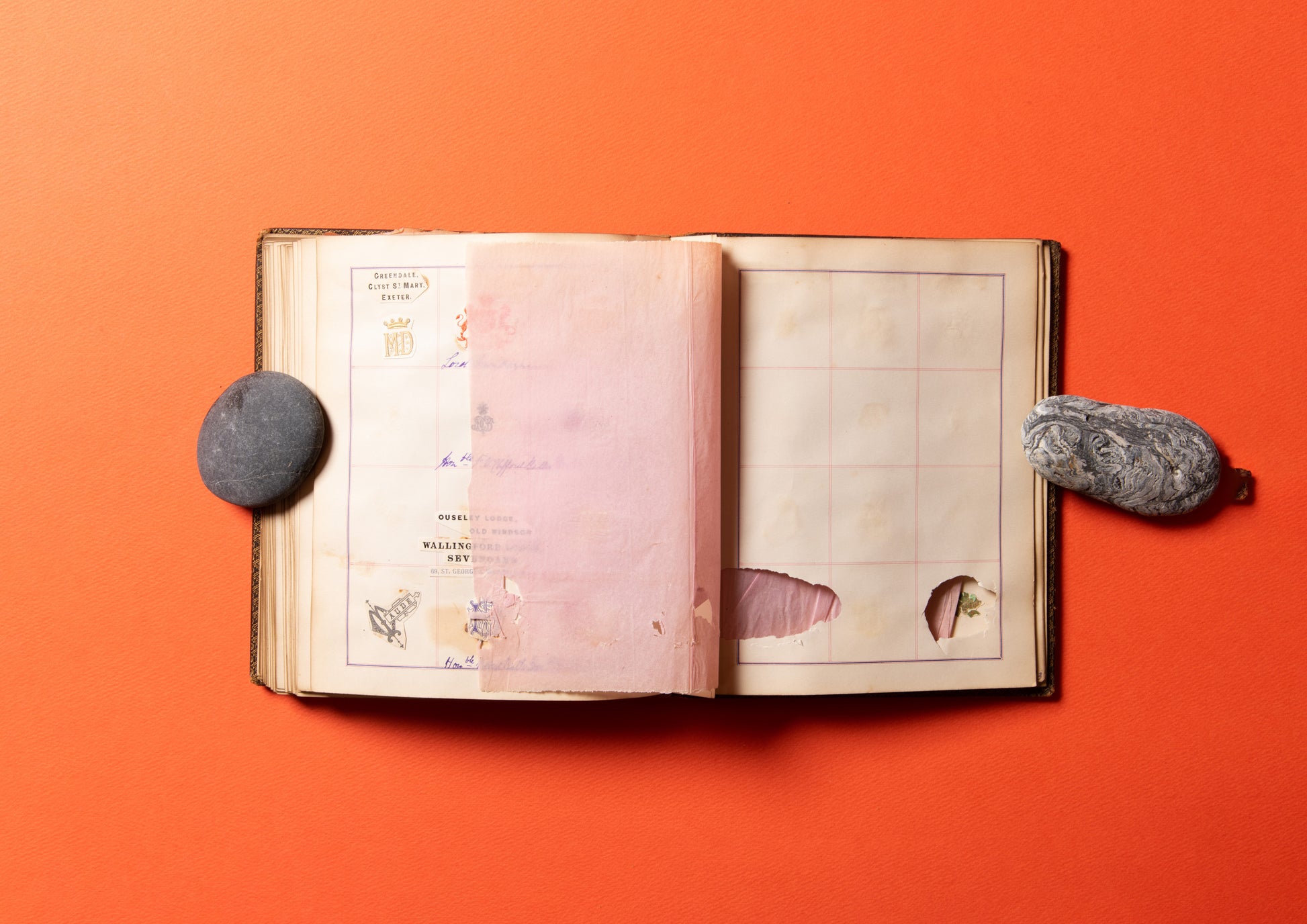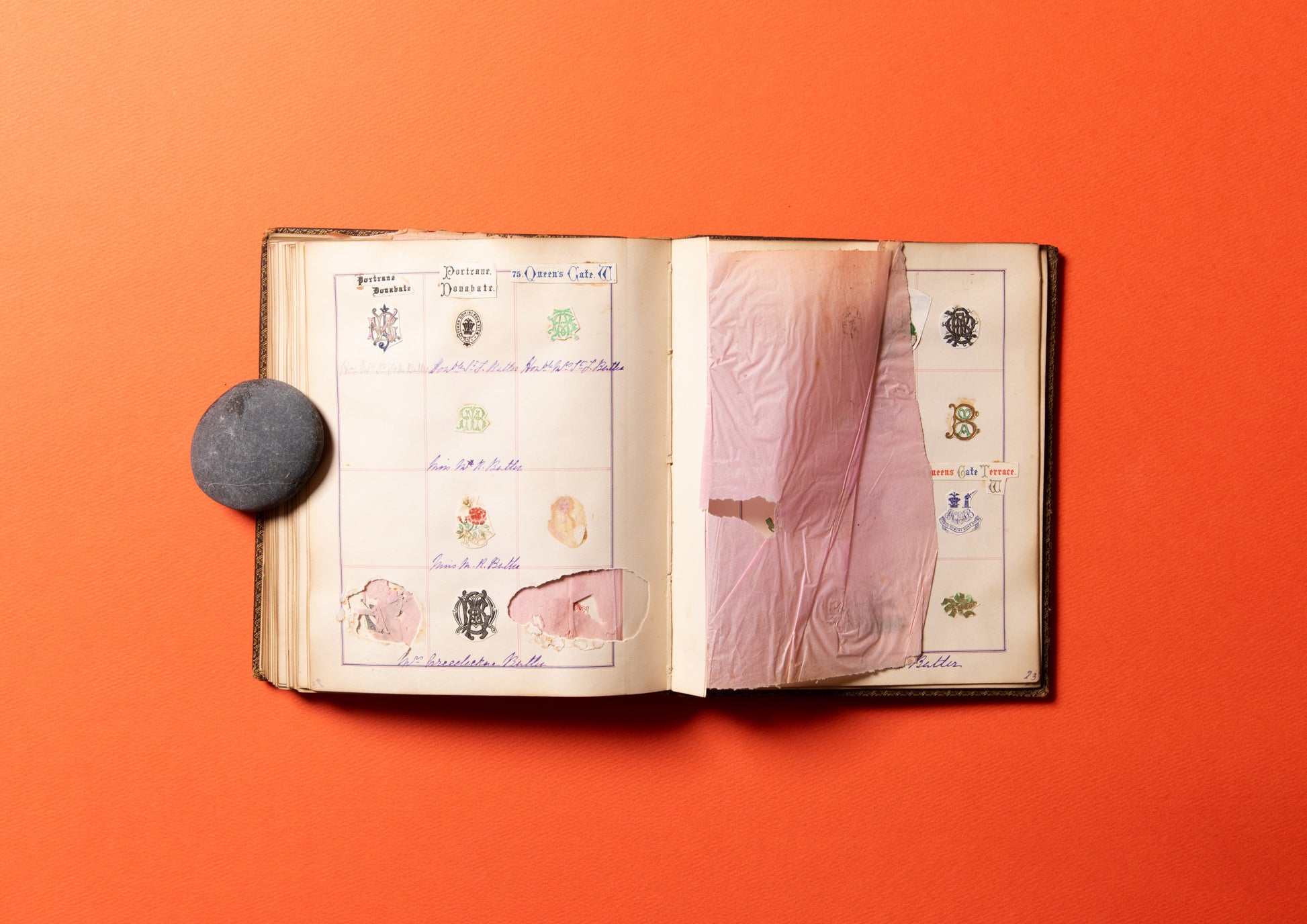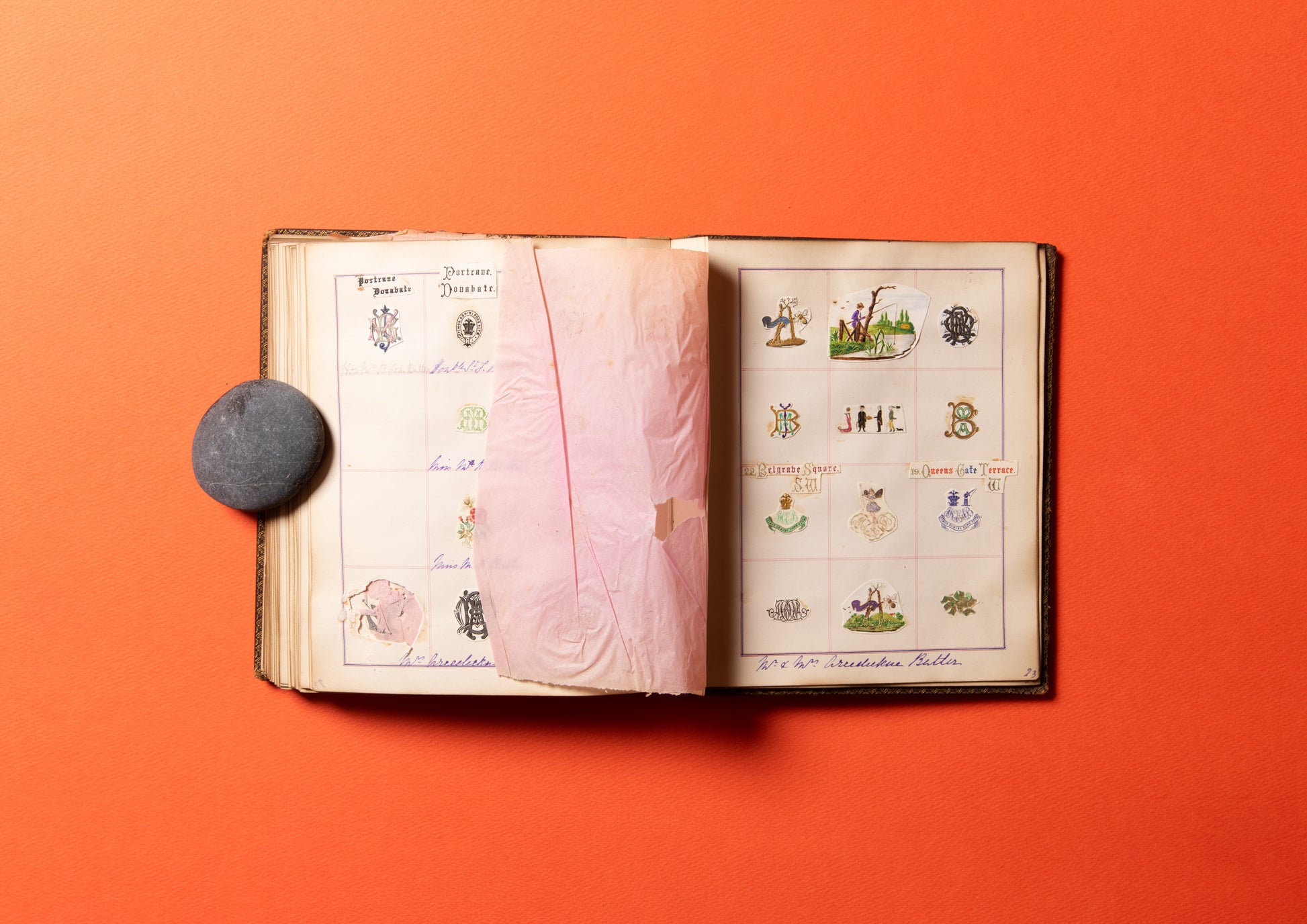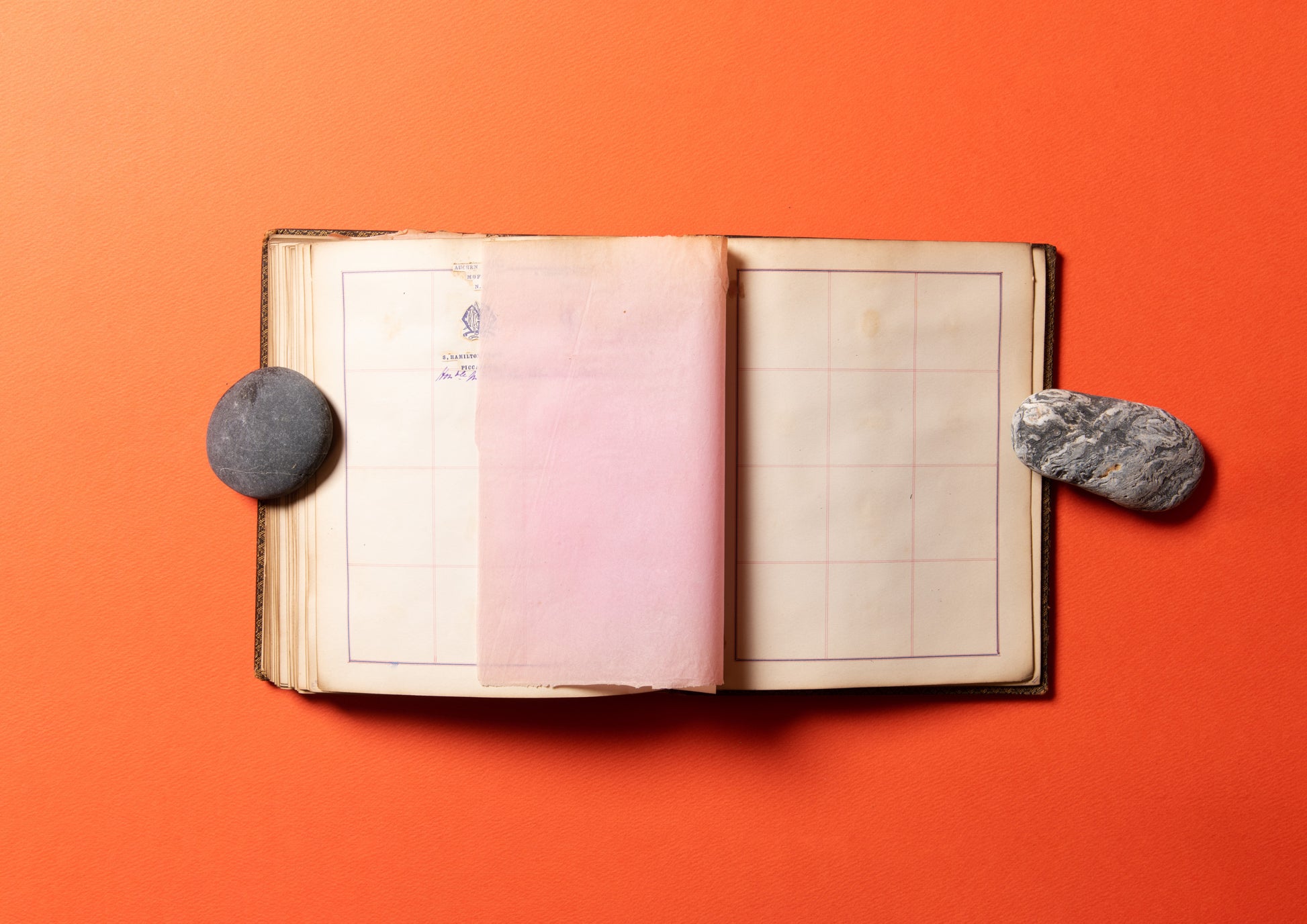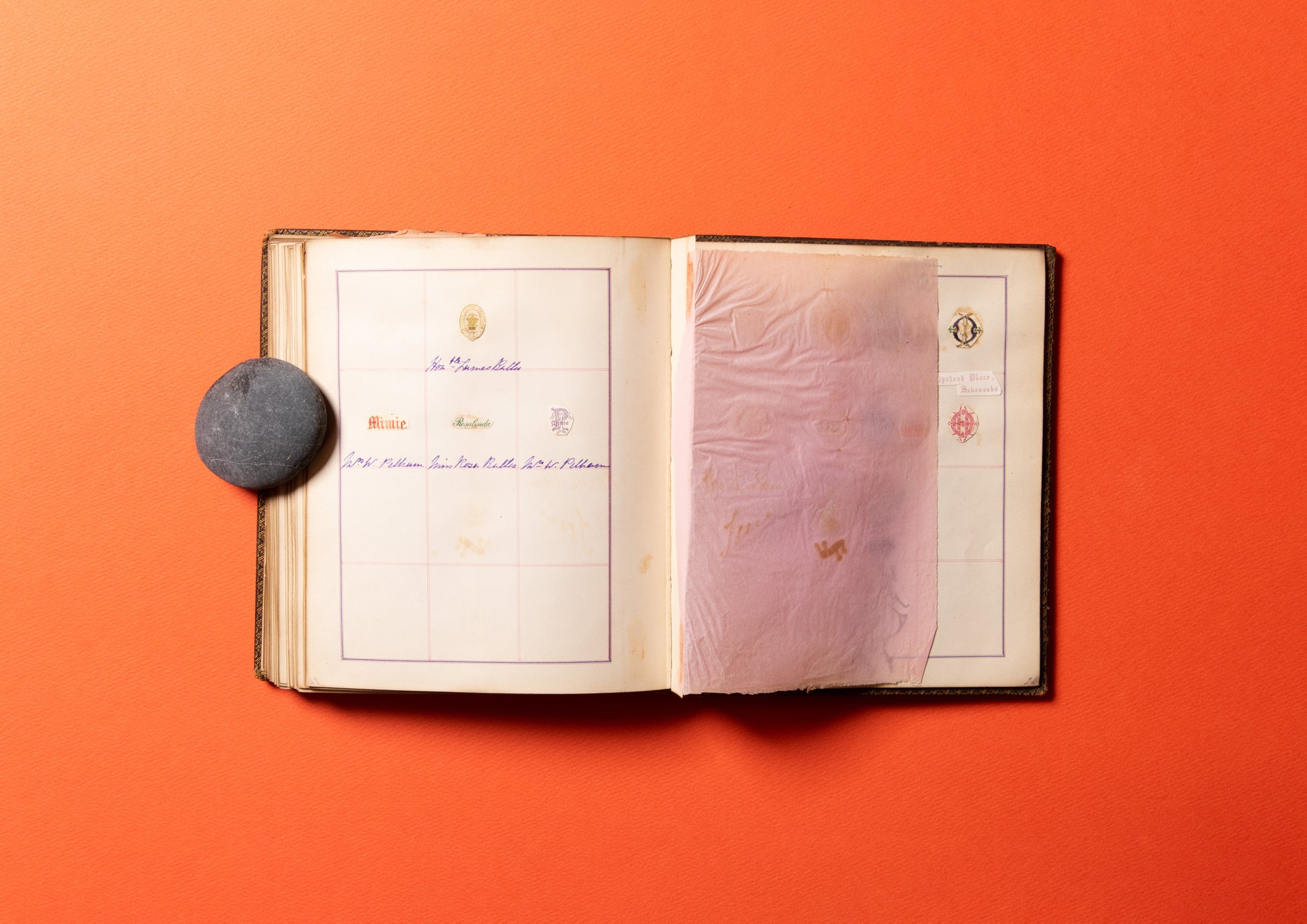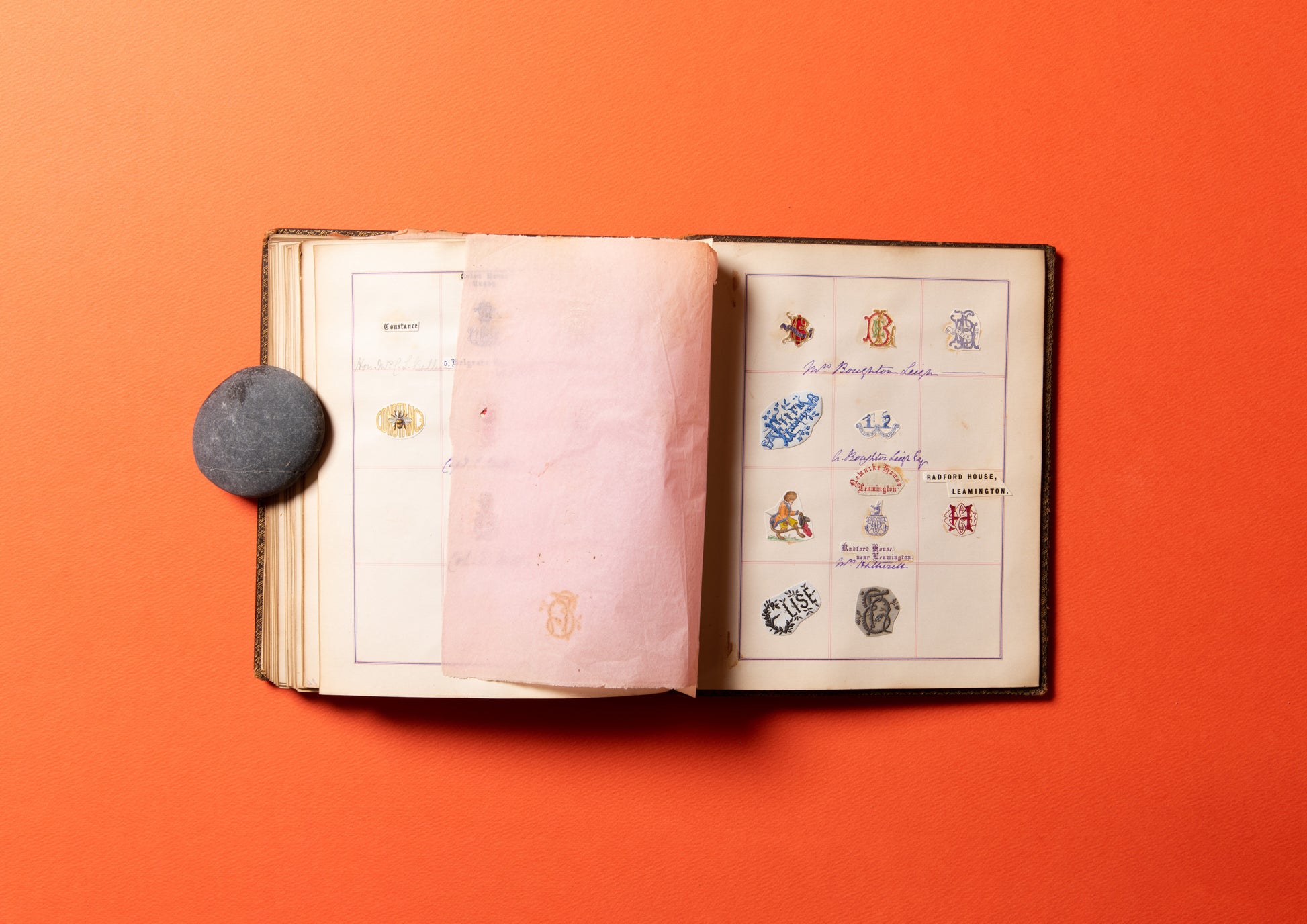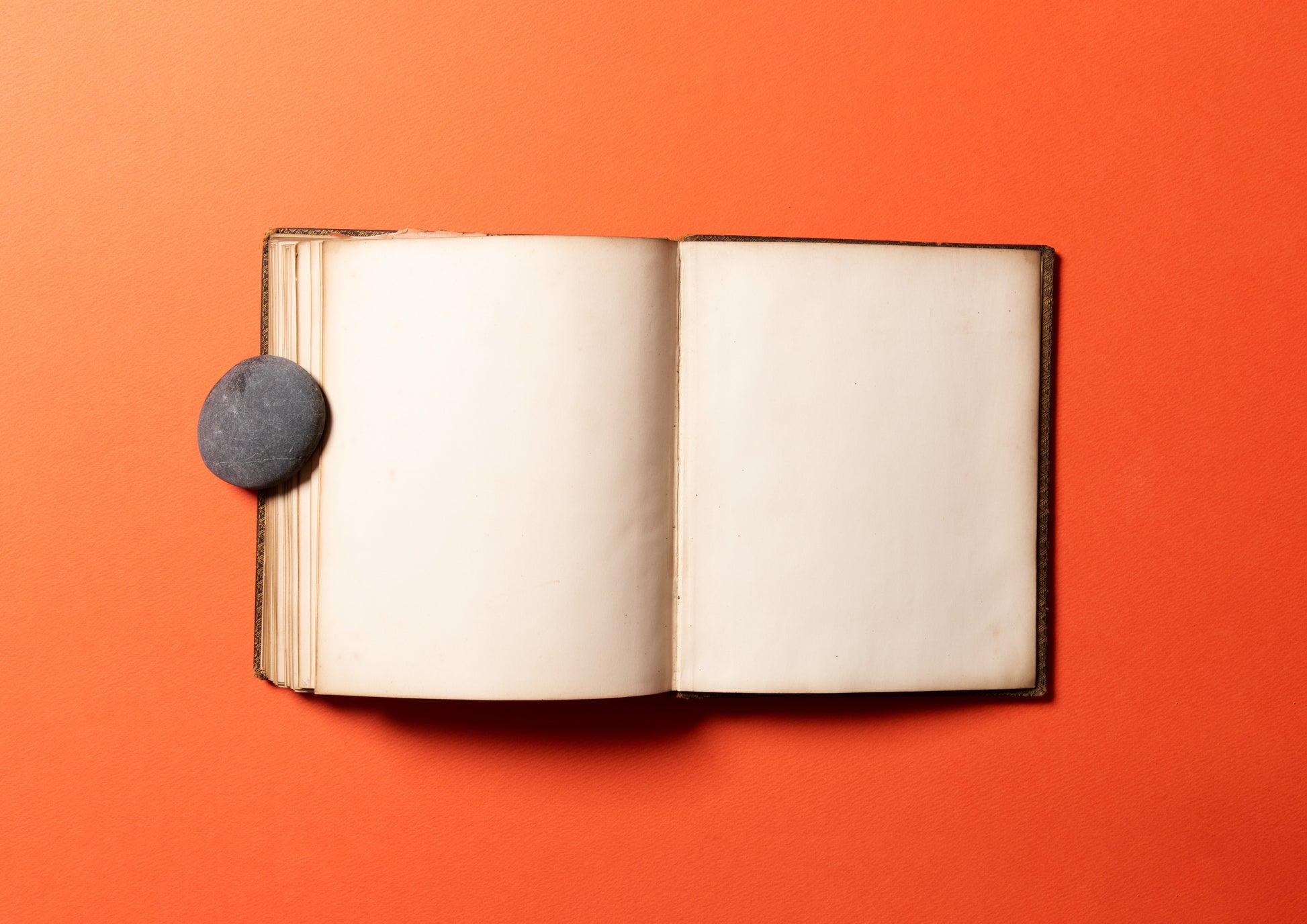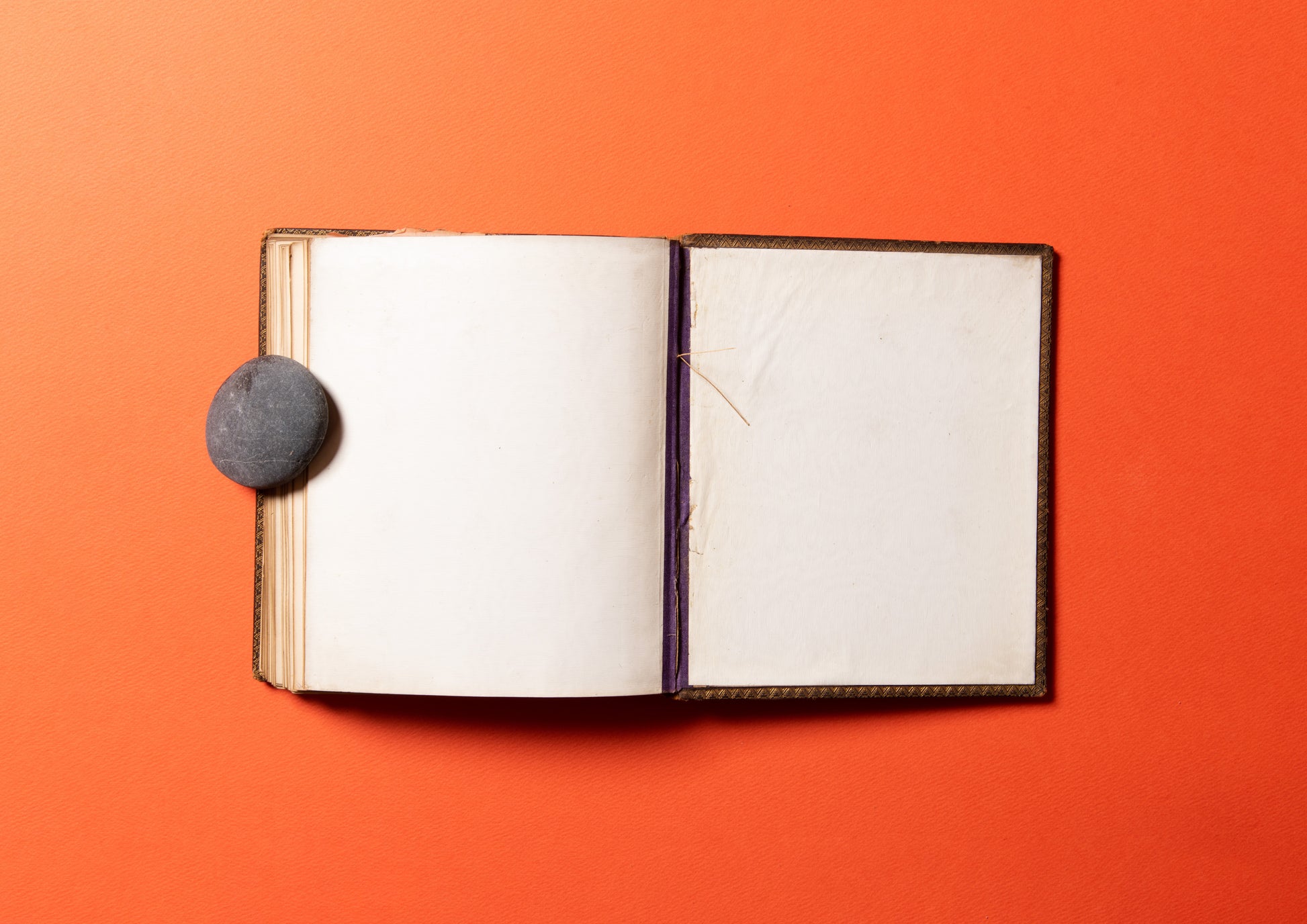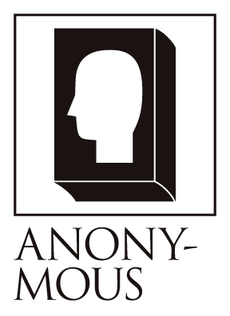Monogram Records
Bibliographic Details
- Title
- Crests, Monograms Etc. / モノグラム手控帖
- Author
- Anonymous / 作者不明
- Year
- Around the end of the 19th or beginning of the 20th century? / 19世紀末~20世紀初頭?
- Size
- h200 × w170 × 35mm
- Weight
- 830g
- Pages
- 100
- Language
- English / 英語
- Binding
- Leather binding, gold on three sides, title in gold, gold lettering, gold wire decoration / 上製革装・三方金 タイトル金文字、金線装飾
- Condition
- Spine is damaged, chips and scratches on thin glassine papers inserted between each page / 背傷有、間紙欠け傷有
Unique private book with 1,000 monograms and crests based on personal names pasted on it, along with a piece of paper with the address. / 個人名に基づくモノグラムや紋章を住所の紙片とともに貼り込んだ私家本
Beginning in Ancient Greece
Monogram's history
The only book in the world.
With Christmas approaching, I wondered which of the items I had purchased this year would be most suitable for this season, and chose this week's "Book of the Week" - a private book with "Crests, Monogram Etc." engraved on the cover. Although it looks like a book, the contents are a notebook with about 1,000 scraps of paper pasted on it, centered around adorable monograms measuring about 1-2 cm square.
Some people may think that monogram is the trademark of the high-end brand Louis Vuitton, but according to the Kojien dictionary, it is a general noun meaning "a design of two or more characters into one character. A set of characters. A united character." Kotobank also mentions its uses, saying "It is used on artworks as a substitute for signatures, and on seals." In fact, I think that the backstamps seen on porcelain are the closest to the monogram design trend contained in this product.
With this impression, when I found the book for sale in a market and opened it, the first thing that came to my mind was that it was a collection of trademarks. There were many cut-out and pasted-in names of London streets that I had heard of, and the way they were pasted in seemed to have meaning, with some pages densely pasted in and others spotted, so I wondered if it was a kind of phenomenological collection book by Kon Wajiro, where the symbol marks of the shops operating in each street and area were collected and organized.!British phenomenology? That's interesting! I thought to myself, having had an epiphany.
When I buy things at the market, especially things I don't know about overseas, I often end up misunderstanding things, which is a problem, or maybe I should say in my case because I'm so careless. "Crests, Monogram Etc." was no exception to this rule. South Kensington and Hampstead pop up on various pages, and the handwritten notes that I had ignored, thinking they were just scribbled, seemed to be in alphabetical order... Oh dear, alphabetical order? Looking closely at the handwriting on the notes, I realized that it was Mrs.? This one was Lady? After calming down a bit, I realized that it was a reminder to link individual names with monograms, or in other words, a list of names.
If I had to choose, I would have liked it to be a London anthropology. Because that would be interesting. A list of names, eh? Isn't that a bit cliche? No, but. But what do you think?
Of the approximately 1,000 pieces of paper, about 550 are stylized monograms or crests. The rest are scraps of addresses written in various fonts and with ornate decorative characters. Judging from the texture of the paper and the information they contain, they are likely cut from business cards, letterheads, or envelopes that were originally made for individuals. Almost all of the collected addresses, including the monograms and crests, are embossed. In other words, they must have been made from original molds. Many of them are multicolored, and even though they are scraps of paper, they are all luxurious. The binding, which is thought to have been ordered by the former owner, has a modest height but a gold wire in the center of the spine band, thick gold wire on the front and back covers, and gold decorations from the thick part of the wood edge to the endpapers, giving the book a modest overall impression, but the finish is elegant and well-thought-out down to the smallest details. Naturally, it seems safe to assume that the previous owner was either a member of the upper class or served such a family. There are many personal lists, but it is rare to find one with such an elaborate paper and packaging? ... I am not familiar with the antique market and the upper class in Europe and the United States, so I must refrain from making any definitive statements on this point, but it is certainly true that it is rare to see such a thing in Japan. And many of the monograms and coats of arms use not only letters but also animals, plants, and mysterious characters as motifs, so they are simply fun to look at, and seem to be useful for something, regardless of the stiffness that I have mentioned in detail. From a gothic taste to a silly character style, it seems possible to use them as a design source.
Of course, if someone has a personal monogram or coat of arms and is in the habit of using lavish original printing, they must be from the upper class or newly wealthy. I tried a few names that came to mind, such as Churchill or Doyle, but I ended up with no luck. However, when I searched for the surname Bressey, which is listed with many names including Mr., Mrs. and Miss, I found a man named Lord Bressey, who is known for his research on road planning in London. If you have the strong handwriting of English cursive and the will to patiently match it, you may be able to discover the name of an incredible person. There is still plenty of possibility.
There are some products whose value varies greatly depending on how you look at them and what you find in them. When buying products without knowing how much they will turn out to be, but on the assumption that they may turn out to be something new, secondhand bookshops often use the phrase "buying a dream." I see, possibilities are what dreams are! In the case of this product, the dream part of a secondhand bookshop is that it could be "an anthropology of London" or "Churchill could be in it," but so far the only value I have been able to assess is the design element. It was nowhere near my dream.
The continuation of the dream is now in the hands of the next person. I hope to be able to give it to them as a Christmas present.
Well, this will be the last of my 2022 posts. I would like to express my sincere gratitude to all the readers who have been with me every time, and to FRAGILE BOOKS for giving me this opportunity. On a personal note, from 2023 I have decided to leave my store in Omotesando and set up a small workspace a little further away from the city center. The work will remain the same as before, but I will be a little more flexible. Now that I am more flexible, I hope to be as mobile as possible, get involved in various places, and find interesting things. Thank you very much for 2022. I look forward to your continued support in 2023.
Text by Masago Sato
Footnote
What did you think of Sato Masago's masterpiece? For FRAGILE BOOKS, the fragile voyage that set sail this year was an experience that felt like exploring with Masago for treasures lying at the bottom of the ocean of information. But becoming a used book gambler like Masago is no easy feat. To dig up a gold nugget, in addition to luck, you need a unique nose for "there's probably something there" and the knowledge to back it up. Masago is truly a genuine book hunter. And he's known for his work that no one else knows about.BooksProfessional.
Now, let me add a little bit to what Masago said about this solitary copy of "Monogram."
The first monograms in history date back to Ancient Greece, where a symbol combining the Greek letters "Chi Rho" (looking like "X" and "P") of Jesus Christ appeared around 350 BC.
Later, in the 6th century, local rulers in ancient Rome began to use the monogram on their coins, and in the 8th century, Charlemagne began to use the monogram widely to represent his power over the lands he conquered. Charlemagne was a king who unified almost all of Western Europe, and is the model for the King of Hearts in playing cards. It is the only picture card of a king without a moustache.
From then on, monograms became a standard style for royalty and military personnel to display their power, but during the Victorian era (1837-1901), they became popular among the general public, appearing on everything from parasols to baby carriages, shawls to military uniforms.
In the first half of the 20th century, monograms became even more part of fashion. They were imprinted on stationery, bed linens, and guest towels, and became all the rage. The reason for this was that customizing a single symbol by overlapping or combining two or more letters represented a family symbol. It became popular for couples getting married or engaged to use two- or three-letter monograms that combined their initials on wedding invitations and embroidered items for their new home. This also extended to wedding favors, children's clothing, and baby products.In fact, the traditional design of a monogram is designed to make the family name appear larger than the first or middle name.
That is why the book that Masago unearthed looks like a ledger; it was probably a book that served various families and local merchants on the streets of London from the late 19th century to the early 20th century.A seal maker?It was probably a book that had been carefully passed down through generations at an embroidery shop or gift workshop. It may be interesting to compare the monogram culture, which is still alive today as a classic fashion, with Japanese family crests. When you think about it, even the fact that Louis Vuitton's monogram pattern features a "star in a circle" mark inspired by the Japanese Shimazu family crest, may be a good opportunity for Japanese people, for whom family crests are becoming less important, to reexamine family symbols. MonogramSeal carvingI think I'll make it.
FRAGILE BOOKS by Osamu Kushida
